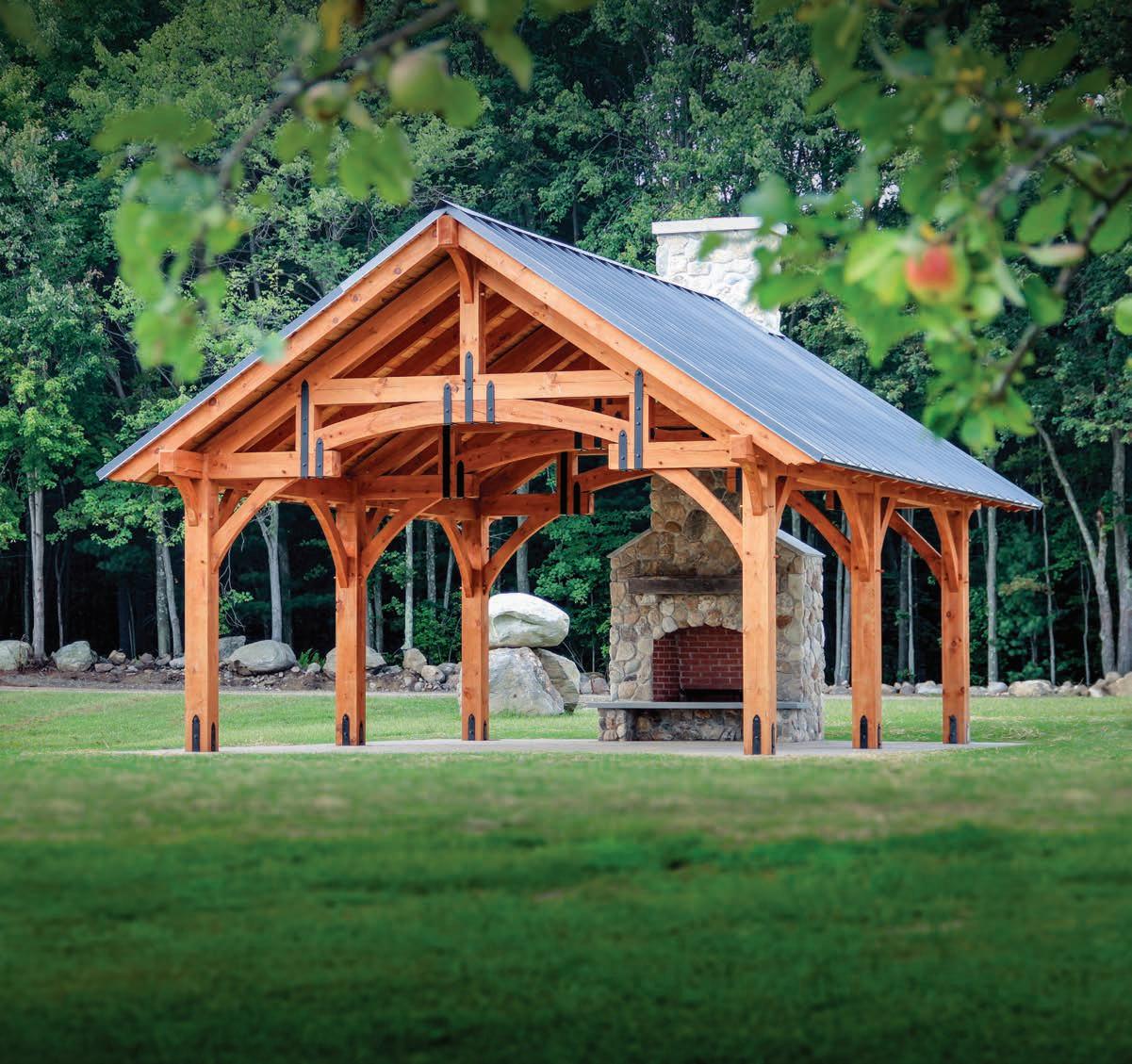


























A SPECIAL REPORT ON THE NEW ENGLAND ENVIRONMENT, STARTING ON P. 83

New England was built on the coast. Its fate will depend upon how well we adapt to a future that can no longer be denied.
As Vermont scholars from very different eras, George Perkins Marsh and Bill McKibben share common ground in trying to save the planet.
By Leath Tonino and Richard ConniffA look at some of New England’s most memorable contributions to the conservation movement, from Walden to Project Puffin.
From the heart of moose country, a story about who wins and who loses in our rapidly changing climate.
By Cheryl Lyn DybasNature photographer Jerry Monkman creates art that’s also a call to action.
Meet the women of the most dominant college athletic program in the nation, which has galvanized the state of Connecticut for two decades. By
 Mike Stanton
Mike Stanton







Travel along the epic route forged by Lewis & Clark in complete comfort aboard our elegant new riverboats. Each stop along this captivating journey has its own story, embodied in the history, culture, and beauty of the region. Enjoy award-winning onboard enrichment programs. Small Ship Cruising Done Perfectly®
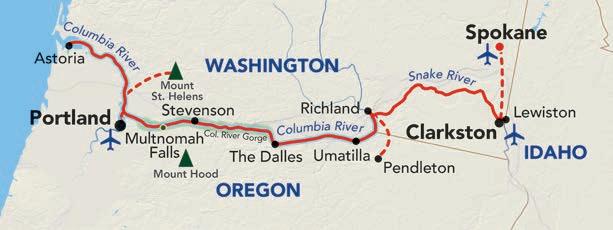

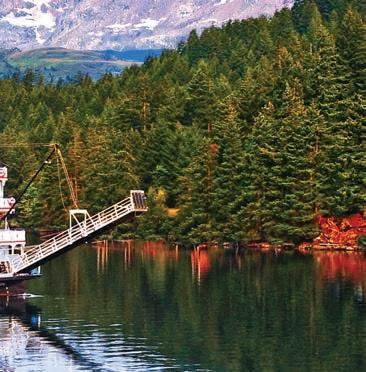



departments
10
12
INSIDE YANKEE
32 ///

New Hampshire’s Bre Doucette finds interior design solutions outside the box. By Annie Graves
40 /// Open Studio
Creativity takes wing in the colorful bird carvings of Maine artist Roland LaVallee. By Annie Graves
46 /// House for Sale
On Maine’s Blue Hill Peninsula, a pondside cottage holds a century of family memories. By Mel Allen
50 ///
Senior food editor Amy Traverso gives a sneak peek at the delicious destinations featured on season 2 of our TV show, Weekends with Yankee.
60 ///
In her debut column for Yankee, contributing editor Krissy O’Shea celebrates spring on her family farm with a pickled rhubarb and farro salad.

64 /// Could You Live Here?
Small but sophisticated, the river town of Exeter, New Hampshire, feels like a crowd-pleasing coastal retreat ... without the crowds. By Annie Graves
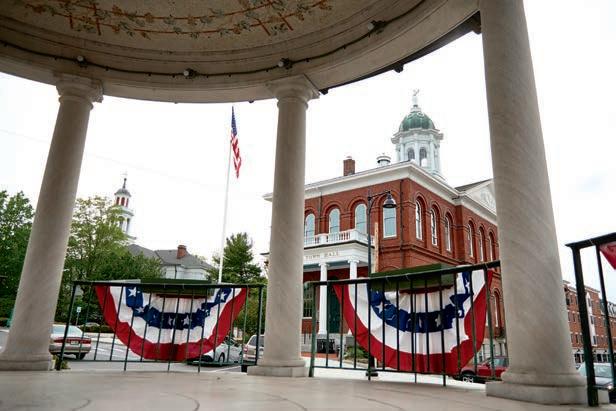
74 /// The Best 5
Visiting these lush indoor gardens will banish the last of your winter blahs. By Kim Knox Beckius
78 /// Out & About
From maple sugaring to sheepshearing, we round up New England’s signature events of the season.
It’s high time to channel our inner Paul Revere.
14
MARY’S FARM
Praying for an ancient barn at winter’s end. By Edie Clark
16
Where the local camaraderie is as important as crossing off your shopping list.
By Ben Hewitt22
FIRST LIGHT
Embracing spring in an armload of fresh-picked tulips. By Steven Slosberg
28
KNOWLEDGE & WISDOM
A primer on racking up “Yankee Points,” life advice from novelist John Irving, and marathon legend Joan Benoit Samuelson’s eye-opening stats.
30
ASK THE EXPERT
How to find joy in Mudville.
144
TIMELESS NEW ENGLAND
Rachel Carson’s love affair with the Maine coast.



1121 Main St., P.O. Box 520, Dublin, NH 03444. 603-563-8111; editor@yankeemagazine.com
EDITORIAL
EDITOR Mel Allen
ART DIRECTOR Lori Pedrick
DEPUTY EDITOR Ian Aldrich
MANAGING EDITOR Jenn Johnson
SENIOR EDITOR/FOOD Amy Traverso
HOME & GARDEN EDITOR Annie Graves
ASSOCIATE EDITOR Joe Bills
PHOTO EDITOR Heather Marcus
SENIOR PHOTOGRAPHER Mark Fleming
DIGITAL EDITOR Aimee Tucker
DIGITAL ASSISTANT EDITOR Cathryn McCann
CONTRIBUTING EDITORS Kim Knox Beckius, Edie Clark, Ben Hewitt, Krissy O’Shea, Julia Shipley
CONTRIBUTING
PHOTOGRAPHERS Julie Bidwell, Kindra Clineff, Sara Gray, Corey Hendrickson, Joe Keller, Joel Laino, Jarrod McCabe, Michael Piazza, Heath Robbins, Carl Tremblay
PRODUCTION
PRODUCTION DIRECTORS David Ziarnowski, Susan Gross
SENIOR PRODUCTION ARTISTS Jennifer Freeman, Rachel Kipka
DIGITAL
VP NEW MEDIA & PRODUCTION Paul Belliveau Jr.
DIGITAL MARKETING MANAGER Amy O’Brien
YANKEE PUBLISHING INC.
established 1935
PRESIDENT Jamie Trowbridge
EDITOR-IN-CHIEF Judson D. Hale Sr.
VICE PRESIDENTS Paul Belliveau Jr., Jody Bugbee, Judson D. Hale Jr., Brook Holmberg, Sherin Pierce
CONTROLLER Sandra Lepple
CORPORATE STAFF Mike Caron, Linda Clukay, Nancy Pfuntner, Bill Price, Sabrina Salvage, Christine Tourgee
BOARD OF DIRECTORS
CHAIRMAN Judson D. Hale Sr.
VICE CHAIRMAN Tom Putnam
DIRECTORS Andrew Clurman, H. Hansell Germond, Daniel Hale, Judson D. Hale Jr., Joel Toner, Cor Trowbridge, Jamie Trowbridge
FOUNDERS
ROBB & BEATRIX SAGENDORPH
PUBLISHER Brook Holmberg
ADVERTISING: PRINT/DIGITAL
VICE PRESIDENT/SALES Judson D. Hale Jr.
SALES IN NEW ENGLAND
TRAVEL, NORTH Kelly Moores KellyM@yankeepub.com
TRAVEL, SOUTH Dean DeLuca DeanD@yankeepub.com
TRAVEL, WEST David Honeywell Dave_golfhouse@madriver.com
DIRECT RESPONSE Steven Hall SteveH@yankeepub.com
SALES OUTSIDE NEW ENGLAND CANADA Françoise Chalifour, 416-363-1388
ADVERTISING: TELEVISION
NATIONAL WNP Media, 214-824-9008
AD COORDINATOR Janet Selle
For advertising rates and information: 800-736-1100, ext. 204 NewEngland.com/adinfo
MARKETING
ADVERTISING
DIRECTOR Kate Hathaway Weeks
MANAGER Valerie Lithgow
ASSOCIATE Holly Sloane
CONSUMER
MANAGERS Kate McPherson, Kathleen Rowe
ASSOCIATE Kirsten Colantino
NEWSSTAND
VICE PRESIDENT Sherin Pierce
MARKETING MANAGER Stacey Korpi
SALES ASSOCIATE Janice Edson
SUBSCRIPTION SERVICES
To subscribe, give a gift, or change your mailing address, or for other questions, please contact our customer service department:
Online: NewEngland.com/contact
Phone: 800-288-4284
Mail: Yankee Magazine Customer Service P.O. Box 422446 Palm Coast, FL 32142-2446


















































































Travel: Best Spring Events in New England


From maple sugaring in March to antiquing in May, here’s what’s worth the trip.
NEWENGLAND.COM/ SPRING-EVENTS




Holidays: Classic Easter Dishes
We round up great brunch, lunch, and dinner ideas for your Easter table from the Yankee archives.
NEWENGLAND.COM/ EASTER-RECIPES
Recipes: Easy Corned Beef and Cabbage
Our go-to recipe is simple, flavorful, and full of Saint Patrick’s Day tradition.
NEWENGLAND.COM/ CORNED-BEEF
Food: Guide to New England Pancake Houses
Favorite regional eateries serve up the pancakes and maple syrup you crave.
NEWENGLAND.COM/ PANCAKE-HOUSES
This is, well, I’m not sure I have the words for what this is. I’ve never been on a ship like this before. The world looks so different from here. But it’s awesome. And the crew is showing me all kinds of stuff — how to raise the sail, read a map, sing songs. They call the songs sea shanties, or something like that. One of the guys told me I had a great voice. Hmmm. This ship will always be a part of who I am. This is me.














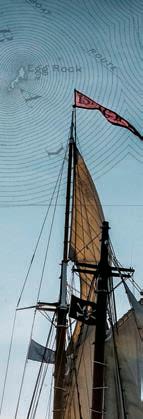
























































































































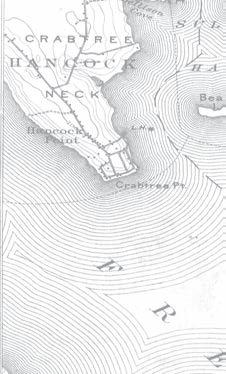
TRISTAN SPINSKI


In creating photographs for “Rising Seas” [p. 84], Spinski veered away from the “mythic, ominous landscapes” that usually illustrate climate change. Instead, he looked for scenes with a more familiar, everyday feel—because “if we can recognize these places,” he says, “we realize what’s at stake.” A regular , Mother Jones, and The New , Spinski lives in South Portland, Maine.
LEATH TONINO
George Perkins Marsh [“Two Voices, One Message,” p. 92] was a natural fit for Tonino, who’s long been obsessed with the history of environmental thought. “To look at how we understand our relationship to the planet, you’d best look at Marsh. And the fact that he’s a Woodstock boy—well, that’s just awesome,” says the Vermont-born Tonino, whose first book, The Animal 1,000 Miles Long, is out this summer.
MAAIKE BERNSTROM
Bernstrom’s photographs of a pick-your-own tulip farm [“Plucky Sorts,” p. 22] represent something of a family affair: Her father wrote the accompanying story, and her daughter tagged along on the shoot (“The biggest challenge was keeping her from picking all the tulips!”). From her home in Rhode Island, Bernstrom stays busy shooting for everyone from Vineyard Vines to Rhode Island Monthly.
JERRY MONKMAN
“My job is simple: I like to play outside, taking videos and pictures that help conserve wild places in New England,” says Monkman, who’s based in New Hampshire. Trying to distill his 25-year career into a handful of images [“Beyond Beauty,” p. 110] was, in a word, “painful.” But he says it was enlightening, too: “It was interesting to see how my work seems to reflect the different periods in my life over that time.”
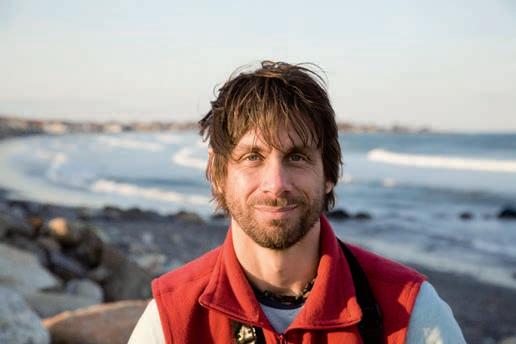
Shown, from left, with photographer Steven G. Smith, Stanton brings a champion’s pedigree to the story of UConn women’s basketball [“Team for the Ages,” 120]. He shared in a Pulitzer for investigative reporting while working at The Providence Journal and penned the best-selling book The Prince of Providence, about ex-mayor Buddy Cianci. These days, he teaches journalism at UConn and lives outside Providence.

CHERYL LYN DYBAS

A veteran ecologist and science journalist, Dybas may reside in Washington, D.C., but she left her heart in New England, where she lived for over a decade. In addition to “walking a mile in their hoofprints” for her feature about New England’s moose [“Ghosts of the Northern Forest,” p. 104], she’s written widely about science and nature for the likes of National Geographic, Smithsonian , and The Washington Post.

On opening your January/February issue, I was brought to tears reading “Leaving Mary’s Farm” [about columnist Edie Clark’s good-bye to her New Hampshire homestead]. I then turned to Edie’s essay “Night Sky.”
I remembered an event from a few months ago, a severe storm that knocked out power for all of Cape Elizabeth—something that hadn’t happened even during the infamous ice storm. At one point, I opened the front door and was dumbstruck by the brilliance of the stars in the night sky. In the 30 years I have lived here, I had never seen the cape completely dark.
How lucky for Edie that she was able to have so many nights with that blessing just outside her front door. God bless Edie and Yankee for sharing Mary’s Farm with us for all these years. Ann Patch Cape Elizabeth, Maine
I live in South Portland, Maine, and my mother, who lives in Connecticut, sends me a subscription to Yankee every year. I called to talk to her on her birthday this week, and she asked if I had seen the new issue and if I’d ever been to the Holy Donut in Portland (of course I have!). I decided to bring her a few samples for her birthday, and we thought you’d like to see the results.
 Stephanie and Barbara McSherry
Stephanie and Barbara McSherry

April showers get our goats, Launching everything that floats.

Even gators in the moats
Purchase plastic overcoats.








I thoroughly enjoyed reading “A Movable Forest” [November/ December] by Julia Shipley and Joe Keohane. My mom gets your magazine on a regular basis and passed this article over to me when I came home for Sunday dinner a few weeks ago. Life has been a little crazy recently, but I just got around to reading it this morning and couldn’t put it down.
I’m a native New Yorker who has spent every summer since birth in Spofford, New Hampshire. I recently purchased an apartment in Ditmas Park, Brooklyn, and have lived here for the past year and a half. When I read the story of the Christmas tree farmers and their connection to my current neighborhood, it made me feel all of the warm, fuzzy holiday feelings. It also connected with me on a spiritual level. As a Christian woman, I appreciated the sharing of the farmers’ personal faith story. Thank you!
Rebecca Wells Brooklyn, New York





y son Josh was born on Earth Day 1988, and he grew up with a love of natural places seemingly imbued by fate. I mention him here because it is his generation and the ones that follow that will judge how we have treated this planet. This year Earth Day will be observed on Sunday, April 22, in nearly 200 countries, and we will watch on our TVs and on our computer screens the scenes from rallies warning of a carbon-heavy climate future that seems to become more real by the day.
I write this a week after a “bomb cyclone” in early January battered coastal Massachusetts with frigid waves. We saw gripping photos of firefighters nearly waist-deep in water on Boston’s Long Wharf; we saw images of cars at Gloucester High School encased in floodwaters and ice. Last fall we watched hurricanes lash Texas, Florida, and Puerto Rico and felt relieved we lived here, untouched—and now we were confronted with our own vulnerability. Nobody should be surprised. The climate scientists have warned that over the coming decades, stretching into the next century, New England is poised to suffer some of the biggest temperature increases, the most precipitation, the fiercest storms. So what do we make of it, when it feels as if we just had an unwelcome preview?
I know our readers look to Yankee for beauty, for love of the land, for this region’s traditions and history, and also to meet people from all walks of life who enrich the six states we call home. Yet sometimes the stories that may shake us a bit demand their due—and these are the kinds of stories you’ll find in our special report “Our Land, Our Sea, Our Future” [p. 83]. They show how New England has earned a historic place in the conservation movement [“Two Voices, One Message,” p. 92, and “Green Milestones,” p. 102]; caring about the planet is in our DNA. But they also lay out a cautionary tale in which we all play a part. “Rising Seas” [p. 84] will give you pause. It is meant to. New England was shaped by the sea, and it now must find a way to adapt to what a changing sea may bring.

I believe New England is a place where the world will look for answers to what can seem like unsolvable problems, because many of the greatest minds and innovators live here. They are already designing ways to make a livable future. But we all own a stake in what happens today, tomorrow, 20 years hence. We need to get astride our horses and, like Paul Revere, ride hard and fast, fearless in our warning, driven to spread the truth. Earth days depend on us.
Mel Allen



























Celebrating the annual survival of the kind of barn they don’t build anymore.
’ve been told that the barn behind the house here is older than the house, which dates to 1762. Usually a family builds the house before the barn, though I suppose there are always exceptions, and no one was recording what Benjamin Mason did when he came here from Massachusetts in that forbidding, pre-Revolutionary year. Whatever happened with the house, I know for sure that the barn is older than this nation.
The building is tall, 30 by 45, and built on the ground. Inside, the timbers that support the structure are blond, wide at the top and tapered toward the bottom: gunstock posts made of chestnut. The tenons that connect the posts and the beams are big as corncobs, and they, too, are still light-colored, as if they were hammered in there yesterday.
Stepping into this barn is like stepping into an American history book. In there, I cannot help but think of the men who carved these posts out of trees, which grew, undoubtedly, very near to where the barn now sits. On the ground floor, there are two big windowless box stalls on one side and three smaller ones, each with a window looking east, on the other. In the center is a wide aisle that runs the length of the building—at the ends are doorways broad enough to drive a wagon through, which I’m sure was what happened most every day, the horses harnessed and hitched in the shelter of the barn and then driven out into the field, where hay or corn was picked up and brought back in through the other side. In this barn, roosters strutted, hens pecked, horses snuffled, cows were milked, and hay was thrown aloft. Generations of farmers stamped snow off their boots or wiped sweat from their brows, entering the building where their business took place, every day of the year.
It’s quiet now. Leaning as it does to the north and east, the barn has taken on a poetic profile, the sort that photographers and painters love to capture. Inside, the stalls harbor many things. One stall is piled with a collection of shutters and windows, likely saved from the last renovation, which I believe was in the 1950s. Another has boxes of saved magazines, all of them yellowed and swollen with years of sun and moisture, and yet another has a hodgepodge of old wooden kitchen chairs and an enamel kitchen stove, missing the lids.
Since I bought Mary’s Farm five years ago, I’ve managed well with the house, some months counting out my last nickels in order to get done what needs to be done. But the barn has suffered. I’ve been able to take only two swipes at saving it, more triage than repair: When the wide expanse of the back doorframe began to sag, a metal bar was hastily wedged underneath. And in the corner afflicted with dry rot, we cinched the buckled post back upright using a chain and a come-along, which remain in place. These measures may buy time until I can afford more.
Winters are what bring these structures down. The winds and the heavy snows combine to defeat their heritage. All winter, I look out my window to the barn and say silent prayers. In April, I watch the snow retreat and whisper thanks for another year of mercy.
Because of what the barn has to say, I want it to live another century. I dream of sheep in the stalls, the fragrance of lanolin and hay and manure scenting the aisle, and red-backed chickens in the coop, muttering and squawking and flapping when I walk in with the grain.
This essay first appeared in Yankee’s April 2003 issue. Edie Clark’s books are available at edieclark.com.







A great country store offers far more than just things to buy.
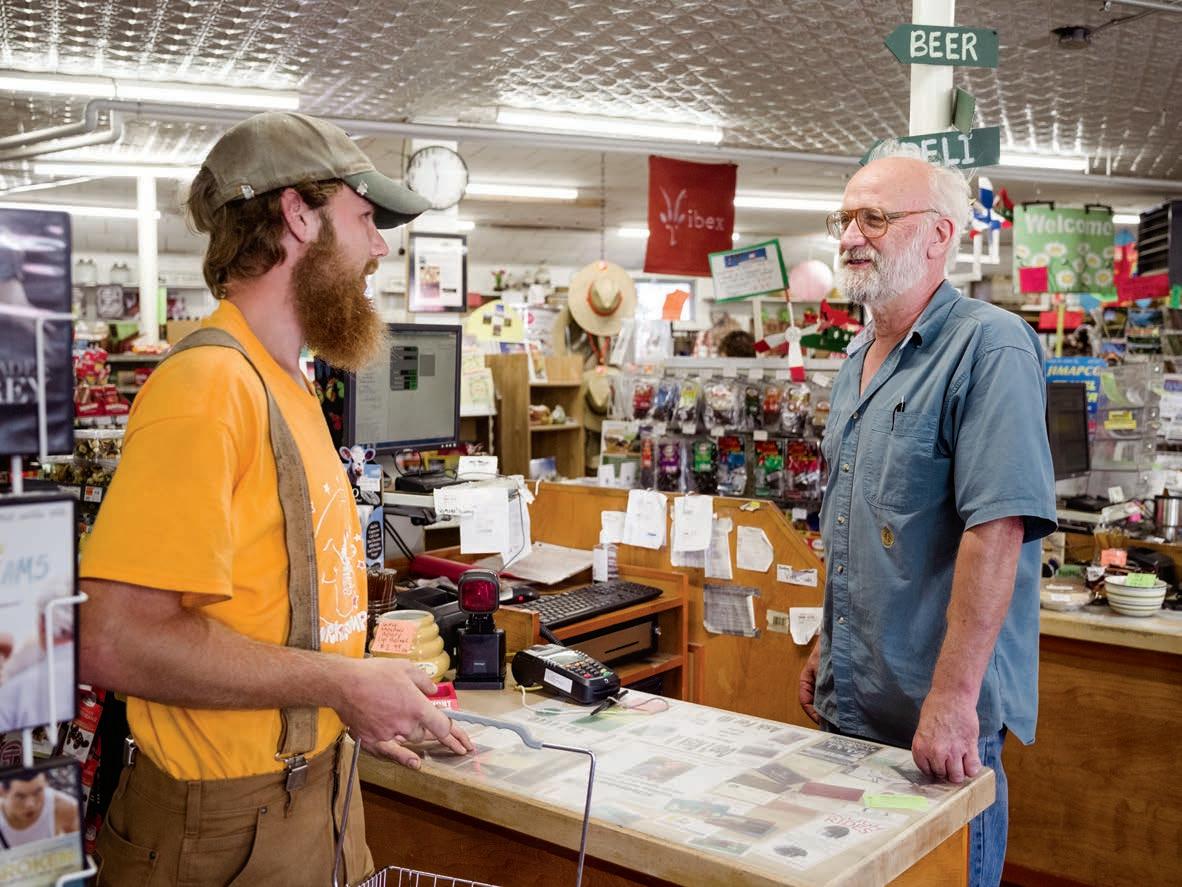
e live exactly six miles from what I believe to be the best country store east of the Mississippi. It’s called Willey’s, and it is right in the center of Greensboro, Vermont, a town of 750-ish residents on the eastern shore of Caspian Lake. Willey’s is housed in a rambling white clapboard building, with goods located on three floors (if one includes the basement, which I do, since I’m down there on at least a weekly basis, pawing through bins of plumbing apparatus). There’s a single gas pump on the building’s north side, and a bulletin board that runs almost the entire length of the front wall’s exterior.
Greensboro is one of those rural towns that have carved out a niche for themselves as destinations for affluent second-home owners. Credit goes in part to the lake, which is surrounded by tastefully remodeled “camps” that often run north of $500,000 and are, in most instances, far more commodious than the homes occupied by year-round residents.
But I imagine Willey’s doesn’t hurt, either. Were I in the position of choosing where to invest in a Vermont vacation home, being within a short hop of Willey’s certainly would be a factor in my decision. Amid the store’s fully stocked grocery, hardware, building supply, and household departments, one can procure a very nice bottle of wine, a pair of rubber barn boots, jumper cables,
a box of 12-gauge shotgun shells (and the gun to load them into), a length of two-inch schedule 40 PVC pipe, a wedge of Jasper Hill Farm’s Bayley Hazen Blue (which is made barely two miles from the store), a can of cream of mushroom soup, and a toilet plunger.

It is a rare week that I do not find ample reason to visit Willey’s. And while some of these expeditions do fall under the heading of legitimate need, there are—if I’m being entirely honest—just as many that fall under the heading of “just enough need to be considered legitimate but in truth more an excuse to visit Willey’s.” I know I’m not the only one: Around here, the acronym BTW is understood to stand for “Back Ta Willey’s,” which is what happens when one returns home with a ½-inch copper elbow only to realize that the line one is cutting into is actually ¾-inch. (This is a hypothetical scenario, of course.)
I like visiting Willey’s because I like the drive: the first three miles on a winding gravel road that traces a fastmoving mountain stream; the second three on a secondary paved road that often compels me to brake for meandering chickens. And I like visiting Willey’s because I can never be sure who I’m going to run into, though it’ll probably be someone I know, which means Willey’s is the backdrop for a goodly percentage of my social life. Too, I like visiting Willey’s because I can trade heckles with Rob Hurst, who is quick of wit and chuckle, and whose family has owned Willey’s for 118 years. Once, Rob tried to up-sell me on a branded drill bit intended to bore pilot holes for concrete screws (it didn’t work—I bought the cheaper, nonbranded bit, which did just fine), and ever since then, I like to accuse him of padding his retirement account with

each nut, bolt, and screw I carry home. Which leads me to another thing I like about Willey’s: the prices. I’m not sure how they do it, because the store is too small to have the bulk purchasing power of its larger competitors. For instance, I recently bought a metal electrical junction box for less than half what the exact same box cost me at a local building supply store. Such drastic disparities are not the rule, but in my experience, a 10 to 15 percent discount relative to the competition is common here. And the gas at the single pump is always at least a dime cheaper than anywhere else.
The truth is I’d shop at Willey’s even if the prices weren’t so good, because it is my fervent belief that the world is a better place with stores like Willey’s in it. In my view, these stores offer much more than merchandise; they offer community and kindness and decency, along with a sense of camaraderie and connection to a particular place. It’s no original thinking on my part to wonder if, despite all the convenience it provides, online and big-box shopping sells us short on a whole lot of less tangible—but no less important—benefits.
For my own amusement as much as anything else, I thought to compile a month’s worth of my purchases at Willey’s. I have not edited this list in any way, shape, or form; what you see is what you get. I offer commentary relating to some purchases but not all, because many of the items are too mundane to deserve elaboration.
On October 3, 2017, I buy:

• One tank of gas for our Kia Soul, which is maybe the slowest, ugliest car on the road in 2018, but which I love for precisely that reason.
• Two Chessters frozen custard sandwiches, the empty wrappers of which will end up wadded under the front seats of the aforementioned vehicle. (PS: My older son was with me. I would never buy two for just myself. Never.)
• One schedule 40 90-degree elbow.
• One scrub brush, for cleaning the buckets I use to collect and transport waste milk from a friend’s dairy farm for our pigs.
At the register, I run into our neighbor Andy, who is on his way home from work (he’s a builder). He’s buying a single Otter Creek Backseat Berner, which is one of the beers I favor, and I briefly consider picking one up, too. But there’s something about the combination of beer and Chessters that feels too decadent, so I don’t. Andy and I discuss the weather, which has been dry and warm to the point of peculiarity. But truth is we’d probably discuss the weather no matter what.
and now the lines ran smack-dab across it. And if you’re wondering why I cut the doorway before I rerouted the lines, so am I. Later, I go BTW and buy:
• One cylinder of MAP gas to replace the propane I used to sweat two of the copper elbows before it ran dry. This is actually a blessing in disguise, as switching to MAP gas for the remaining joints, in comparison to propane, is sort of like upgrading from a moped to a Ferrari.
• One ½-inch copper coupling. I don’t want to say why I buy this, because it would reveal what a lousy excuse of a plumber I am.
On October 10, I buy:
• One three-inch paintbrush for applying finish to a set of shelves that I’m building from the spalted maple logs I pulled out of the woods last autumn, and which David down at Lamoille Valley Lumber in
Greensboro Bend was kind enough to saw into live-edge boards for me (since, nearly two years after moving it from our old home, our sawmill isn’t set up yet—a fact of life I’m trying to accept with more than my usual equanimity).
• One box of 1¾-inch trim screws for assembling said shelves.
• One package of Frito-Lay salted peanuts. A weakness, I admit.
• Four 15A duplex outlets. I pass Dave at the hardware counter, but he’s deep into conversation (something about guns, from what I gather), so we just nod hello.

On October 13, I buy:

• One ½-inch-by-3 5/8 -inch hitch pin for the left telescoping sway bar of the tractor’s three-point hitch. The previous pin went missing at some point over the past week or two and, now that I have purchased a replacement, is sure to be found any day.
• Two pints of heavy cream from Butterworks Farm in Westfield, Vermont, to make ice cream for my son Rye’s birthday. Although we are milking a cow, she is late in her
Our pearl necklace is layered with elegance

We’ve suspended three sizable cultured pearls from three polished sterling chains to bring you this clean, minimalist design. A fresh and modern way to add the elegance of pearls.
f abulous j ew elry & g re at p ric es f or mor e than 65 ye ar s
$69 Plus Free Shipping
Cultured Pearl Three-Layer Necklace
18" length. Three 9-9.5mm cultured freshwater pearls. Sterling silver box chain with springring clasp. Shown slightly larger for detail.
Ross-Simons Item #870331
To receive this special offer, use offer code: LUSTER179
1.800.556.7376 or visit www.ross-simons.com/LUSTER




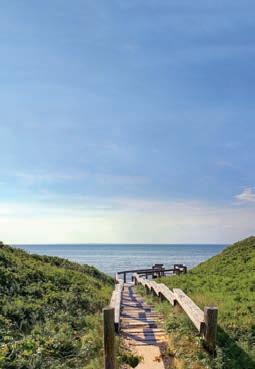











 BY STEVEN SLOSBERG
BY STEVEN SLOSBERG
n an early May morning under high blue skies, I am suddenly done in, seduced by an exultant impressionist’s landscape of almost every blooming color under the sun. I am not alone. Crowds of day pickers, arriving with the animated air of county-fair bustle, are only just beginning to make their way down the long dirt road to Wicked Tulips, New England’s only pick-your-own certified organic tulip farm, where 800,000 tulips are blossoming.
They have come here, to the grounds of historic Snake Den Farm in Johnston, Rhode Island, to disappear into color: pale pinks and blush pinks; purples cupped in yellow, purples dipped in ink; oranges richer than any citrus; reds bruised by violet; whites rinsed in apricot, lemon, and magenta. Petals like satin, petals like silk, all bunched in voluptuous rows of knee-high blossoms across five acres.
I take a breath of air scented by earth, flower, and straw-strewn pathways. Tulip lovers are here from seemingly every city, town, and village in Rhode Island; from the far reaches of Connecticut to the west, and well north into Massachusetts. They’ve arrived with children, with spouses, with parents and siblings. They are chatting, en masse, as garden clubs; they are in wheelchairs and in strollers; they are wearing broad-brimmed hats and ball caps; and they’re carrying buckets big and small. They’re here by the hundreds, patiently checking in at the entrance tent and looking about in wonder, as morning nears noon.
I chat with a seasoned gardener from Connecticut who happens to be Dutch. She has come to the farm with her daughter and 4-yearold granddaughter. “I picked exotics, French parrot tulips. They reminded me of a Dutch painting,” she says. “Everything here is a picture. In Holland, you cannot pick at Keukenhof [the world-renowned spring garden in Lisse]. Here, you can take some of this beauty home.”
As the light of sunset begins to spread across the fields at Wicked Tulips in Johnston, Rhode Island, a pair of bucket-toting youngsters pick their favorite blooms from the hundreds of thousands on offer at this one-of-a-kind organic farm.PHOTOGRAPHS BY MAAIKE BERNSTROM
An encounter with Jeroen Koeman, the tall and lean native of the Netherlands who owns Wicked Tulips with his Massachusetts-born wife, Keriann, embodies the frenzy of day picking and daily demands of a farm in its brief window of profitable harvest. With cap slightly askew and his “Wicked Tulips Farm” T-shirt ablaze with the national color of his homeland (orange), Jeroen has dismounted from his tractor to talk tulips with a dozen ladies from the Barrington Garden Club. Shortly into his talk, as he faces the group amid the picking fields, Jeroen is approached by Keriann, also in an orange T-shirt, who gently informs her husband that he’s left the tractor running.

Farming in New England, Jeroen tells the women in Dutch-accented English, is farming in New England weather. Wicked Tulips had hoped to open for the season in April, but a cold March left plants weakened, and this first week of May became the peak week for picking. Tulips are among spring’s most brilliant harbingers, and as neighboring farmers are still out preparing the soil and planting, and the oaks and maples rimming the farm are beginning to leaf out, Wicked Tulips and its customers are having their moment. For tulip lovers, there is no place like it, certainly not in these climes. Wicked Tulips, Jeroen tells his group of listeners, is the only source for certified organic tulip bulbs in the country.
Wicked Tulips evolved from the Koemans’ initial endeavor, EcoTulips, in Madison County, Virginia. Keriann was a mortgage broker and Jeroen was working for a large Dutch bulb wholesaler that had its U.S. base in Virginia. After several years running EcoTulips, however, the couple found the Virginia climate too hot too soon, and the local deer too ravenous, and began looking along the eastern seaboard for more favorable conditions. They briefly tried the
North Fork on the eastern end of Long Island, and they eyed Maine. Then they heard about Snake Den Farm: Located just west of Providence, it’s part of the 1,000-acre Snake Den State Park and home to a handful of small farmers who lease land from the state.
“It’s best to be within 10 miles of the coast,” says Jeroen. “We thought Rhode Island might be the best climate for growing bulbs: cold in the winter, hot in the summer. Bulbs need dry and warm over the summer.”
In October 2015, they began planting the first of what would be 250,000 bulbs in “u-pick” fields, utilizing a Dutch-built planting machine—a Koningsplanter (“King’s Planter”)—shipped from the Netherlands. “In the past we planted up to 60,000 bulbs by hand,” Jeroen says. “[The machine] can plant all the bulbs in one day. By hand it would take almost two months.”
For the first pick-your-own season the following spring, they welcomed some 17,000 visitors to the
tulip farm over three weeks, from late April to early May. The farm has also cultivated what it calls show gardens—meant only for ogling and strolling—as a respite for pickers and a sensory delight for all.
Buckets in hand, the pickers meander among the tulip rows, isolated from the world beyond the fields, carefully selecting blooms. From the picking fields, they head toward the wrapping station. Here, on long work tables outfitted with large rolls of brown paper, farm workers help them lay out the tulips and wrap them in paper bundles. Vases also are available for purchase.
For the record, Keriann says her favorite tulip is “Angelique,” a widely popular white-and-pink variety. Jeroen’s favorite, at first thought, is “Princess Irene,” an orange tulip showcasing the national color of the Netherlands and its royal House of Orange. Then he reconsiders and pronounces “Lalibela” his tulip of choice. “It is orange-red and super-strong. A classic tulip,” he says.
Although tulips are not perennials, Jeroen says, they do have perennial traits. “Whatever you plant will die, but the plant creates a few baby bulbs.” In summer, Jeroen digs up all the bulbs planted in the fall. “These bulbs double in quantity.” But, he adds, only about 10 to 20 percent of those bulbs are big enough to grow a flower in the spring.
The crowds of pickers are blissfully oblivious to the history and farming methods. Tulips are why they came, and tulips, carried by the bundle and armful as they make their way to their parked cars, are why they will return.
For up-to-date information on ticket prices and business hours, go to wickedtulips.com. This year would-be pickers also will be able to use the farm’s website to buy advance tickets, which are required for entry on weekends.





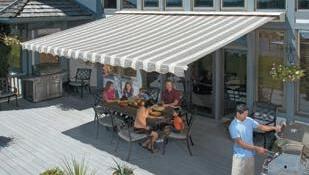


If you’re tired of having your outdoor enjoyment rained on...baked out...or just plain ruined by unpredictable weather...
At last there is a solution! One that lets you take control of the weather on your deck or patio, while saving on energy bills! It’s the incredible SunSetter Retractable Awning! A simple...easy-to-use...& affordable way to outsmart the weather and start enjoying your deck or patio more...rain or shine!
The SunSetter is like adding a whole extra outdoor room to your home giving you instant protection from glaring sun...or light showers! Plus it’s incredibly easy to use...opening & closing effortlessly in less than 60 seconds!
So, stop struggling with the weather... & start enjoying your deck or patio more!
For a FREE Info Kit & DVD email your dvd@sunsetter.com





Yankee was recently in Edgartown, MA, for the Martha’s Vineyard Food & Wine Festival, the annual celebration of the island’s rich food traditions and ingredients. In an event inspired by her recent Yankee feature “The Great Lobster Roll Adventure,” senior food editor Amy Traverso hosted a tasting of three types of lobster rolls with the Lighthouse Grill’s executive chef, Richard Doucette. The festivities led into the Grand Tasting, held on the Great Lawn of the island’s historic Harbor View Hotel.
Yankee was recently in Edgartown, MA, for the Martha’s Vineyard Food & Wine Festival, the annual celebration of the island’s rich food traditions and ingredients. In an event inspired by her recent Yankee feature “The Great Lobster Roll Adventure,” senior food editor Amy Traverso hosted a tasting of three types of lobster rolls with the Lighthouse Grill’s executive chef, Richard Doucette. The festivities led into the Grand Tasting, held on the Great Lawn of the island’s historic Harbor View Hotel.
The MVF&W festival puts a spotlight on local chefs and the farmers, fishermen, oyster producers, and artisans they work with. The festival, which Yankee sponsors, is four days and three nights of unique-to-the-island experiences and dinners with some of the region’s most notable and award-winning chefs, such as Jeremy Sewall (Island Creek Oyster Bar, Row 34), Mary Dumont (Cultivar), and Colin Lynch (Bar Mezzana).
The MVF&W festival puts a spotlight on local chefs and the farmers, fishermen, oyster producers, and artisans they work with. The festival, which Yankee sponsors, is four days and three nights of unique-to-the-island experiences and dinners with some of the region’s most notable and award-winning chefs, such as Jeremy Sewall (Island Creek Oyster Bar, Row 34), Mary Dumont (Cultivar), and Colin Lynch (Bar Mezzana).
Celebrating the people, destinations, and experiences that make the region and Yankee Magazine so unique. Follow along @YANKEEMAGAZINE

Plan ahead and join Yankee at this year’s Martha’s Vineyard Food & Wine Festival. Enjoy access to top chefs from Martha’s Vineyard, Boston, and beyond. October 18-21 For more information go to mvfoodandwine.com




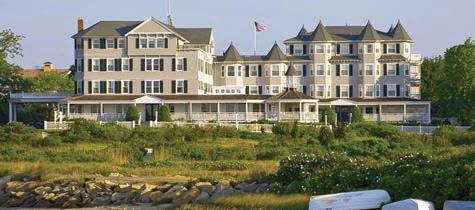


t was my wife who first discovered Yankee Points. One morning not long after we moved to New Hampshire, as she was hanging wash on the front porch, she discovered that wooden clothespins counted two YPs each. From that moment on, we learned new things every day. We learned that you get points for stopping by the dooryard instead of using the telephone. You get points for warming up cold coffee, for going to the dump in a rustedout truck, and for giving misdirections to people with Massachusetts plates.
It’s 100 points a month for each junker visible from the road and 400 points for an apostrophe misplaced in public, as in Fresh Egg’s. Newcomers often garner unexpected points: 1,200 for not posting their property, 1,000 for down-trading a Porsche to a pickup, 100 for a macaroni
and cheese casserole baked for church supper, 50 for staying awake through town meeting, 400 for losing in a tightly contested race for Trustee of Graveyards….
Attitude points may be the hardest to explain. For instance, there are large awards for generosity and for selfishness. If your neighbor’s house burns down, you get 500 points for giving him a blanket and 500 more if it has holes in it.
It takes 75 years, according to reliable authorities, to get the hang of Yankee Points—by which time you might even qualify for the 50,000 terminal points awarded for an open coffin in the parlor for the funeral.
—Adapted from “How to Pile Up Yankee Points,” by Donald Hall, November 1990



John Irving (born March 2, 1942, in Exeter, New Hampshire). The quote comes from Irving’s breakthrough novel, The World According to Garp , published 40 years ago. Since then, he has won a National Book Award and a screenwriting Oscar, seen his books translated into 35-plus languages, battled back from prostate cancer, become a grandfather of four, and been inducted into the National Wrestling Hall of Fame. Next up: fi nishing his 15th novel, Darkness as a Bride

“Everybody dies. I’m going to die too. So will you. The thing is, to have a life before we die. It can be a real adventure having a life.”
Compiled by Julia Shipley
5/16/57
Date that Joan Benoit was born in Cape Elizabeth, Maine

One

Number of marathons that she ran before winning the Boston Marathon in 1979
1983
Year she set a women’s world record (Boston, 2:22:43)
11



Number of years before any woman would beat her worldrecord pace


Number of days after knee surgery that she won the 1984 Olympic trials
Twenty-seven
Age when she took gold in the first women’s Olympic marathon, in 1984
8 Size of Benoit’s running shoes
3:12:27
Time in which she ran the 2017 Sugarloaf Marathon, winning her age group (women 60-64)
146,000 Estimated miles she has run in her career
71
Number of minutes between Benoit and the next Sugarloaf finisher in her age group
Nineteen
Percentage of 180,000 U.S. marathon finishers in 1984 who were women
Percentage of 541,000 U.S. marathon finishers in 2013 who were women
 ILLUSTRATION BY J.P. SCHMELZER
BY JOE BILLS
ILLUSTRATION BY J.P. SCHMELZER
BY JOE BILLS
asily overlooked by city dwellers, mud season is all too real for the rest of us in New England. Consider that in Vermont, for instance, more than half of the nearly 16,000 miles of roadway is unpaved. For tips on keeping one’s vehicle moving through the muck, we visited Gilsum, New Hampshire, to chat with 16-year-old mud racer James Munroe. He began competing when he was 13, not long after being diagnosed with non-Hodgkin lymphoma. “[Racing] was something he was excited about, and he needed the distraction,” says his mom, Jessica. “He loved it right away.” Here’s some wisdom we gleaned from this young master of the mire.
“It’s important to know the clearance of your vehicle and how deep the mud is,” says Munroe, who has raced in up to two feet of the stuff at Monadnock Speedway in Swanzey, New Hampshire. “Smaller cars will literally be down in the mud, while larger truck tires kind of skim over the top.” If you don’t know what you are driving into, get out and look.
Traction is key when driving in mud. If your vehicle has four-wheel drive or other tractioncontrol equipment, mud season is exactly what it’s meant for. “Lock in the four-wheel drive, and don’t forget to lock the hubs,” Munroe says, and laughs. “You never want to find out you aren’t in
four-wheel drive once you’re already in the middle of things.”
When it comes to mud, you’re better off blazing your own trail if the ruts have gotten too deep. “It all depends on what is already there,” Munroe says. “Sometimes the ruts can be good and will keep you on track, but I’m always ready to cut a new path if I have to.”







Your goal should be to get through the mud with as steady a hand as possible. Maintain momentum, and avoid stomping on the gas or the brakes. Keep moving in as straight a line as possible to minimize steering. If you start to slide, ease off the gas and turn the wheels slightly into the skid. Don’t worry about the tires spinning so long as you are moving forward. If you start
losing forward momentum, ease off the gas until the tires start to grab again.




When you’re driving in mud, the No. 1 thing to avoid is coming to a full stop. If you do lose all momentum, turn your wheels from side to side, to see if traction can be gained in another direction. You can also reverse out, or rock the car from forward to reverse in an attempt to get it moving. “On the track, I only got stuck once, and it was bad,” Munroe admits. “Embarrassing. I was suspended on the mud, with all four tires off the ground. If I had it to do over again, I would have stayed up on one of the banks, to give the tires something hard to chew on.”
Mud gets everywhere, and it can be as hard as cement when it dries. As soon






as possible, wash the mud off your car and check carefully for any damage. “I use a pressure washer after a race, and even with that, cleaning can take a long time,” Munroe says. “And it isn’t just the mud. Rocks can get thrown up and lodge in the springs or in the brakes. It isn’t fun, but the longer you wait, the worse it gets.”

As for keeping all that mud out of the house, we checked in with Munroe’s mother, Jessica. “Luckily, his clothes don’t get nearly as dirty as the truck does,” she says. But sometimes it’s unavoidable. In those cases, it’s a problem to be dealt with outdoors. “Mainly it’s his boots that get the worst of it. Thankfully, we can let the mud harden up and hit them together. If it’s really bad, the power washer will do the trick.”






 By ANNIE GRAVES
Photographs by KELLER + KELLER
By ANNIE GRAVES
Photographs by KELLER + KELLER

re Doucette’s farmhouse, built in 1846, would be scarcely recognizable to its original family, but its breezy style and witty design solutions have become familiar to more than 100,000 monthly online visitors. “I started decorating when I was 13,” says Bre, smiling, as she stands in the kitchen of the Candia, New Hampshire, home. “Sometimes I would change the look of my bedroom three times in the same afternoon. I just had to get it out.”
These days, an avid audience regularly checks out Bre’s blog, Rooms for Rent, along with her Pinterest and Instagram postings, to see what she’s changing next, and how she’s doing it. Is she repainting the kitchen island? Adding bold pillows to the slipcovered couch? Tweaking the flowers on the dining room table that her husband, Jesse, built and that she stained to beachy perfection? Or building an outdoor patio to offset their newly shingled barn?
“I was always creating vignettes on my dresser,” says Bre, now 32, “always drawing room sketches at school.” When her parents bought an early Gateway computer and told each of the kids they could pick one game for it, Bre chose interior design software. “My parents said, ‘It’s not really a game,’ and I said, ‘Well, it is for me.’”
The game became reality in 2011, when Bre and Jesse bought the Candia farmhouse. It had been updated by a contractor who wanted to flip it, so the basics—including new plumbing and electrical—were in place. And with two acres abutting 100 acres of conservation land, there was plenty of room for the couple’s two young children, Carter and Dannika. “When we found this, we just knew,” she says.
But while they loved the character of the house, “at the time it was a lot of brown, mustard brown, and more brown inside,” she says. “The house felt covered up. I wanted to use colors that would complement the interior, instead of just being something to put on the walls.”
A year later, Bre started blogging about the details: the colors she was
trying out, the bargains she was find ing, the fun of it all. “With the blog, all of these dormant ideas were coming out. All the dreams I had as a kid could be expressed, and there was a commu nity that soaked it up.” The beautiful results—a style that Bre calls “clean farmhouse”—brought both subscribers and sponsors.
Today, the first thing you notice upon entering the light-soaked kitchen is a floor-to-ceiling dish rack filled with white ironstone platters and weathered cutting boards. “It was just a blank wall, bowed out because the chimney behind it had settled,” Bre recalls. “It drove me crazy because we had three doors lined up on that one wall: bathroom, basement, and back hallway. I wanted to do something that felt like it had always been there, and to distract from the
wall of doors. It took a year to convince my husband—it was a big job. We had to cut out the chimney!”
The rack is backed with beadboard; thin strips of wooden screen strapping create the rails. “I didn’t want anything too heavy,” she says. “The wall felt heavy enough, with all those doors.” Beadboard wraps the kitchen island, too, and repeats as the backsplash. And to make the stock cabinets seem less “stocklike,” the couple attached corbels—which

1 Bre made the kitchen’s “Bakery” sign from a barn board that had been squirreled away down in the basement. It proved to be the perfect solution after everything else they tried on top of the dish rack looked wrong. “It’s nailed to the wall, and it’s staying with the house!”

2 This dining room dresser, which had belonged to Bre’s mother, was the first piece of furniture Bre and Jesse tackled together. After sanding it down to look like weathered oak, they applied an “Early American” stain for the first layer and put a “driftwood” stain on top of that. A light sanding blended the two stains together.
3 The dining room is painted in Glidden’s Wood Smoke, a Better Homes & Garden 2012 top pick for paint colors.


also brace the open shelving added near the back entry after every other attempt at placing furniture there blocked the doorway.
An entire wall of gray chalk paint, which Bre mixed herself, evolved as a solution to another problem: The wall abutting the dining room bumps out, creating a wall on two planes. “I wanted to turn this quirky thing into something that looked purposeful and was pretty as well,” she says. “I’ve grown tons in figuring out how to disguise unsightly things.”
With each lesson Bre has learned, her readers have gained insights into thinking outside the box. Even clutter offers creative opportunities. Vintage wooden crates stashed under Jesse’s hand-built kitchen bench hide the kids’ boots and shoes; in the kitchen’s back entryway, hooks are hung at two distinctly different heights, with numbers stenciled beside them. “I wanted it to
feel like an old schoolhouse,” Bre says. “Every day, the first thing my son does when he gets home is hang up his jacket and backpack and put his shoes away.”
The kitchen flows effortlessly into the dining room, which is the only room that hasn’t been repainted more than once. “It feels like it’s the color it was always meant to be!” Bre exults. But she points to a once-problematic jog that Jesse retrofitted with a woodstove, hearth, and mantel. “It was a funky corner in the dining room—we always thought that somewhere down the road, we’d have to square it off. But a few months after we moved in, he decided we needed a woodstove, and it was the perfect place to put it.” That first winter they lost power eight times, so the solution was pretty and practical.
Bre indicates the half walls topped with columns that divide the dining and living rooms. “This was the selling point for me,” she says. The feeling

of open space, the uncluttered style … it’s an oasis of calm. “Weathered wood, white, and anything slipcovered—it’s what I’m known for.”
Yet we’re also in the presence of a wealth of how-to projects and low-cost fixes. Bre sanded and restained the coffee table (built by Jesse’s grandfather), stenciled a faded Union Jack flag on the corner table (made by Jesse), fashioned a coatrack from a piece of driftwood, and even painted the two dreamy abstract landscapes beside the

couch (“I’m not a painter, but I think I just found a new hobby”).
And yes, the tutorials appear on her blog. You, too, can affix barn boards to the wall behind your bed to create a headboard. Paint stripes on drop-cloth curtains. Make a farm table from two-by-sixes. Bre’s advice, widely applicable, is “Keep going until you see what you like.”



She points to the master bedroom’s “Rooms for Rent” sign, the one that inspired the name of her blog. Made by Pottery Barn, the sign was originally priced at $229. Bre kept an eye on it until it landed in clearance for $30. “Anyone can decorate, and it doesn’t have to be expensive,” she says. “It’s knowing where to look and what to find. That sign represents my passion: decorating rooms with ideas that people can ‘rent,’ in a manner of speaking. This house, with its dilemmas, forced me to look outside the box for solutions—that’s been my journey with it.”
She pauses, and looks around the airy farmhouse kitchen. “I wouldn’t change one thing about that.”




Flat-finish latex paint, mixing container, unsanded tile grout, paint stirrer, roller or sponge paintbrush, 150-grit sandpaper, chalk, sponge




(1) Start with flat-finish latex paint in any shade. For small areas, such as a door panel, mix 1 cup at a time. Pour 1 cup of paint into a container. Add 2 tablespoons of unsanded tile grout. Mix with a paint stirrer, carefully breaking up clumps. (2) Apply paint with a roller or a sponge paintbrush to a primed or painted surface. Work in small sections, going over the same spot several times to ensure full, even coverage. Let dry.
(3) Smooth area with 150-grit sandpaper, and wipe off dust. (4) To condition, rub the side of a piece of chalk over entire surface. Wipe away residue with a barely damp sponge.







—From Martha Stewart Living , January 2007



The wood carvings of Maine’s Roland LaVallee bring springtime inside when we need it most.

hen I first arrive in the coastal town of East port, Maine—practically in Canada—fields of wild lupine are blooming across the countryside, bursting into pink and purple spires. But by the time this story appears, we’ll be staring down winter’s long white spyglass, look ing to glimpse the first signs of spring.
Regardless of the season, an uncommon number of birds can be found roosting just blocks from the center of this artsy-vibe town, population 1,300. While Roland LaVallee’s Crow Tracks home and studio might look like any other charming gray clapboard 1860s New Eng lander, behind its laid-back façade there’s avian anar chy—albeit the carved-wood sort.
The front room flaunts the evidence, floor to ceiling. An imposing pileated woodpecker guards the heights over the fireplace. A white heron crouches low on the mantel. Seabirds stalk along hunks of driftwood, and crows clasp folded dollar bills in their beaks. Shelf upon shelf of tiny golden birds cling to stumps of polished wood, and chickadees sidle up to phoebes. It’s the quiet est bird sanctuary you can imagine.
With his neatly carved brown moustache and care fully whittled beard, Roland resembles some of his more human sculptures, although most of these reflect his humorous side—which bubbles up easily when asked what brought him to Maine.
“Connecticut was too full of people,” Roland says with a dry twinkle, recalling why he moved here in 1977, then worked in Eastport’s textile mill for the next 20 years. All the while, he carved wood, a pastime since childhood, when he would create spears, decoys, and “little faces out of pine—the same things I carve now.”
But in Maine, there was an additional incentive. “There was always the chance you’d get laid off at the textile mill,” he recalls. “I had books on making decoys—I thought I should make some and see what happens, see about selling them in the gift shops on Route 1.” He smiles, remembering those early carvings. “My decoys were funky as can be. I was using house paints, learning as I went along.”
We walk to the adjacent room, where Roland cuts raw chunks of pine into rough bird shapes, then shaves more and more wood away until the bird within emerges. The workshop is warm with the colors of wood, the smell of sawdust. “Pine spins in my hands easy,” he says. “I work with stuff that works well with me.”
This includes a jumble of favorite tools housed in a battered trunk in the kitchen, where Roland sits to paint birds at a glass-topped table looking toward Passamaquoddy and Cobscook bays, across to Franklin Roosevelt’s summer place on Campobello Island. (The view is breathtaking; this is “where the light is,” he says.) Roland lifts the trunk lid: X-Acto knives, delicate chisels, small paintbrushes, and a refined wood-burning tool for adding feathers and other details, bought in the late 1980s. “I’ve kicked out about 8,000 birds with it,” he says.
The evidence is all around: There are currently about 435 birds in the front room, Roland estimates. Some years he turns out lots of chickadees; other years he’s busy working on big

It’s a long winter. We’re surrounded by cold water. Spring doesn’t come until maybe the last week in May.”
When spring does finally arrive, Roland will work outside under the apple tree, carving on a chopping block that overlooks the terraced back garden that he tends with his wife, Barbara Barrett. He’ll move around the yard with the sunshine, following the light. “We get a lot of wind,” he says. “But the good weather is nice … when it comes.”
commissions. Regardless, he says, “fall and winter I work on my inventory. I know, for example, that I’ll need six puffins, six herons. January comes, and I start doing the weirder stuff—clams, mermaids, monsters.
Back in the studio, Roland cradles a snowy owl in his hands, pointing out details of paint and carving. “I get up every day, carve a different bird.” His face lights up with this bird in hand. “I’m having a good time.”
Prices range from $40 for a small crow sculpture to $700 for a custom bird piece. For more information, call 207-8532336 or go to crowtracks.com.
“Pine spins in my hands easy. I work with stuff that works well with me.”
BEST-SELLING STYLE
FIND YOUR PERFECT FIT
US sizes 5-11 with half sizes 5.5-9.5






Three width fittings: Hotter Comfort Fit a US Medium/wide/D-E fit
Extra Wide Fit US Wide/EE fit + Triple E fitting a US Extra Wide Fit

Styled for ultimate comfort, with its supple leather and nubuck uppers, cushioned foot bed and plaited touch-close strap, it’s easy to see why Shake is one of our best-selling casual styles.


Every single pair of Hotter shoes is designed around a host of signature comfort features, so that from the moment you slip them on in the morning to the moment you take them off at the end of the day, every step will be a pure delight. Using only premium materials such as butter soft leathers and super-soft suedes, combined with sumptuous cushioned insoles, collars and tongues, plus extra wiggle room for toes, we guarantee a perfect fit straight out of the box.

We would love to offer you the opportunity to sample our Comfort Concept© features for the very first time with Shake, one of our best-selling favorites, at an unbeatable price. Experience true comfort, carefully designed and crafted in Britain, with free tracked shipping direct to your door.
























are handmade using the finest quality ingredients,and are fully cooked before packaging. One dozen delicious pierogi are nestled in a tray, making a one pound package of pure enjoyment!


are HANDMADE using the finest quality ingredients, and are fully cooked before packaging. One dozen delicious pierogi are nestled in a tray, making a one pound package of pure enjoyment!
You can get Millie’s Pierogi with these popular fillings:• Cabbage • Potato & Cheese

• Farmer’s Cheese • Blueberry • Prune
• Potato & Cheese with Kielbasa • Potato & Onion
Turns any day into an occasion – order today!




Box of 6 trays-$42 • Box of 10 trays-$63





Box of 6 trays-$46 • Box of 10 trays-$69





Polish Picnic-$45 • Polish Party Pack-$69
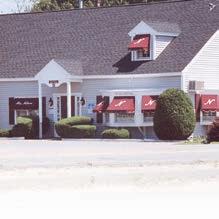
Polish Picnic-$43.50 • Polish Party Pack-$66
Kapusta & 5 trays–$45.50 • Plus Shipping
Kapusta & 5 trays–$49

Kill Kare, in the words of one recent guest: “What a jewel of a house, floating on the lake ... a place of daydreams and tranquility.” BELOW : The wraparound porch, looking out on Walker Pond.
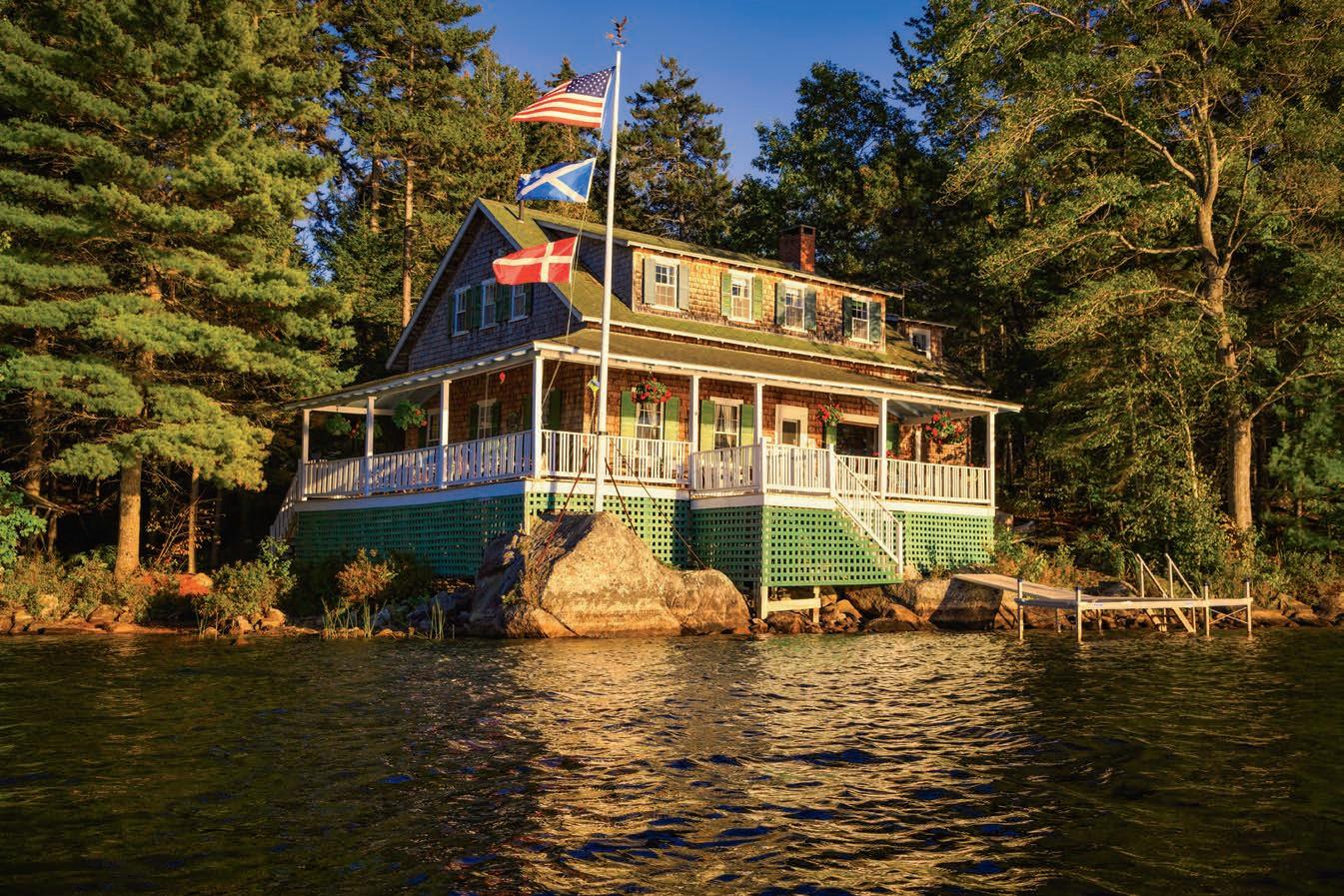

Perched on the shore of a pond on Maine’s Blue Hill Peninsula, a family cottage holds a century of memories.

Yankee likes to mosey around and see, out of editorial curiosity, what you can turn up when you go house hunting. We have no stake in the sale whatsoever and would decline it if offered.
hile most of us live in a house, a few of us—the luckiest ones—know that sometimes a house can live inside us as well. On this day in late June, we are sitting on an expansive porch alongside Walker Pond in Sedgwick, Maine, hearing the story of a summer home that has been a part of Catherine Larson’s life as long as she can remember. Her husband, Dan, joins us and sprinkles the conversation with anecdotes about his own relationship with the cottage that Catherine’s grandfather built and named Kill Kare because, Catherine explains, “you came here and felt all your cares melt away.”
There is a hint of salt air on the breeze; the bay is only a few hundred yards distant through the woods. Roses line the porch. Catherine tells about her many summers here, fishing and picking blueberries and paddling canoes, rowing boats, learning to swim and then testing to see how far her endurance could take her. There were campfires and watching the sun setting and the dark settling into the quiet and the stars filling the sky.
The story of Kill Kare begins in the humidity and heat of the Baltimore–Washington, D.C., region, from which Catherine’s grandparents, Wilbur and Catherine Smith, followed other wellto-do families to Maine’s Blue Hill Peninsula in the early 1900s. There, they found bracing, clean air in a cluster of cottages in Brooklin that came to be known as the Colony.
Wilbur Smith built his cottage by the sea in 1915, but he was passionate about freshwater fishing, too. One day he rowed his boat to the middle of Walker Pond, one of the very few clear and deep freshwater ponds around, and saw two great boulders along the shore. He decided he would build on those boulders a getaway from his ocean getaway, and he’d sit on a wraparound porch and feel as if he were all but floating. He built the shingle-style cottage in 1917.
His wife scoured flea markets, antiques shops, and local farms for the rustic furnishings that gave the pond cottage a personality that remains, even as electric lights replaced candles and kerosene lamps, and showers were added and a bedroom became a dining room. “My grandfather called my grandmother ‘the hostess to the coast,’” says Catherine, and she recalls it was rare for the cottage not to be filled with family and friends.
All that was before Catherine’s mother, Grace Hooper McNeal, started a girls’ camp called Four Winds in 1946 on nearby farmland that Wilbur owned. Then came the summers that worked their way into Catherine’s life, first as a young child, then coming of age surrounded by campers and counselors. The camp became both home and family, and Kill Kare became a place to rest, to host reunions, to house campers’ parents. Camp Four Winds ran for 57 seasons before closing in 2002. The family sold it to a neighbor, an avid environmentalist who, Catherine says, “has cared for the land.”
Catherine and Dan take us on a stroll through the cottage, which becomes a tour through generations of family memories: the framed menu from a gathering in 1932; the fish mounted above the great stone fireplace, which leads to stories about bass that seemed to leap from water to net to frying pan. There’s a photo of Catherine’s son as a boy; he’s now in his early
30s. “We talked long and hard with him about selling,” Catherine says. “He only comes now for one week. And we’re not getting younger.”
The six bedrooms speak of the carefree days of summer, when friends and family seemed to arrive in a happy stream; the lack of closets speak of the casualness of it all, of unpacking and simply hanging clothes on hooks. Catherine points out the kerosene lamp her grandmother designed, how she wanted it homey but also with a hint of the wildness that attracted them in the first place.
When we return to the porch, a loon splashes down in front of us. The sun slants across the water. The quiet is everywhere. “How many family discussions have we had here?” Catherine muses. “This has always been a place for healing with nature. It’s where we came when we lost loved ones. It’s where we have always felt at peace.” Then she adds, “It is heartbreaking, but it’s time.”
“We want to leave on a high note,” Dan says. “We hope we find a family with kids who can grow up here and be careful with the environment. Someone who will want to be here for many generations.” With shorefront building regulations today, he says, a cottage like this, perched on boulders, can never be replicated. “You can buy many places on the water, but the soul that this house has speaks to some people. That’s what we hope.” —Mel
AllenThe Larsons’ property is priced at $1.2 million and includes 40-plus acres, 350 feet of waterfront, and—in addition to Kill Kare—a modern two-bedroom carriage house apartment just up the road. For more information, contact Jill Knowles of the Christopher Group in Blue Hill, Maine, at 207-248-2048.








 VERMONT CHEDDAR-ALE DIP (RECIPE, P. 54)
VERMONT CHEDDAR-ALE DIP (RECIPE, P. 54)
Join food editor Amy Traverso for a delicious behind-the-scenes tour of the places and people featured on Weekends with Yankee our WGBH television series, now in its second season.
he drive from midcoast Maine to the Lost Kitchen is a northwesterly trek through woodsy back roads punctuated by stone-walled fields and a glimmering string of lakes and ponds. In a van loaded with camera equipment, we’re racing to reach New England’s most sought-after restaurant before diners arrive. As we head inland, the towns’ names turn from Rockport and Northport to abstractions: Liberty, Hope, and, finally, Freedom.
Finally, Freedom could be the title of chef Erin French’s memoir, should she ever write one. She was a young kid here, flipping burgers in her dad’s diner, before leaving for bigger adventures in Boston and California. After having a child, she returned to Maine and picked up baking and catering jobs, mastering wedding cakes and dinner for 50. In Belfast, she drew together those skills, all her courage, and a preternatural talent for making things beautiful—dishes, table-


scapes, rooms—and opened the original Lost Kitchen with her husband, first as a semisecret weekly supper club in her apartment and then as a real restaurant in a flatiron building on Main Street. The menu was dictated by whatever was local and in season; the seafood, vegetables, fruit, cheeses, and meats all came from Maine. Her avid customer base was only partly local, as word quickly traveled far beyond midcoast Maine. But then everything fell apart: Her marriage imploded and took the restaurant with it. French and her son came home to Freedom in 2013 to figure out what to do next.
The answer that seemed so unlikely five years ago looks inevitable now, in light of her success: to take over the first floor of Freedom’s newly renovated 1834 gristmill and turn it into a restaurant. To see if those adoring crowds would drive 17 miles inland to taste her food again.

Freedom is a tiny place. There were 716 inhabitants here in 1870, and that number has barely ticked up since. But once

word got out about a seemingly magical restaurant in middle-of-nowhere Maine, the diehards came back—and then the world came calling. The new Lost Kitchen opened on, appropriately enough, Independence Day 2015, and soon everyone wanted in. By 2017, demand had reached the point that when the reservation line opened for the season at midnight on April 1, the town’s phone system became so logjammed that it set off alarms at the fire station. Thousands of people were hitting redial, redial, redial. At about 1 a.m. French posted on Facebook, sounding like an eyewitness to a flood: “This is bigger than us ... thousands of calls pouring in. Doing our best to keep up ... please bear with us....”
French knows that those who are lucky enough to nab these coveted spots are expecting the meal of a lifetime. They’ve worked hard to get here, and she’s fiercely protective of their experience. So when a stranger walks into the restaurant with a tall tale about a phone message left by ... he can’t remember the chap’s name, but he said there might be a cancellation tonight ... a staffer politely sends him on his way. “We don’t have cancellations,” she tells me, “and we’re all women here.” (There is one male dishwasher, TJ, but he mostly sticks to the basement prep kitchen.)
Our small TV crew knows that getting permission to film here is the proverbial golden ticket, so we all do our best to remain unobtrusive, sticking to the edge of the room as diners make their way through the cheese, salad, sorbet, and lamb courses. I watch the


careful choreography as French’s team arranges little bouquets of herbs and edible flowers, a French signature, atop beds of greens while she works the stove in the open kitchen. With each course, she takes a break to mingle with guests or tell a story, or dance. She says she wants the dining room to feel like an extension of her home, so every object is curated to her taste, from the jadeite sorbet dishes shaped like hens to the commanding floral arrangements that she composes from whatever is growing locally: sawedoff birch branches, amaranth, dahlias. Her staffers—mostly farmers who also supply the restaurant when they’re not waiting tables—move around the room with practiced ease. As dusk turns to night, they bring out a new round of candles, because French likes how it refreshes the eye. This may be rural Maine, but there’s an element of High Church in the ritual tranquility.
As I watch dinner unfold, director of cinematography Alan Weeks and sound engineer Christoph Gelfand weave among the tables to get closeups while Rennik Soholt, our director, keeps an eye on a monitor in the lobby. Every shoot day on Weekends with Yankee is an attempt to capture something essential about New England via the extraordinary experiences we’ve curated into a 13-episode season. When guests step out for a break— from arrivals to final toasts, this is a four-hour experience—we grab interviews with the willing. They emerge from the dining room with the radiantly transfigured look of converts.
“Was it worth the trouble getting here?” I ask. “Oh yes,” they say. “Oh my God, yes.”
A visit to the Lost Kitchen was just one adventure that my cohost, Richard Wiese, and I filmed for this new season of Weekends with Yankee. The following stories and recipes offer a taste of the show’s food segments, with behindthe-scenes insights into how we bring Yankee to life onscreen.


In her 2017 cookbook, The Lost Kitchen: Recipes and a Good Life Found in Freedom, Maine, Erin French writes: “My Gram wasn’t the best cook, but pies were her thing. I can still taste the sugary graham cracker crust she’d press into the tins and then top off with creamy vanilla pudding. We’d sell them at the diner, finished off with a mountain of whipped cream and a maraschino cherry. I dress up my version with a spray of Johnny-jump-ups or any other edible flower I can find.”
We adapted French’s recipe to put the deliciousness of a perfectly made graham cracker crust front and center, We love how she elevates a simple dish with attention to presentation and technique. It’s typical of French’s approach
to food: Start with great ingredients, distill the flavor, make it beautiful.
45
11 graham crackers
¼ cup granulated sugar
7 tablespoons salted butter, melted
3 cups whole milk
1 vanilla bean, split lengthwise, seeds scraped out with a spoon
½ cup granulated sugar
Pinch of salt
¼ cup cornstarch
3 large egg yolks
2 teaspoons vanilla extract
Whipped cream and edible flowers, for garnish (optional)
Preheat oven to 350° and set a rack to the lower-third position.
Make the crust: In a food processor, pulse the graham crackers, sugar, and butter until well ground. Press the crust mixture into a 9-inch tart pan with a removable bottom. Bake until the crust is set but not browned, about 10 minutes, then allow it to cool.
Make the filling: Heat the milk, vanilla bean and seeds, sugar, salt, and cornstarch in a medium saucepan over medium heat, whisking constantly, until it thickens, 6 to 8 minutes.
In a large bowl, lightly beat the egg yolks. Slowly whisk 1/3 cup of the milk mixture into the yolks to gradually raise their temperature. Slowly whisk in the remaining milk. Return the mixture to the saucepan and whisk over medium heat until just bubbling. Remove from heat, let cool slightly, and stir in the vanilla extract. Remove the bean.
Pour the filling into the crust and let it set in the refrigerator, at least 5 hours and up to overnight. Slice and serve topped with whipped cream and edible flowers, if you like. Yields 8 servings.

Some of the best food we tasted while filming season 2 was in the aging rooms of Grafton Village Cheese and Jasper Hill Farm, two award-winning cheese makers located in small Vermont towns. Following the process from fresh vats of milk to fully aged wheels, then being able to pull samples of Grafton’s clothbound cheddar and Jasper Hill’s Bayley Hazen Blue, was the kind of behind-thescenes access that made filming such a delight.
Then, just up the road from Jasper Hill, we tasted why Shaun Hill’s remote brewery, Hill Farmstead, has been named the best in the world for the past three years by influential craft beer site RateBeer. With dozens of ales, stouts, porters, and pilsners on offer, this is the only place where Hill’s fans can access the full range of his products. People come from all over the country to visit this windy hilltop, a former dairy farm that has been in Hill’s family for more than 200 years, and their enthusiasm is as irrepressible as the bold IPAs that make this place famous.
In honor of these three locations, I developed a recipe for cheddar-ale
dip that combines all the Vermont flavors that still remain so vivid in my



VERMONT CHEDDAR-ALE DIP
In choosing an ale for this recipe, know that the darker brew you choose, the stron ger the flavor will be. Also, avoid using preshredded cheddar, which is coated with an anticaking agent that will make the dip very thick.

Melt butter in a big skillet over medium heat. Whisk in flour until smooth. Cook, whisking continuously, about 1 minute (don’t let mixture brown). Add ale very slowly, still whisking, then add

per to taste. Cook over medium heat, whisking continuously, until mixture is thickened and bubbly, about 5 minutes.
ing until melted. Top with scallions, if desired, and serve with tortilla chips or
On a clear blue August day, we arrived at the Farm at Chatham Bars Inn, an eight-acre property that turns out thousands of pounds of tomatoes, cucumbers, beans, squash, carrots, and other produce for the inn’s three restaurants and the local community. It’s been a work in progress since 2012, when the inn purchased this former berry farm. “With a lot of work, you can turn Cape Cod soils into productive soils,” says farm manager Josh Schiff, explaining how his crew enriched the sandy earth with layer after layer of compost. It took a lot of investment, courtesy of inn owner Richard Cohen, a New York–based real estate investor, but there was a precedent here: In its earliest days, the inn was a hunting lodge for wealthy Bostonians that boasted an on-site dairy and vegetable farm—so Schiff’s efforts complete a circle.
When we visited, Chatham Bars Inn’s executive chef, Anthony Cole, was hosting a farm-to-table dinner with guest chef Colin Lynch of Bar Mezzana in Boston. Part of a weekly summer dinner series that is open to the public, the meal featured Schiff’s produce, local seafood, and a great ocean view. We sat at a long communal table, passing plate after plate of roasted carrots with dates and herbed yogurt; sweet tomato salads; striped bass; and roasted sweet peppers with raisins and burrata. Fellow diners told me about their favorite new eateries: Sunbird and Vers in Orleans, Snowy Owl in Brewster. My list of must-try
Cape restaurants kept expanding. It’s a good problem to have.

For a prettier presentation, you can buy small (½-inch-thick) carrots with their tops attached. Trim off all but an inch of the stems, then pick and wash some of the delicate leaves for a garnish. Also, for the dinner at Chatham Bars Inn, Lynch used fennel pollen in the seasoning, but this can
be difficult to find. Freshly crushed fennel seeds are a great substitute.
20 small carrots with tops, peeled and left whole
3 t ablespoons olive oil, plus more for drizzling
¾ teaspoon kosher salt
¼ teaspoon freshly ground black pepper
Juice and zest of ½ medium lemon
2 t ablespoons chopped fresh dill ( optional)
1 t ablespoon minced fresh chives
1 t ablespoon minced fresh mint
½ medium garlic clove, minced
1¼ cups plain whole milk Greek yogurt
1 tablespoon fleur de sel or Maldon sea salt flakes
½ teaspoon finely crushed fennel seeds

5 dates, pits removed, cut into strips Carrot leaves, for garnish
Preheat oven to 375° and set a rack to the middle position. Toss the carrots with the olive oil, kosher salt, and pepper. Arrange on a baking sheet and roast until tender and caramelized, 40 to 50 minutes.
In a small bowl, combine the lemon juice and zest, herbs, and garlic with the yogurt; stir to combine. In another small bowl, stir together the sea salt and crushed fennel seeds.
Once the carrots are roasted, assemble the dish: Smear equal amounts of the yogurt mixture on four to six plates. Arrange carrots on each plate and sprinkle with date strips, carrot leaves, and fennel salt. Finish with a drizzle of olive oil. Yields 4 to 6 servings.



During our trip to New Hampshire’s Lakes Region, chef Brendan Pelley of Boston’s Doretta Taverna and Raw Bar took me foraging for henof-the-wood mushrooms and sumac berries in a novel way: by golf cart. We were at his family’s cabin at the Arcadia Campground Association, a close-knit community of seasonal
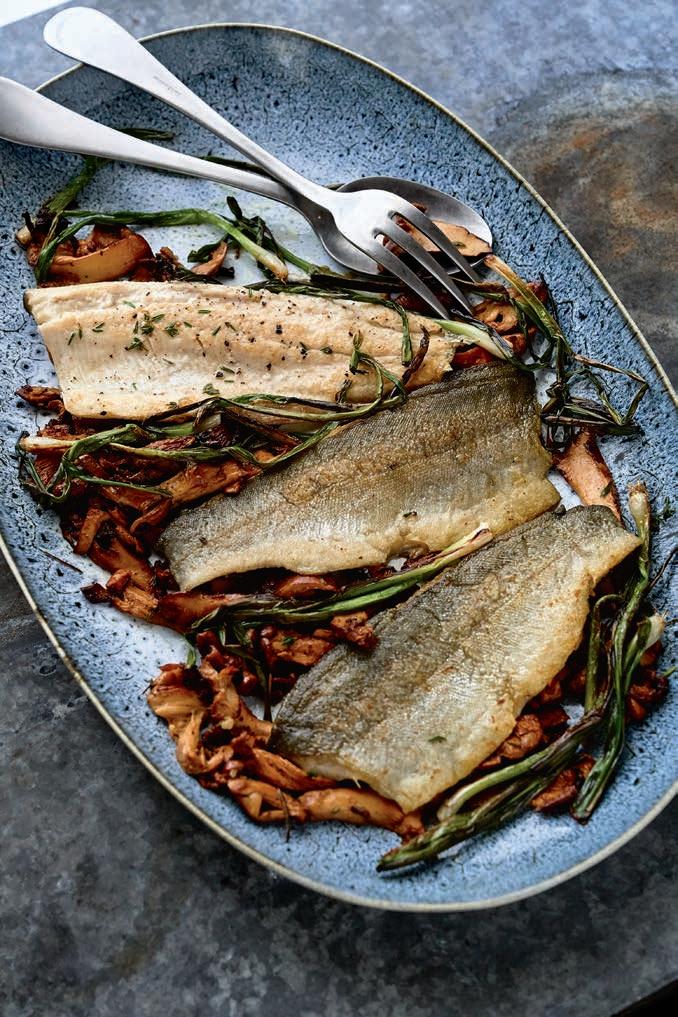
homes and campsites. Pelley grew up coming here, fishing and playing in the woods. When his chef training sparked an interest in foraging, he began finding edible treasures everywhere, including the little patches of ground between campsites. “People see me out here and think, What’s that Pelley kid up to now? ” he said as he piloted the golf cart around the property. Once we had loaded up on edibles like sweet fern and goldenrod, he cooked up a delicious meal over a campfire, including this recipe for trout with wild mushrooms.
TOTAL TIME : 40 MINUTES
H ANDS- ON TIME : 40 MINUTES
A little advice on substitutions here: If you can’t find trout, swap in branzino. Wild mushrooms can be pricey, so feel free to substitute regular button mushrooms—just be sure to build flavor by browning them well over high heat. And if you can’t find ramps, you can use scallions instead.
4 wild or farm-raised trout fillets
½ teaspoon plus 1 teaspoon
kosher salt
¼ teaspoon plus ¼ teaspoon
freshly ground black pepper

1½ tablespoons plus 2 tablespoons
olive oil
½ teaspoon plus 1 teaspoon roughly
chopped fresh thyme leaves
12 ounces wild mushrooms (e.g., hen-of-the-wood, chanterelles),
cut into bite-size pieces
2 cloves garlic, minced
2 tablespoons salted butter
2 ounces whole ramps or scallions, cut into 3-inch lengths
Fresh lemon juice, for drizzling
Pat the trout fillets dry with a paper towel and season all over with ½ teaspoon salt and ¼ teaspoon pepper.
Set a large nonstick skillet over medium-high heat and add 1½ tablespoons oil; swirl to coat. When the oil begins to smoke, add two trout fillets, skin side down, and gently shake the pan to keep them from sticking.


Reduce heat to medium and cook until the skin is golden brown, 2 to 3 minutes. Sprinkle the tops of the fillets with some of the ½ teaspoon of chopped fresh thyme, then carefully turn them over and cook for 1 minute. Transfer to a paper towel–lined plate. Repeat with remaining fillets.

Return the pan to medium-high heat and add 2 tablespoons olive oil. When it begins to smoke, add the mushrooms and remaining salt and pepper. Cook, stirring occasionally, until mushrooms turn golden brown at the edges, then add the remaining 1 teaspoon thyme and garlic. Cook, stirring, for 1 minute, then add the butter. Transfer the mushroom mixture to your serving plate.
Return the pan to high heat and cook the ramps in the residual fat until slightly charred, about 3 minutes.
To assemble the dish, arrange the mushrooms on each plate, add a trout fillet, skin side up (to show off the crispy skin), and garnish with the ramps. Finish with a drizzle of lemon juice. Yields 4 servings.
For more information about Weekends with Yankee or to check local TV listings, go to weekendswithyankee.com. Electric

SEASON 2 PREMIERES APRIL 2018 ON PUBLIC TELEVISION STATIONS NATIONWIDE
(CHECK LOCAL LISTINGS)
CATCH UP ON SEASON 1 AT WEEKENDSWITHYANKEE.COM FUNDED BY:






























On a country road that twists and turns out of downtown Greensboro, a hamlet in Vermont’s Northeast Kingdom, lies a bucket-list destination for beer nerds worldwide. Up and up you go, until you crest a hill and arrive at Hill Farmstead Brewery, a 21st-century beer-maker that happily makes its home in old-world Vermont. Chalk that successful combination up to founder Shaun Hill, 38, who built his business on land that his family has held for eight generations. Hill has serious beer-making bona des: He’s been brewing since age 15, and about a decade ago, while working at a top European brewery, he became one of the youngest people ever to win gold at the World Beer Cup, the Olympics of craft brewing. Hill’s namesake brewery and its widely coveted beers are featured in season 2 of Weekends with Yankee, and recently we caught up with the man himself, soon after he nished brewing an imperial stout.


You started home brewing at such a young age. What was it that attracted you?
I’ve always found fermentation to be magical and mysterious. From my earliest tastes of beer and fermented foods, I was bewildered by how teeny microscopic organisms could produce carbon dioxide, alcohol, and so much avor.
How have your deep ties to your family’s land shaped your business? Our location is one of our greatest assets, but also our greatest liability. Road conditions and our distance from any population center cause a bit of stress and unpredictability in our retail operation. I created the business because of its proximity to my home; however, the customers and the demand are what have made Hill Farmstead what it is today— something much greater than I had ever imagined….
In the nal analysis, I suppose it’s partially the limitations that we have here—and, thankfully, our inability to grow any larger due to zoning and land-use restrictions—that have created our identity.
You’ve said that an old friend once told you, “Luxury is emotion.” Can you describe the emotion you’re aiming for with your beers, and why that’s important?
at particular friend is an incredible wine maker who has dedicated the last 30 years of his life to making the most luxurious of beverages. For me, I know when I have reached my goal [in brewing a particular beer] because I’m overtaken by a chemical and physical reaction…. It overtakes all of my senses and lls me with joy, a body-tingling and contemplative moment of completion. For a producer, these moments are rare, but I believe that many of our customers have had these moments while at our brewery or enjoying our beer. It’s di cult to describe—but some things are best left as metaphor, aren’t they?

In this new column, contributing editor Krissy O’Shea writes from her family farm in central Massachusetts, where four generations have cultivated and cooked with the seasons.
ost of the snow has retreated from the fields around our property, affectionately named Cottage Farm by my great-grandparents. It is early spring, and the earth is wet and smells heavily of the new season. A few wisps of snow remain in the dark hollows down by the pond, but the color green is returning and the world seems bright with birdsong. ¶ The hens are laying again after their winter strike. Making my way to the henhouse for a few brown-shelled eggs, I’m grateful to be back here. Many New Englanders have a story of leaving home for a time, only to realize there’s no other place they’d want to live. For me, it was studying photography in San Francisco, then working as a food stylist and events designer in London, until I could no longer ignore the longing for home. Though I now split my time between the farm and the city, finding inspiration in both, I’m happiest among the stone walls and green fields, in the garden and the kitchen.
From the kitchen window, through the old apple trees flanking the garden entrance, I see the beds that I’ll soon fill with beans, tomatoes, peas, and squash. To the right is the little white henhouse, a patch of broad-leafed rhubarb, and a few early clumps of chive and thyme. To the right again is the barn, with its high peaked cupola and black shutters, that has been standing with the house for more than two centuries. Goats (more pets than livestock) roam the fields, cut off from the forest by a thin silvery fence.
In the gardens, rhubarb is always the first up and a sure sign of spring. I relish its vibrant pink stalks and bracing tartness. This particular recipe is a favorite in our spring kitchen. The sweet-tangy pickled rhubarb and rich buttermilk dressing are the flavors I crave after a long winter of root vegetables. I add farro, a chewy, nutty grain that’s now found in most supermarkets, but you could use a rye or wheat berry instead, or quinoa. The salad is hearty enough for the still-cold spring days, but it hints at the brightness of the growing season ahead.
TOTAL TIME : 50 MINUTES , PLUS
AT LEAST 2 HOURS PICKLING TIME
HANDS- ON TIME : 50 MINUTES
FOR THE PICKLED RHUBARB
4 large rhubarb stalks (or 6 medium), cut into 1-inch pieces
1¼ cups white wine vinegar
½ cup water
¾ cup granulated sugar
6 whole cloves
3 bay leaves
FOR THE SALAD
1 cup (225 grams) farro
4 cups water
Juice of half a lemon
2 tablespoons white wine vinegar
1 small garlic clove, minced
1½ teaspoons kosher salt
Freshly ground black pepper, to taste
½ cup buttermilk
2 tablespoons extra-virgin olive oil
½ cup feta, cubed
1 large cucumber, peeled, deseeded, and cut into ¼-inch half-moons
1 cup fresh or frozen green peas (defrosted)
3 tablespoons thinly sliced mint
3 tablespoons chopped dill
First, prepare the rhubarb: Place the chopped stalks into a 1-quart Mason jar. Put the other ingredients into a saucepan over medium heat and stir until sugar dissolves. Increase heat to high and bring to a boil, then immediately pour over the rhubarb. Cover the jar and let stand until the rhubarb is softened, about two hours. Set aside, or refrigerate for up to two weeks.
Next, make the salad: Rinse the farro, then combine with water in a large pot over high heat. Bring to a boil, then reduce to a simmer and cook until the farro is al dente, 20 to 25 minutes. Drain and transfer to a large mixing bowl. Add lemon juice, vinegar, garlic, salt, and pepper. Let stand 5 minutes, then add buttermilk. Toss to combine. Drain the rhubarb and add to the salad, along with the olive oil; toss to combine. Just before serving, fold in the feta, cucumber, and peas. Top with mint and dill. Yields 4 servings.









After a day of adventure, you’ll find limitless opportunities to surround yourself with amazing company and spectacular views at one of our many restaurants. Whether it’s a casual meal on the water or fine dining in a quiet setting, there’s something here for every appetite.






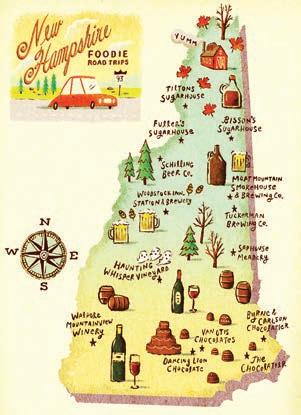

















pring comes early to Exeter, New Hampshire. Maybe it’s due to the proximity to the sea (15 minutes) or possibly to an odd commingling of rivers—one sweet, one salty—behind the shops and cafés leaning into one another along Water Street. There, the Exeter and Squamscott rivers entwine, the ancient lifeblood of Exeter. With waterways leading to Great Bay and on to the Atlantic, the town, founded in 1638, became a thriving seaport without a sea, traversed by schooners and gundalows, bustling with shipbuilders.

There’s revolution in the air, too, centuries old. Exeter’s fine colonial buildings hint at the history churning just below the surface of this early township—one of the first four in the state. Where else might the local electrician (so the story goes) find an original printed copy of the Declaration of Independence stuffed between the floorboards of an old house (the 1721 LaddGilman House, now the American Independence Museum)?
Snugged into an elegant beamed chamber at the Inn by the Bandstand, we are level with the budding treetops, an ideal perch for overlooking history in this town of 14,483. From this 1809 Federal mansion in

 the
the
With memorable meals, antique homes, an elegant inn, and a great bookstore, this river town feels like a coastal retreat without tourists or traffic.PHOTOGRAPHS BY MARK FLEMING
heart of Exeter, we can gaze across Front Street and imagine Abraham Lincoln bringing a crowd to its feet at the town hall on March 3, 1860. Just two blocks away, Lincoln’s son, Robert, was attending Phillips Exeter Academy—that venerable prep school founded in 1781 and immortalized in John Knowles’s classic novel A Separate Peace. Thanks to that institution, Exeter has ties to everyone from Daniel Webster to John Irving to Mark Zuckerberg.
And on busy Water Street, you are still just as apt to overhear students talking about their academy activities, possibly over a perfectly brewed chai latte at D²Java, or under a red umbrella at Laney & Lu Café with
an Epic Egg Sammie in hand. Follow Water Street down to Swasey Parkway, and you can stroll the half-mile path that hugs a riverbank once lined with docks and wharves. You can almost hear the creaking of wooden ships. The Phillips Exeter crew team shoots by, the slender boats slicing through placid waters as you look back at the town. The layers of history fade in and out, but they’re there.

Just eight miles from the coast and 20 minutes from Portsmouth, Exeter is “very well placed,” says Agostinho Nunes, one of the Inn by the Bandstand’s owners. Streets converge around the bandstand designed by
Henry Bacon, best known for the Lincoln Memorial in Washington, D.C. The statue sitting in that memorial was sculpted by Bacon’s friend, Exeter native Daniel Chester French—and it’s worth a ramble down Front Street, past the Phillips Exeter campus, to see French’s bronze World War I sculpture gracing Gale Park. The school melts 672 beautiful acres into the downtown, with walking trails, colonial-era buildings, and a hefty allotment of academic brick, but

the real surprise is its Louis I. Kahn–designed library. The monumental brick cube contains a six-story cement atrium defined by massive circular cutouts. Architecture aficionados visit from around the world.
On Monday nights in summer, Exeter blocks off the streets around the bandstand for concerts featuring the oldest brass band in the country (c. 1847). Swasey Parkway fills up with weekly farmers’ markets, town festivals, and outdoor movies. Kayakers launch into the Squamscott River from the town boat landing beside the Phillips Exeter boathouse. “It’s like a more familyoriented Portsmouth, but without
the tourists and the traffic,” says one young woman, who moved here with her husband four years ago to buy a house and start a family.
And then there’s the American Independence Festival, a post-JulyFourth party with a battle reenactment, a chance to quaff Independence Ale where George Washington ate breakfast, and the arrival of the Declaration of Independence via costumed rider.


Lively cafés such as Me & Ollie’s Bakery (its juicy turkey Reuben is a standout) are multitudinous in Exeter, and there are several serious restaurants, too, including Station 19
and Blue Moon Evolution. But the new star in town is chef Lee Frank’s hot spot, Otis, grafted to the side of the Inn by the Bandstand. Amid the convivial din, a few fortunate diners sit at a bar overlooking Frank’s kitchen, where he conjures tastes to rival those of top New England eateries. (Look for the chef’s-choice sampler of five items, which includes such treats as exquisite red fish with carrot purée.) “You don’t have to go to Portsmouth now to get an amazing meal,”



Set at the base of magnificent Mount Mansfield, Stowe may be renowned for its world-class skiing, but savvy vacationers know it’s much more.

Stowe has all the makings for a memorable getaway in any season. Enjoy the outdoors—take a leisurely stroll with camera in hand, hike to a scenic vista, try mountain biking or even zip lining. Or enjoy a quiet day indoors, luxuriating in a first-rate spa experience. Whatever you prefer, Stowe has you covered. The vibrant yet historic village teems with unique shops and art galleries, excellent restaurants with locally sourced cuisine, and lodging choices that run the gamut from full-service resorts to country inns and cozy B&Bs.
DINE At the casual Bistro at Ten Acres Lodge, the draw is more than just what’s for dinner. The popular lodging spot offers mountain views, a relaxing atmosphere, and a fireside lounge, while the Bistro menu draws raves for its flavorful seafood and delicious roasted meats. And even the classic burger reaches new heights— buns, mustard, chips, and pickles are all house-made.

802-253-6838
tenacreslodge.com
DO Nestled near the edge of Stowe Mountain Resort, Spruce Peak Performing Arts Center’s intimate and inviting 420-seat venue is worthy of a peek for its architectural details (warm wood paneling, Vermont slate flooring, and hand-forged chandeliers), but the films, shows, and events are what keep the place hopping yearround.

802-760-4634 sprucepeakarts.org
Stowe is home to three of Vermont’s famous covered bridges, one of which, Gold Brook Bridge (a.k.a. Emily’s Bridge), is supposedly haunted by a local farmer’s daughter who was deserted by her lover in the 19th century. We’ll leave it to you to learn the rest of the story. To visit the bridge, go 3.5 miles south from Stowe on Route 100 to Gold Brook Road, turn left, then travel 1.2 miles and turn left on Covered Bridge Road.
SHOP Make time for browsing at The Stowe Craft & Design Center, where shopping is both a fun and an inspirational adventure. Step through these doors and be introduced to hundreds of exceptional artisans through the varied products for sale— from quality furnishings and durable kitchenware to jewelry and much more.
802-253-4693
stowecraft.com

says bartender Mike McGuane, who points out that not long after our visit, Frank will be the featured chef at the James Beard Foundation in New York.

Shopping Water Street Bookstore exists in another dimension—the one where time disappears as you absorb a few

hundred whip-smart book commentaries taped to the shelves. (You’re practically guaranteed to go home with a book you never dreamed of buying, too.) To move beyond armchair adventures, Travel & Nature offers a dense forest of Patagonia, Marmot, and Osprey gear. Home furnishings veer into “swanky salvage” at Honey hole, a tiny storefront
with eclectic items ranging from local Beeline Skin Care products to a highend leather messenger bag. “We like to do an antique twist without being old and stuffy,” says Honeyhole owner

Explore the California Coast with Caravan; Call Now for Choice Dates; Free Brochure: 800-CARAVAN, Caravan.com




See the very best of the Golden State on a fully guided Caravan Tour—Join the smart shoppers and experienced travelers who rely on Caravan.
Your California Coast Itinerary
Day 1. Welcome to the romantic city by the bay, San Francisco.
Day 2. See the majestic Coastal Redwoods at Muir Woods, and enjoy wine tasting at a Sonoma vineyard.
Day 3. To the Sierra Nevada Mountains, and through historic gold mining towns of the great California Gold Rush. Visit Yosemite National Park.
Day 4. Visit Monterey, with free time at Cannery Row. Enjoy 17-Mile Drive, and see dramatic vistas on the Big Sur, one of the world’s most awe-inspiring coastal drives. Stay on Monterey Bay.
Day 5. Stop and look for seals resting along beach. Visit to Hearst Castle.
Day 6. Visit to Santa Barbara Mission. Free time to explore Santa Monica Pier. Enjoy two relaxing nights in LA.
Day 7. Explore Hollywood attractions.
Day 8. Return with great memories.
Detailed Itinerary at Caravan.com

days $1495
Canadian Rockies 9 days $1795
Grand Canyon & Zion 8 days $1495

California
Mount
New
“San Francisco, Carmel, 17-Mile Drive, Redwood Grove, I loved it all!”
—Client, Westchester, Ohio
“ Brilliant, Affordable Pricing”
—Arthur Frommer, Travel Editor
Experience the heart of Ogunquit at your door every season of the year—lobsters and lighthouses, sandy beaches and sunsets, world class dining and relaxation.
Let us help you begin a Maine tradition today.




Heather Dubina, who with her husband, Brian, works rehab magic.

At the time of our visit, a pretty intown 1875 colonial with three bedrooms and a garage/barn listed at $389,000. Another 1875 beauty— this one needing a bit of cosmetic love and updating—was selling for $244,000. And a pristine 1900 gem with three bedrooms, a new kitchen, and original tin ceilings, situated within walking distance of town, listed at $424,000.
What other town feels so closely tied to U.S. history that it doesn’t celebrate the Fourth of July—choosing, instead, to reenact the day that the Declaration of Independence was delivered to Exeter, on July 16, 1776? Apart from having a peephole into history (check out the American Independence Museum for unexpected treasures like a Purple Heart awarded by George Washington), Exeter residents enjoy being just minutes from the ocean. And if a city hankering hits, you can hop the Amtrak Downeaster into Boston for $16. Then there’s the free parking—always a friendly gesture in any town.



The Inn by the Bandstand is lovely, and its breakfasts are downright delicious. But owners Agostinho Nunes and Jaime Lopez go beyond hospitality: They create a home away from home. While we were there, a Phillips Exeter student called to ask if he could stop in for breakfast—and he brought friends. The inn is both “a heaven and a haven,” wrote one guest from Dublin, Ireland. We really could live here . innbythebandstand.com
For more photographs of our visit, go to newengland.com/exeter-2018.

Since 1994, educating visitors about the WWII-era Americans called, “the greatest generation”. See extensive 1939-45 Home Front displays; vintage tanks & weapons; period art & music and more. Please join us for these 2018 Special




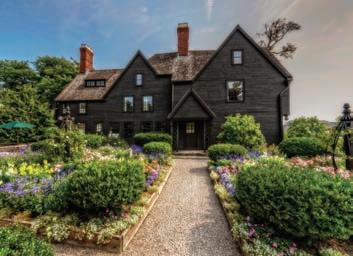











Associated Press Photos of WWII – May 1-Jun 17 Korea, The Forgotten War – Jun 24 – Aug 12 Manufacturing Victory, Arsenal of Democracy –Aug 20-Oct 31

 BY KIM KNOX BECKIUS
BY KIM KNOX BECKIUS
hough springtime is finally in sight, for some of us it just can’t come soon enough. When the last of the snow is gone—or likely even weeks before that happens—we start yearning for everything to be green and warm again. Luckily, instant gratification can be had at our favorite year-round gardens under glass, which offer a taste of spring long before New England thaws enough for the first brave daffodils to emerge.
When this greenhouse’s most famous inhabitant—a gargantuan corpse flower nicknamed “Morphy”—comes into bloom, as it does every half dozen years or so, thousands turn out to experience its notorious stench. Although Morphy is back under the radar until 2021 or 2022, a dose of summer can be had every weekday at this handicapped-accessible teaching facility filled with 1,000 different orchids and 600 or so tropical, subtropical, and succulent plants. Labels reveal more than just the plants’ IDs, as curator and manager Kim DeLong is passionate about digging into their beneficial uses, too. Feel like lingering awhile? You can even “picnic” in the foliage-filled multipurpose room. Hanover, NH. 603-646-2382; dartmouth.edu
If the world has seemed a bit monochromatic for too many months, you can enjoy a more tropical palette while nibbling poached shrimp and sipping a melon mai tai beside a waterfall—all without leaving New England. In this four-story hotel lobby, where enormous presses cranked
out Glamour and Vogue back when Condé Nast was based here, 50-foot ficus trees have thrived since they were planted about 35 years ago. The Gazebo Bar & Grill and Winfield’s restaurant are both sheltered within this tropical garden, which has nighttime lighting to amp up the romance. Even a simple patch of grass—one of the trickiest crops to grow indoors—is reassurance that winter’s checkout time is near.
Old Greenwich, CT. 203-637-1234; greenwich.regency.hyatt.com

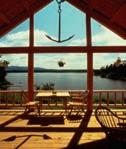







You might call William D. Logee the P.T. Barnum of plants: In 1900, when his nursery business was just eight years old, he bought a Ponderosa lemon tree whose fruits weigh more than most Chihuahuas, and which people still come to see. Wandering the six greenhouses and retail shop at this familyowned exotic-plant purveyor is part
scavenger hunt and part free therapy. The begonias alone seem to defy some law of maximum variation, and unusual new plants join the circus—and star in the vibrant Logee’s catalog—season after season. Danielson, CT. 860-7748038; logees.com

The urge to shed layers will hit you almost as quickly as the perfume of jasmine, bougainvillea, and citrus as you close the door of one of America’s oldest greenhouse complexes behind you. Theodore Lyman’s yen to grow tropical fruits was so intense that the first greenhouse (c. 1804) at his Waltham estate was completed even before the ballroom. Newly renovated for better accessibility, the four brick-and-glass structures burst with a variety of living oddities and heirlooms, and plant collectors eagerly purchase horticulturist Lynn Ackerman’s latest propagations.
Visit in March to see the 1820 Camellia House’s century-old specimens in radiant bloom. Waltham, MA. 617-9945913; historicnewengland.org



Koi fish circle in a peaceful pond. Water splish-splashes in fountains. An immense blue agave seems poised to climb out of its bed. Cameras click, and couples kiss … even if they haven’t rented this sunlit sanctuary for their wedding. In short, there’s nothing static about New England’s largest indoor garden, a 23,000-square-foot terrarium that shows off plant life in its myriad forms, from delicate flowers to spiky cacti to pest-eating carnivorous species. Frequent public events include talks on gardening topics and opportunities to create in this inspiring space. Providence, RI. 401-680-7263; providenceri.gov/botanical-center

BEST COLLEGE-TOWN LODGING THE BRUNSWICK INN BRUNSWICK, ME
Authentic charm and elegance in the heart of Brunswick. Sixteen beautiful guest rooms offer modern amenities with the personal service only a small inn can provide. Complimentary fresh breakfast made with local ingredients served by a roaring fire. Full bar.
brunswickinn.com

MAINE
NEW HAMPSHIRE
VERMONT
MASSACHUSETTS
CONNECTICUT
RHODE ISLAND
Each year, the editors of Yankee Magazine scour our region’s six states to find the best attractions, dining, lodging, and shopping for inclusion in our “Best of New England” awards. Enjoy this collection of current and past winners.


BEST FAMILY INN THE NONANTUM RESORT KENNEBUNKPORT, ME
Traditions begin here. Enjoy the seasonal family activities program, kayak and bike rentals, outdoor heated pool, magical fairy garden, scenic lobster boat cruises, and trolley tours! Close to the beaches and Dock Square shops. TripAdvisor Certificate of Excellence winner.

888-205-1555
nonantumresort.com
BEST GIFT STORE GALLERY GIFTS AT 136
DAMARISCOTTA, ME
Gifts at 136 offers a large selec-tion of fine crafts and art from Maine, including furniture, paintings, sculpture, jewelry, pottery, glassware, lighting, and more. Gifts at 136 has won multiple awards for its wellcurated collection of accessible art. Open all year.
207-563-1011
www.giftsat136.com
The Grand at the Bedford Village Inn embraces what’s new and next for boutique hotels. Four restaurants, year-round outdoor heated saltwater pool and spa, fitness facility, lobby bar, and event space. Relax at our brandnew Luxe Spa spa. Lovely gardens on 10 acres. Sixty-four elegant rooms with marble baths and separate rain shower heads. Most with soaking tubs, some with fireplaces.
800-852-1166
www.bedfordvillageinn.com

A must-see New England destination that tells the story of Plymouth Colony in the early 1600s and its shared history with the Pilgrims and native people. Visit the 17th-Century English Village, Wampanoag Homesite, Plimoth Grist Mill, Water- front Exhibit, Craft Center, and Plimoth Bread Co.

508-746-1622
plimoth.org


A thoughtfully restored antique property located in one of New England’s most historic districts, this 22-room Relais & Chateaux inn has gorgeous interiors featuring a contemporary twist on the traditional. Its casually elegant, award-winning restaurant, Artistry on the Green, serves regional seasonal cuisine.
781-301-6660
innathastingspark.com
The Amazing World of Dr. Seuss Museum is an interactive, bilingual experience that explores the childhood and stories of Springfield, MA, native Theodor Geisel, aka Dr. Seuss. Five museums and a sculpture park offer Seuss, Science, Art & History–something for everyone!
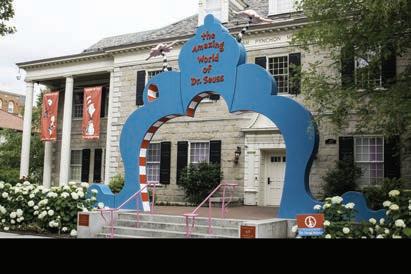
800-625-7738
springfieldmuseums.org
A family-owned, AAA Four Diamond hotel featuring two restaurants, fireplaces, indoor pool, select petfriendly rooms. Book direct and get free breakfast and tea. Complimentary transportation from Amtrak Downeaster station. Two blocks to L.L.Bean. Best shopping in NE.

800-342-6423
harraseeketinn.com
NH
Experience the enchanting cottage that inspired Elizabeth Orton Jones’s Little Golden Books version of “Little Red Riding Hood.” Untouched by time, this is a mecca for gardeners, epicureans and anyone looking for inspiration and relaxation. Have a Pickity day!

603-878-1151
pickityplace.com


APRIL 28
Take this one at fleece value: Sheepshearing demonstrations, knitting instruction, and sheepdog trials are all part of the fun as 60-plus farmers and vendors congregate at the Tolland County Agricultural Center for an annual agricultural celebration that dates back more than a century. Vernon, CT. ctsheep.org
MAINE MAINE
MARCH 25
Come for the nifty syrup-making demonstrations, stay for all the tasty samples. Some 80 Maine sugaring houses are opening their doors to the public today, with activities—games, tours, live music, etc.—varying from one stop to the next. Check the website for a full list of locations. Statewide. mainemapleproducers.com
MASSACHUSETTS
CRAFTBOSTON
APRIL 20–22
Immerse yourself in a world of creativity as nearly 100 artisans fill the Cyclorama at the Boston Center for the Arts with their wares. Look around, learn from the makers, and load up your shopping bag with everything from handcrafted Shaker boxes to luxe leather goods. Boston, MA. 617-266-1810; societyofcrafts.org
MARCH 24–25
Need help getting your landscape shipshape? Head to UNH’s Whittemore Center Arena to check out the latest in home and garden products and services. There’s a full lineup of related seminars and clinics, plus a “Meet the Chefs” cooking series featuring some of the Seacoast’s top culinary talent. Durham, NH. 866-295-6438; seacoast.newenglandexpos.com
RHODE ISLAND
SOUTHEAST NEW
APRIL 24–28
With screenings at locations in Providence and Warwick, a juried art show at the Warwick Center for the Arts, and musical performances to boot, this popular annual event celebrates a decade of bringing people together through art. Providence and Warwick, RI. 401-203-7363; senefest.com
VERMONT
MARCH 3–4
Step right up for this high-flying fund-raising gala hosted by the New England Center for Circus Arts at the historic Latchis Theatre, where students from the program will perform alongside guest artists from circuses around the world. Brattleboro, VT. 802-254-9780; necenterforcircusarts.org
—Compiled by Joe Bills
For more best bets around New England, see p. 80

800.342.6423
THROUGH MAR. 18: HARTFORD, “Agatha Christie’s Murder on the Orient Express.” Eight murder suspects on a train, each seemingly with an alibi. This classic whodunit has detective Hercule Poirot on the case in a stage adaptation by playwright Ken Ludwig and director Emily Mann. 860-527-5151; hartfordstage.org
MAR. 11: NEW HAVEN, Saint Patrick’s Day Parade . Join the other shamrock-waving spectators as this historic parade steps off from Chapel Street for three hours of downtown fun. stpatricksdayparade.org
This family-owned, 93-room luxury inn features two great restaurants, 23 replaces, an indoor heated pool and is fully handicapped accessible. Select pet-friendly rooms available. Walk to the best shopping on the Maine coast and the Amtrak Downeaster train station. Ask about our Yankee Getaway Package. Book direct for complimentary breakfast and afternoon tea.

162 Main Street • Freeport, ME 04032 800-342-6423 • www.harraseeketinn.com MEETINGS
MAR. 17–18: HEBRON, Hebron Maple Festival. At this celebration of the sweet and sticky season, learn how maple syrup is produced during sugarhouse tours and demonstrations, and then savor the goodness with an abundance of mapley treats. Children’s activities, a craft fair, and other activities round out the weekend. hebronmaplefest.com
MAR. 24–25: HARTFORD, Connecticut Spring Antiques Show. This venerable antiques show returns to the Hartford Armory, where it got its start back in 1973. A premier showcase of early American furniture and decorative arts, it’s equally fun whether you’re a novice or a serious collector. 860-345-2400; ctspringantiquesshow.com

MAR. 25: MYSTIC, Irish Parade. With an array of floats and more than 25 marching bands, this parade is easily among the region’s largest. The celebration kicks off from Mystic Seaport’s South Lot and heads into the historic downtown for its “marquis” performance. mysticirishparade.org

APR. 22: NEW HAVEN, Cherry Blossom Festival. Enjoy the sight and fragrance of more than 70 Japanese Yoshino cherry trees in all their glory around Wooster Square, where a full lineup of music, exhibits and demonstrations, kids’ activities, and good food will keep you entertained. historicwoostersquare.org

APR. 28–29: MERIDEN, Daffodil Festival. Now in its 40th year, this annual Hubbard Park event offers a sight for winter-weary eyes, as more than 600,000 daffodils explode with color. Stop by for a stroll through the park, or plan a longer stay and take in the parade, fireworks, craft fair, carnival rides, and more. 203-630-4259; daffodilfest.com

THROUGH MAR. 25: PORTLAND, “Red Herring.” Portland Stage presents Michael Hollinger’s tale of Maggie, a tough Boston cop pursuing a crime boss who gave her the slip—and worked his way into her heart in the process. 207-774-0465; portlandstage.org
FlorenceGriswoldMuseum.org
www.sailmainecoast.com


Ask us about our specialty cruises, too!
MAR. 1–12: STATEWIDE, Maine Restaurant Week. Celebrating the delicious creativity of the state’s independent and locally owned restaurants, this event has gotten too big to be contained within a mere seven days. Check the website for all the locations and events. mainerestaurantweek.com
MAR. 11: ORONO, “Cirque Eloize: Saloon.” The Wild West comes alive as theater and
circus collide in 85 minutes of nonstop live folk music combined with circus performers’ grace and agility. 207-581-1755; collinscenterforthearts.com

MAR. 17–18: LEWISTON, Maine Home Show. The Androscoggin Bank Colisée hosts 100-plus booths of home-related products and services, from lawn care equipment and landscape design to windows and doors, kitchens and baths, insulation, and weatherization. mainehomeshow.com

MAR. 23–25: PORTLAND, Maine Boatbuilders Show. At the Portland Company complex you’ll find this gathering of the East Coast’s finest custom boat builders, as well as manufacturers of boating equipment, all ready to discuss and sell their work. 207-774-1067; portlandyacht.com
APR. 13–15: OGUNQUIT, Patriots’ Day Celebration. Historical characters offer insights into the past with reenactments throughout the weekend, plus a treasure hunt and all-ages activities throughout downtown. 207-6462939; visitogunquit.org
APR. 14: DENMARK, Sheepfest. From humble beginnings in 1995, the sheepshearing festival at the Denmark Arts Center has grown into a much anticipated community event that spotlights the art of shearing and turning wool into all manner of beautiful and useful products. denmarksheepfest.com
APR. 20–22: ORONO, Bangor Flower and Garden Show. Alfond Arena is transformed into a gardener’s dream as more than 100 landscapers, horticulturists, and garden clubs present beautiful floral and garden displays, bulbs, cut flowers, seeds, herbs, greenhouses, water gardens, sheds, and more. 800-237-6024; homeshows.com
APR. 29: BATH, “The Belle of Amherst: Emily Dickinson.” This one-woman play lets you step into the world of Emily Dickinson, with all of its secrets, eccentricities, and passions. A self-described “local character,” Dickinson is compelled to “stop the world” as she creates poems that defy the conventions of her time. 207-442-8455; chocolatechurcharts.org
MAR. 3–18: NORTHAMPTON, Spring Bulb
Show. A spectacular collection of more than 5,000 blooms, from crocuses to hyacinths to irises and more, provides an early glimpse of spring at this long-standing tradition at Smith College’s Lyman Conservatory. 413-585-2740; smith.edu
MAR. 14–18: BOSTON, Flower and Garden
Show. Savor the promise of spring as you collect expert gardening advice, meet retail vendors, and check out floral competitions and more than 20 professionally designed gardens, all at the Seaport World Trade Center. 781-237-5533; bostonflowershow.com
MAR. 17–18: DUXBURY, Spring Antique Show. More than 50 vendors from across New England gather at Duxbury High School, offering a wide variety of vintage American and European items for sale. duxburyboosters.org
MAR. 18: BOSTON, South Boston’s Saint Patrick’s Day Parade. Southie takes pride in
hosting one of the largest Saint Paddy’s parades in the country. Claim a spot along the three-mile route and you’ll see enough bagpipers, military units, bands, clowns, and characters to keep you—and the kids—smiling. 844-478-7287; southbostonparade.org
APR. 14–16: LEXINGTON/CONCORD, Patriots’ Day Weekend. Minute Man National Historical Park pays tribute to the opening battle of the American Revolutionary War with parades, reenactments, and commemorative ceremonies, with festivities culminating in the Lexington Patriots’ Day parade. 978-318-7825; nps.gov/mima
APR. 20–22: MANSFIELD, New England Folk Festival. Hosted by area schools, this 74th annual event offers plenty of music, dance (both participatory and performed), and crafts, plus food, kids’ activities, and more. 617-299-1590; neffa.org
APR. 26–29: VINEYARD HAVEN, Spectrum Film Festival. The Martha’s Vineyard Film Society presents a four-day film festival at the MV Film Center that gives a world perspective on LGBTQ people and issues through films, guest speakers, discussions, and a special event focused on LGBTQ youth. 508-696-9369; mvfilmsociety.com
APR. 28: WALTHAM, Sheepshearing Festival at Gore Place. Take to the lawn of one of the great estates of the Federal period, Gore Place, for a day of herding demonstrations by border collies, shearing and spinning demonstrations, live music, historical reenactments, and a craft fair. Don’t miss a chance to tour the estate while you’re at it. 781-8942798; goreplace.org
MAR. 10: NORTH CONWAY, Hannes Schneider Meister Cup. Combining the thrill of modern skiing with the warm nostalgia of yesteryear, this competition honors the father of ski instruction, with proceeds going to the New England Ski Museum. 603-823-7177; newenglandskimuseum.org
MAR. 17, 24, 25, 31, APR. 1, 7: BETHLEHEM, Maple Experience at the Rocks. Discover the history of maple sugaring, participate in the process of tapping trees and making syrup, and enjoy the views on horse-drawn wagon rides through this scenic 1,400-acre property. Reservations recommended. 603-4446228; therocks.org
MAR. 24: MOUNT WASHINGTON VALLEY, March Maple Madness. Ticket holders can embark on a self-guided inn-to-inn tour, sampling tasty delights along the way. Collect recipes and participate in a scavenger hunt while seeing how maple syrup is made. bbinnsmwv.com
MAR. 24: PORTSMOUTH, The Moth Mainstage. An evening of true stories, told live at the Music Hall. The Moth features a mix of national storytellers and local voices, including luminaries in the arts and sciences, news makers and news breakers, everyday heroes, and even a reformed villain or two. 603-4362400; themusichall.org
MAR. 24–25: STATEWIDE, New Hampshire Maple Weekend. More than 100 sugarhouses across the Granite State invite you to stop by for a peek into the sugaring process. Enjoy samples and varied activities at each stop. See the website for locations. 603-225-3757; nhmapleproducers.com
APR. 19—22: KEENE, Monadnock International Film Festival. Downtown Keene comes alive with feature films, documentaries, short films, and juried shorts, plus a full lineup of parties and meet-and-greet events for those who’d like to get to know some of the filmmakers. 603-522-7190; moniff.org
MAR. 13–18: PROVIDENCE, “An American in Paris.” The Tony Award–winning musical about an American soldier, a mysterious French girl, and an indomitable European city, each yearning for a new beginning in the aftermath of war, comes to the stage at the Providence Performing Arts Center. 401-421-2787; ppacri.org
MAR. 17: NEWPORT, Saint Patrick’s Parade and Family Celebration. Enjoy the parade as it kicks off at City Hall, then stick around for family-style, alcohol-free entertainment with Irish step dancers, pirates, live Irish music, face painting, contests, and giveaways. 401-846-5081; newportirish.com
MAR. 24: WOONSOCKET, Tommy James and the Shondells. With more than 100 million records sold, nine gold or platinum albums, and 23 gold singles to their credit, the legendary rockers responsible for such hits as “Mony Mony” and “I Think We’re Alone Now” appear at the Stadium Theatre. 401-762-4545; stadiumtheatre.com
APR. 5–8: PROVIDENCE, Rhode Island Home Show. The biggest home show in southern New England returns with its signature interior design showcase and lovely walkable landscapes, as well as hundreds of contractor and product exhibits, seminars, and cooking demonstrations. 401-438-7400; ribahomeshow.com
APR. 21–22: NORTH KINGSTOWN, Garden Party Quilt Show. The Narragansett Bay Quilters’ Association hosts its biennial show at North Kingstown High School, where hundreds of member quilts will be on display. Attend classes and lectures, meet vendors, and try your luck at raffles. nbqa.org
APR. 25–28: PROVIDENCE, Eat Drink RI Festival. A star-studded lineup of more than 80 Rhode Island farmers, chefs, bartenders, and food and drink artisans returns to downtown Providence. Look for tastings, demonstrations, and plenty of dining and cocktail opportunities, culminating in a grand brunch. eatdrinkri.com
APR. 29: SAUNDERSTOWN, Spring Fair at Gilbert Stuart Birthplace and Museum. Pay a visit to the birthplace of the 18th-century master portrait artist Gilbert Stuart during this spring fair, and you’ll be just in time to view the river herring migration up the fish ladder. Enjoy an afternoon of corn
grinding in the gristmill and demonstrations of spinning, weaving, and rug hooking; house tours; and kids’ activities. 401-2943001; gilbertstuartmuseum.com
THROUGH MAR. 18: WHITE RIVER JUNCTION, “Disgraced.” Ayad Akhtar’s Pulitzer Prize–winning play comes to the Barrette Center for the Arts. When a successful PakistaniAmerican lawyer and his artist wife host a dinner party, what starts out as a friendly conversation escalates into something far more revealing, and damaging. 802-296-7000; northernstage.org
MAR. 3–4: BURLINGTON, Home Show. Vermont’s largest home show returns to the Sheraton Conference Center with more than 200 booths, representing the region’s finest builders, remodelers, and businesses offering all things home-related. 800-237-6024; homeshows.com
MAR. 16–24: MONTPELIER, Green Mountain Film Festival. Whether you’re a hard-core film buff or more of a casual moviegoer, you’re sure to find a wealth of appealing options among these feature films, documentaries, shorts, and award-winning animated tales from all over the world, screened at multiple venues around town. 802-917-1225; gmffestival.org
MAR. 24: PERU, Spring Fling. Bromley Mountain offers family fun with live music, a pond skimming contest, and a duct tape derby in which you can ride your cardboard creation to glory. 802-824-5522; bromley.com
MAR. 24–25: STATEWIDE, Maple Open House Weekend. Celebrate the maple syrup season by visiting a sugarhouse to learn about Vermont’s first agricultural crop of the year. Check the website for an open house near you. 802-8589444; vermontmaple.org
MAR. 30–31: WOODSTOCK, Baby Farm Animal Celebration. Come visit Billings Farm this weekend, and you may want to take a wagon ride, learn about heirloom seeds, and tour the 1890 farmhouse—but be sure to save plenty of time for the lambs, chicks, and calves, who are the real stars of this show. 802-457-2355; billingsfarm.org
MAR. 31: WEST DOVER, Winter Brewers Festival. Toast the end of the winter season with lots of great beer at Mount Snow. More than 20 different breweries will be on hand, and 50-plus taps will dispense ales, stouts, lagers, ciders, and everything in between. 800-245-7669; mountsnow.com
APR. 20: RANDOLPH, Camerata New England. This celebrated chamber ensemble makes its debut at the Chandler Center for the Arts with works by Dmitri Shostakovich, Antonín Dvoˆrák, and Edward Elgar. 802-728-6464; chandler-arts.org
APR. 27–29: ST. ALBANS, Vermont Maple Festival. Downtown St. Albans offers the scenic backdrop for a pancake breakfast, road race, carnival, parade, and, of course, plenty of tasty maple treats. 802-524-5800; vtmaplefestival.org
A special report on the New England environment: where we are ... and where we’re headed.
Rising Seas (p. 84)

Two Voices, One Message (p. 92)
Green Milestones (p. 102)
Ghosts of the Northern Forest (p. 104)
Beyond Beauty (p. 110)
Our Land. Our Sea . Our Future.
NEW ENGLAND WAS BUILT UPON THE COAST. ITS FATE WILL DEPEND UPON HOW WELL WE ADAPT TO A FUTURE THAT CAN NO LONGER BE IGNORED.


n the morning fog the captain moors his boat, the Osprey. We can’t see Great Duck Island, which is only 250 feet away. The 46-foot boat, which belongs to College of the Atlantic, is bringing professor John Anderson and four students back to the island this morning, 16 miles from Bar Harbor, Maine, to continue their bird research.
Two students get into an orange inflatable landing boat that’s tied to the Osprey ’s stern. It’s packed with gear—watertight boxes and plastic jugs and backpacks and two long oars in case the outboard motor quits. Everything has to come to the island on this rubber craft: peanut butter, potable water, gasoline, lumber (three planks on this trip), and propane tanks.
The boat’s silhouette disappears in the fog, and moments later the fog thins so that the day is both occluded and bright at the same time. I can see the island’s little white boathouse, the only building on this shore, and the long ramp down to the water.
I board for the next landing. Arriving at the island, the orange craft runs right up the slippery ramp, which looks like a wet roller coaster track, and Anderson immediately walks me out about a quarter of a mile, no more, from the boathouse. Great Duck is a mile and a half long and all of 220 acres. At a time when gulls were hunted to near extinction, Great Duck was home to the last big gull colony on the East Coast. The Nature Conservancy acquired the island in 1998, and today shares it with the college, the state of Maine, and a private summer resident. The college owns about 12 acres, which includes the lighthouse, the head keeper’s house, and two boathouses.
We walk on an old track through a wind-thrown spruce forest until we come to a low meadow sitting before the next rise. Like a good teacher, Anderson lets me look things over, saying nothing, until I ask him for an explanation.
“You’re basically at sea level, where you’re standing right now,” he says. “This is very typical of a lot of the islands up and down the coast.” We are standing in a “surge channel” between two small granite domes. A natural seawall of cobbles keeps the sea out—for now. The sea has rushed in twice in the recent past, during a hurricane in the 1930s and when
a big winter storm in the 1960s filled the channel for weeks.
“With a six-foot sea-level rise”—one current forecast for the end of the century—“we’re not going to have Great Duck anymore. We’re going to have Little Dinky Duck and Medium-Sized Duck,” he says. “And this is going to be a sea channel.”
Anderson reviews some of the islands he has studied for Acadia National Park. Shabby Island is a marsh surrounded by a rocky berm—“end of island,” he says. Great Spoon Island has some higher places for the gulls to nest, but all the prime eider duck habitat will flood out. Schoodic Island, Acadia’s main seabird island, “will be reduced to three chunks of rock. No eiders, no guillemots. Little bit left for cormorants and gulls, but all pressed together in a very small space. I don’t think they’ll stay. The low islands are in trouble.”
Walk a few hundred yards on this one small island, and you can see that the rising sea is about more than seawater and shorelines.
For months I’ve been turning up along the coast and saying: Show me what we’re going to lose, show me what will be underwater, show me the shape of things to come. In each place I am standing at the corner of Loss and Change. And in each place I have the same conversation: This is changing—fast. This conversation is going on all along the East Coast and, in fact, the world over.
I’ve been rowing against my own belief in rock-steady traditions, in wanting to believe that the iconic landscape that we all love—the islands of Maine, the famous coastal towns, you name it—will abide. That it will all be the same as it ever was, the same when the next generations discover this place. But that is no longer our future.
Think of the coast as a long necklace of beloved places, coves and marshes, peninsulas, docks and bays, clam shacks and lobster pounds and ice cream stands. Summer lives here. Summer stories are about the joy of returning to the same treasured haunts every year. Everyone gets older, children leave home, careers flourish or stall, but come summer, people can head to their favorite beach, or B&B, or family retreat. They can exhale. They can do as they have done since they can remember.
When just one of those places closes, it’s like a thread snaps. It’s like a rude shove in the back, a push to keep on moving along your life’s short timeline. The yearly pilgrimage, the eternal return, is cut off, and people miss it deeply. Now magnify that by a thousandfold up and down the coast, from Maine to Connecticut. Good-bye to beaches, marinas, beach houses, marshes, lighthouses.... Who can face that? I know I can’t.
In the history of life on Earth there have been five mass extinctions, periods in which thousands of species died off. We’re living in the midst of the sixth mass extinction, say scientists, the greatest since the dinosaurs vanished, and we’re causing it. “No other creature has ever managed this, and it will, unfortunately, be our most enduring legacy,” writes
“THE GULF OF MAINE IS WARMING FASTER THAN ANY OTHER BODY OF ITS SIZE IN THE WORLD. WHEN YOU HAVE THAT SORT OF SHIFT IN TEMPERATURE, ALL KINDS OF OTHER THINGS HAPPEN.”
College of the Atlantic professor John Anderson warns that rising sea levels could wipe out vital seabird nesting sites on Maine’s low-lying islands, including Great Duck Island, shown on the previous spread.
Pulitzer Prize–winning journalist and author Elizabeth Kolbert.
What’s happening in the Gulf of Maine is a part of this great dyingoff. Maine’s islands are home to about 50 percent of all nesting seabirds in the eastern United States—and that population is in turmoil.
Seabirds are “declining very, very rapidly,” says Anderson. “Depending on who’s doing the numbers, we’ve had between a 40 and 70 percent decline in gulls here in the Northeast in the last decade. If this were any other group of birds, we’d have headlines and national boards of inquiry, but because it’s just gulls, nobody cares. But we care—and part of what makes us very nervous is that everybody is seeing a big decline in gulls all around the northern North Atlantic.” Bird by bird, we are losing the world.
Anderson, 60, is an impressive teacher. Born in New Zealand and raised in Britain, he has taught ecology and natural history at College of the Atlantic for 30 years. In our short walk he has set the Gulf of Maine spinning. It’s a bit much to take in. This is only a glancing tour of the natural and unnatural history of the islands, but the story is all about change. The natural changes and the ones we’ve caused are as knotted up as the storm-wracked fishing lines that wash up onshore. The Maine coast that we see today, the stunning place of deep pine green rimmed with granite, is only 5,000 years old. When you begin to realize that 5,000 years in the earth’s time is but a weekend getaway, you feel the planet spinning, you feel everything moving—including yourself—which is closer to the true condition.
Forget for a moment the distant forecasts, and all the arguments about climate change. We first have to accept that the earth is changing and always has. Now, it is changing

very fast due to our carbon-producing ways. If we can learn to see that marshes move, that barrier beaches belong more to the sea than to the land, then we can begin to listen to what the scientists have been trying to tell us.
We walk to the old head keeper’s house, the college’s headquarters for its island research. The students are getting ready to go to the lighthouse, where they’ll observe the herring gull colony. Later they’ll suit up in black trash bags (for obvious reasons) and walk among the gulls to do a “chick check,” weighing the young in the nests. One student is reviewing the images from cameras she has set out to watch the burrows of Leach’s storm petrels. They are the most numerous birds on the island—about 5,000—making this the largest studied petrel colony in the eastern United States, a point of pride for Anderson and his students.
When Anderson did his three-year study for Acadia National Park on the future of the major seabird islands, he had to keep revising his forecast. The climate scientists kept increasing their estimate of how much the sea will rise—it’s the fastest rise on record for the past 28 centuries. Scientists are shocked at how fast the earth is warming, with each year’s temperatures topping the previous years’. The ocean science is complicated. The ice melts, the sea rises; the sea warms, water expands, the sea rises more; the water becomes 30 percent more acidic; the Gulf Stream may slow, with dire consequences. We’re conducting an irreversible, Earth-sized experiment.


“The Gulf of Maine is warming faster than any other body of its size in the world. When you have that sort of shift in temperature, all kinds of other things happen,” says Anderson. The temperature had been rising by 1 degree Celsius every 40 years; it’s now warming up 1 degree every four years. In water just a couple of degrees warmer, the oxygen content is reduced, and some fish, such as tuna, can’t survive. Algae blooms and pathogens increase.
“One of the immediate problems is softshell, which is a fungal infection that basically makes lobsters look like Frankenstein’s monster,” Anderson says. One-third of lobsters in southern New England have the disease, and it’s creeping north. Lobsters make up three-quarters of the value of Maine’s fishery, and while there have been record catches recently, there are signs of trouble, too, such as a decline in the number of the youngest lobsters. Scientists know it’s difficult to predict the lobster population. And it’s getting more difficult as climate change is creating what they are calling a “brave new ocean,” an ocean they don’t understand.
The Gulf of Maine, on the eve of great changes, is already stressed. The planet is on course to exceed the limit set in the international climate agreements: holding warming to a 2 degree Celsius (3.6 degree F) increase. An Earth hotter than that could bring down civilization, say the climate scientists. Though it’s widely accepted that there’s going to be a significant loss of ice at the poles, “that’s not actually the worst-case situation,” Anderson says. “Worst-case situation is the Antarctic ice shelf goes. If the Antarctic ice shelf goes, Bar Harbor goes with it. It’s not just going to be seabirds. It’s going to be New York.”
Anderson is sitting on an old couch under some maps of the island. And while his British accent never loses its crispness, he is weighed down by what he’s saying. He slumps deeper into the couch. It’s one of those moments when people speak directly and say, Here, this is the burden I carry.
“And honestly,” Anderson continues, “I don’t worry about
wildlife and global warming. All of the species you’re looking at have survived massive periods of global warming, global cooling. The thing that I’m really terrified of is how these guys are going to deal with global warming and seven and a half billion humans not dealing with it very well.” His frankness is jarring.
Superstorm Sandy, which caused $65 billion in damage in 2012, making it second only to Hurricane Katrina, was just a modest storm. Sandy, many say, was a preview. “Imagine when we get a real superstorm, when we’ve had six feet of sea-level rise,” Anderson says. “The whole of Lower Manhattan is going to go under. What are we going to do with six million New Yorkers? That’s the question. We’re also going to lose New Orleans. And we’ve got two choices at this point: We can evacuate New Orleans carefully and slowly and deliberately, finding new places for people to live, finding new jobs for them, settling them in better places. Or we can evacuate them in the rain on buses with what they can carry. The one thing we don’t get is, we don’t get New Orleans. My students are going to live to see this.”
From Connecticut’s Fairfield County to the Maine peninsulas, a rising sea would whittle away at the entire New England coast (shaded red ). Especially hard-hit: Boston, where the same sixfoot rise (inset, shaded blue) would not only inundate the harbor area but flood into Cambridge, the Back Bay, the South End, and even Fenway Park.
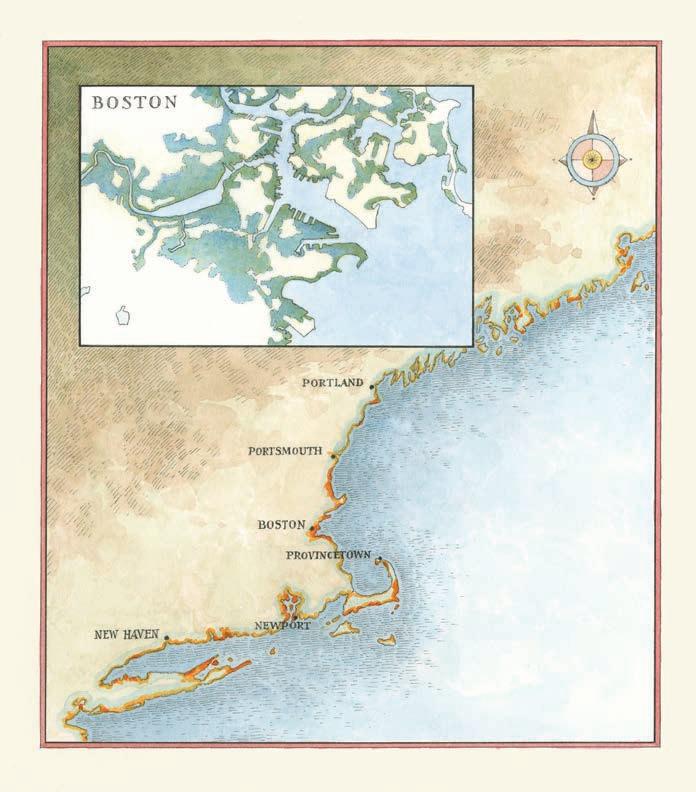
And yet here we are. It’s a glorious day. The fog gathers, thins, and gathers. The students are busy counting chicks, studying the gulls. “Think of how lucky we are,” says Anderson. “We’re getting paid to drive around the coast and look at beautiful birds and beautiful islands. Isn’t this a wonderful place?”
In the 19th century, fishermen in the North Sea off England would sometimes pull up odd things in their nets. Clumps of peat. Deer, bison, bear, and horse bones. How strange, they thought. How did these animals get 60 miles from shore? As trawling increased in the 20th century, they found more things. In 1931 a trawler brought up a harpoon carved from an antler. A beautiful object, like something the Inuit would make.
With the boom in North Sea oil, the sea floor was extensively mapped, revealing the valleys, rivers, lakes, and hills
of a lost land. The archaeologist Bryony Coles named this place “Doggerland” in a 1998 paper. Part of it was located on what today is Dogger Bank. Doggerland connected England to Norway, Denmark, the Netherlands, and northern Germany. There was no North Sea. The English Channel was a tidal estuary, a river snaking through a marsh to meet the sea. Then, as the great ice sheets up north began to melt, the sea rose, the English Channel formed, and Doggerland became, after many years, an island. Small bands of huntergathers lived off the salmon run for months. As the sea rose, the marshes flooded, the land flooded, and at last on a day lost in prehistory, about 7,600 years ago, Doggerland’s people left for England. Today there are people in Britain and Australia who can trace their lineage to Doggerland. DNA tests link them all the way back to that North Sea Atlantis.
Doggerland is not something most people know about, but it is now squarely in our future.
Doggerland is our story. Under the current forecast from the scientific research organization Climate Central, about 760 million people—more than 10 percent of the world’s
population—will be left homeless in the next century by the rising sea. Each bit of warming today locks in the changes for centuries to come.
A n American Doggerland is already happening. Half our population and a legion of museums and historic sites are on the coast. “Many of the United States’ iconic landmarks and heritage sites are at risk as never before,” says the Union of Concerned Scientists. The Statue of Liberty, Ellis Island, and Faneuil Hall lead a list that includes the Kennedy Space Center, Hawaiian sacred sites, and enough historic cities and museums to fill the itineraries of untold vacations. Liberty Island flooded during Sandy, forcing the Statue of Liberty to close for more than eight months. In Boston, if Sandy had hit just six hours later, at high tide, more than 6 percent of the city would have flooded. Boston has weathered extreme high tides (three and a half feet above average) 21 times since official records began in 1921—half have occurred since 1994. By midcentury, Boston could see a “100-year flood” every two to four years, and every year by the century’s end.

century this “birthplace of America” will be underwater. Museum curators and preservation experts are among the first to realize the new realities of an American Doggerland. In March 2016, 350 professionals met in Newport, Rhode Island, for the first-ever “Keeping History Above Water” national conference. Sarah Sutton, a museum consultant, summarized the situation: “If you’re within two to seven feet of sea level today, then saltwater is in your future this century. If, like many early cultural sites, yours was built on land that was once wetland, then saltwater is already in your basement. What to do: document, protect, salvage, move, or abandon?”
Think of our museums and historic and archeological sites like that treasure of antiquity, the lost Library of Alexandria, says anthropologist George Hambrecht. “It is incredibly valuable, and it’s on fire now.”
In the basement of the Shapley-Drisco House, the sea is rising. High tide covers the bottom steps of the basement stairs; the ocean is just a couple of feet below the first floor. Upstairs, some floorboards have popped free and the brick in the fireplaces is crumbling.
The Shapley-Drisco House belongs to the Strawbery Banke Museum in Portsmouth, New Hampshire. The two-family house has been restored to reflect two different times, 1795 to the right, as you enter, and the 1950s to the left. To that, add the 21st century asserting itself in the basement. This house lives in three centuries, one of which, unseen by museum visitors, threatens the other two. The Shapley-Drisco House faces what was once Puddle Dock, where the tides rose and fell eight feet. Before Portsmouth was settled, Puddle Dock was a tidal estuary. Between 1905 and 1908, it was filled in. Now the sea is returning. At high tide, saltwater is only two feet below the broad central lawn that replaced the old waterway. The basements of the four houses facing Puddle Dock are “right on grade with saltwater infiltration,” says Rodney Rowland, the museum’s director of facilities and special projects. Beyond Puddle Dock, a small rise puts much of Strawbery Banke about 10 feet higher, but not out of danger.
The changes are coming fast. Archeologists are adopting triage, the practice of battlefield medicine that sorts among the wounded, as they rush to work on coastal sites that are being wiped away by storms. About 95 percent of the National Park Service’s archeological sites on the historic Virginia island of Jamestown will likely be lost in 50 years, and by the end of the (continued on p. 128)

Though more than 150 years separates the lives of George Perkins Marsh and Bill McKibben, little else does. Both passionate Vermonters, they helped shape today’s environmental movement with their clarion calls to respect and protect the natural world—and their warnings of what that world might look like if we don’t take action.



You know Henry David Thoreau and you know John Muir and you know Teddy Roosevelt. You probably have heard of Aldo Leopold ( A Sand County Almanac), Rachel Carson (Silent Spring), and Edward Abbey (Desert Solitaire). These are the famous nature lovers of American history, the writer-thinker-preachers we credit with opening our collective mind to the glories of the wild. Dirt under their nails, wind in their hair, they taught us to go slow, to listen close, to wander and wonder and respect and protect and defend and cherish. We heap praise upon them, and rightly so. But what of Vermont’s George Perkins Marsh, born in 1801? Do you know his name?
Few people do. Outside of that green tribe composed of environmental historians, eco-philosophers, professional conservationists, and rangers at Marsh-Billings-Rockefeller National Historical Park, he doesn’t get much play. Within that tribe, though, he’s a prophet, a sage; his book Man and Nature: Or, Physical Geography as Modified by Human Action a kind of bible.
Like any good book, Man and Nature comes loaded with blurbs of praise, in this case provided by famous conservationists a century or more after it was first published in 1864:
“The fountainhead of the conservation movement.” —Lewis Mumford
“Epoch-making.” —Gifford Pinchot
“The beginning of land wisdom in this country.” —Stewart Udall
“The rudest kick in the face that American initiative, optimism, and carelessness had yet received.”
—Wallace StegnerMarsh’s biographer, David Lowenthal, ranks Man and Nature as “the most influential text of its time next to Darwin’s On the Origin of Species , published just five years earlier.” In his introduction to a 2003 reprint, he summarizes the book’s core argument: “Humans depend upon soil, plants, and animals. But exploiting them deranges and may devastate the whole supporting fabric of nature. To forestall such damage we need to learn how nature works and how we affect it. And then we must act in concert to
retrieve a more viable world.” The word ecology wasn’t coined until 1866, two years after Man and Nature came out— but yes, ecological collapse is precisely what’s at stake.
Marsh writes in sterner terms than his biographer, which is part of the fun of his book. A bespectacled polymath with a pudgy face, a round belly, and a thick beard best described as bearlike (black bear in the middle of his life, polar bear near the end), he warns the still-young American republic that “human crime and human improvidence” might reduce the earth “to such a condition of impoverished productiveness, of shattered surface, of climatic excess, as to threaten the deprivation, barbarism, and perhaps even extinction of the species.” He uses the metaphor of a house: We are tearing apart the dwelling we live in, ripping out the floors and doors and window frames to fuel the fire of our wants and needs. And get this: The house can’t be easily rebuilt. “Marsh was the first to recognize that man’s environmental impacts were not only enormous and fearsome, but even cataclysmic and irreversible,” writes Lowenthal. The book’s proposed title, rejected by its publisher, was Man the Disturber of Nature’s Harmonies.

Does any of this sound radical? Is it ear-catching, head-turning talk? By today’s standards—what with every magazine article and TV report pushing doomsday scenarios in which runaway development, fossil fuel consumption, and population growth (to name a few) spell the end of rain forests, shoreline cities, and potable water
(to name a few)—no, this is hardly big news. But try to imagine encountering Man and Nature , all 560 vehement, erudite pages of it, at the time of its publication. The website for the George Perkins Marsh Institute at Clark University offers some context: “The conventional idea held by geographers of the day, Arnold Guyot and Carl Ritter, was that the physical aspect of the earth was entirely the result of natural phenomena, mountains, rivers, oceans.” In other words, humans were one thing, nature something else, and the former had no impact on the latter.
Lowenthal describes the middle of the 19th century as “the peak of Western resource optimism” and says, quite poetically, that New England’s pioneers were caught up in “the myth of limitless plenty.” Between 1791 and the War of 1812, Vermont was the fastest-growing state in the Union. By the 1850s it was almost entirely deforested, much of the lumber going to produce potash and charcoal that provided a cash bonus for the hardscrabble hill farmers doing the cutting. Come 1860, 42 percent of native-born Vermonters had “outmigrated” to places like the Ohio Valley—to the promise of Beyond and the assured abundance of Elsewhere.
“Man cannot at his pleasure command the rain and the sunshine, the wind and frost and snow, yet it is certain that climate itself has … been gradually changed and ameliorated or deteriorated by human action.”
—George Perkins Marsh, 1847PREVIOUS SPREAD : George Perkins Marsh, left, sounded an early alarm about mankind’s effect on the environment— a warning echoed and amplified today by The End of Nature author Bill McKibben, right.
Hindsight being what it is, we now can see how all the dots connect to form a line that sprints straight off a cliff. We can see the axes glinting and the trees falling, the naked earth crumbling, the rainstorms tearing steep slopes to pieces. We can see the sediments clotting the rivers; the fish floating dead in pale-bellied rafts; the beaver, bear, moose, and deer flickering out like ghosts. We can see thousands of sheep grazing gullied pastures, chewing up the ground with their teeth and hooves. And we can see the men—earnest, industrious, well intentioned, and ignorant—their heads lowered to the task of unwittingly ruining the land. The tall grass prairie of Iowa was all but plowed under by 1876; the American bison an inch from extinction in 1890.
“Sight is a faculty,” Marsh writes in Man and Nature, “seeing, an art.”
How a country boy from little old Vermont grew up to re-envision his culture’s destructive attitudes and practices is a story full of improbable, almost-too-perfect alignments. It begins in 1808 with a 7-year-old George Perkins Marsh hunched over an encyclopedia in a dim room in a Victorian mansion in Woodstock. He’s a voracious reader, and having spent a week straight squinting at the pages, he finds that the words are at last blurring away. His father, a wealthy lawyer, forbids further study, ordering his nearly blind son outside to heal in the light.
It takes many days for young George’s eyesight to come back, and when it does it’s as though he’s seeing the natural world for the first time. An “interminable forest” rolls away in all directions, its leafy canopy trembling in soft wind. He hikes. He roams. He learns the word watershed , learns the ridges and valleys, the forces that shaped them, the rhyme and reason of the earth beneath his feet. According to the documentary A Place in the Land , “the plants and animals were persons [to him], not things.” He spent his early life “almost literally in the woods,” Marsh will remember years later, fondly.
But the glinting axes, well, you know what the glinting axes do. When at age 15 he heads off to Dartmouth
College, his home is fast becoming a scrapeland, a scabland, a scarland. The year is 1816, the beating heart of the boom time. Mount Tom stands behind the family’s house, a lump in a mosaic of stumps and rocky ledges. The Ottauquechee River floods its banks, heavy and brown, sanding over the meadows. These images go inside Marsh and grab hold of something deep, never to let go.
After graduation, Marsh’s accomplishments pile up to form a sort of Renaissance man’s résumé. A lawyer by training, he serves as Vermont railroad commissioner, fish commissioner, and State House commissioner and is elected to four terms as representative in Washington, D.C. (where he helps create the Smithsonian Institution and aids in the Washington Monument redesign). Fluent in 20 languages, he’s respected around the world as a premier linguist, translating German verse, Danish law, and Swedish fiction. Yet he remains a down-to-earth, practicalas-ever Yankee, dabbling in marble quarrying, woolen manufacturing, and farming. As Lowenthal puts it, Marsh’s “omnicompetence was legendary.”
And now things really get interesting. Appointed American envoy to Turkey in 1849, Marsh tours Egypt, Palestine, Central Europe, and Italy, taking note, often from atop a camel, of fallen cities, worn-out river valleys, and strange deserts where human and natural histories entwine. The overload of new information sends him rushing—where else?—to the great libraries of antiquity. “Only because he could read so many languages and explore so many ancient texts at first hand,” writes William Cronon of the University of Wisconsin, “was Marsh able to gather the widely scattered evidence for his argument that the ancient civilizations of the Mediterranean had brought about their own collapse by their abuse of the environment.”
The fall of Rome, it turns out, was an issue of resource depletion and improper land management—it was the myth of limitless plenty getting the best of an entire civilization. Marsh thinks back to his childhood, to the axes, to the denuded ridges. Through his insight, the ambassador from Ver-
mont “built a bridge between these two points of his own lived experience,” Cronon says. “In the degraded environments of the Mediterranean he saw a prophecy of America’s possible future.”
It’s a light-bulb epiphany, an illumination of connections heretofore unseen, and over the years it will only grow brighter. When Marsh starts work on Man and Nature in 1860, his eyes are still weak from the early battle with the encyclopedia, but his vision— his vision —is sharp.
That vision—the vision that went on to inspire conservation reforms in India, Australia, South Africa, and Japan, not to mention everything from the creation of the U.S. Forest Service to the rise of the environmental movement in the United States—it has a home. At 643 acres, the Marsh-Billings-Rockefeller National Historical Park in Woodstock is considerably less grand than, say, the Grand Canyon, but the terrain is stunning in its own mossy, ferny, Green Mountain way. On the flanks of Mount Tom, paths and dirt lanes wind through stands of sugar maples, red pines, and hemlocks, the clear-cuts that once wrecked the surrounding countryside now visible only in a hiker’s imagination. Opened in 1998, Vermont’s sole national park is unique among the 417 units in the federal system because of its mission statement: to tell the story of conservation history and the evolving nature of land stewardship in America. Yosemite has its soaring granite domes, Yellowstone its howling wolves. Woodstock has its local boy and his big book.
When I visited the Carriage Barn Visitor Center—a warm, woody museum-library boasting 1,000 titles, comfortable chairs, and an environmental history display that runs from Ralph Waldo Emerson through Earth Day and beyond—I was greeted by Joe Herrick, his white hair just visible beneath a classic flat-brimmed park ranger hat. “What are you doing out there, building an ark?” he asked. It had been raining for three days, all across Vermont, and it showed no sign of stopping. I mentioned an exuberant
gang of second-graders I’d encountered in the parking lot, their boldly colored slickers lending a welcome flair to the otherwise gray day. “I think of them as bees, and those yellow buses are the hives,” Herrick said. “Hundreds of groups buzz through every year.”
The comment made me smile, and not only because of the affection in Herrick’s voice. Here was an indication that the so-called “grandfather of conservation” might not be quite as obscure as I had thought. Marsh’s life was written across the room’s walls, bound in books lining the shelves, framed in black-and-white photos. One photo showed Woodstock in 1869, all bony pastures and bare hills; another showed a white-bearded Marsh working on the third edition of Man and Nature at a sprawling desk, papers spread here and there, a marble statue of some armless lady peering over his shoulder. Quotes were collaged with the images—excerpts from letters Marsh had written to friends, lines from lec-
tures he’d presented to colleagues. In this welcoming space, so snug and cozy on a dim morning, Man and Nature was not a dead tome but a living presence, its message of balance and interdependence speaking across the ages.
Much has changed since 1864, both for better and for worse, but when looked at from another angle, nothing much has changed. We talk about mass extinctions, global warming, and greedy corporate polluters as if these are new terrors, new problems. But maybe they’re better understood as symptoms of some deeper, older problem. Maybe the real problem is no different from the one that a 19th-century Vermonter faced in his time, and the Romans faced in theirs, and today’s children will face 30 or 50 years down the line: We members of Homo sapiens have a mighty power, a power to destroy and to heal. We must restrain ourselves, must act as friends and helpers of the greater natural whole. It isn’t easy, and it never will be. Things run amok. In Marsh’s
words, “Man has a right to the use, not the abuse, of the products of nature.”
I got out my wallet to pay the entrance fee, happy to contribute a few dollars. Herrick shook his head. “No charge,” he said. “You’re free to walk or read. It’s your park.” He tipped the brim of his hat, releasing a few beads of water to the floor.
Mount Tom was calling, misty and enchanted, and I was eager to stroll the land that both figuratively and literally opened George Perkins Marsh’s eyes. Heading for the door, I flipped up my raincoat’s hood. I assumed I’d meet the kids somewhere on the trail, downpour be damned.

t’s a mid-September afternoon, and Bill McKibben—author, climate change activist, nemesis of the fossil fuel industry, cross-country skiing addict, devotee of small-town New England life, and drinker of local beers, in more or less that order—is at the wheel of his electric-blue plug-in hybrid, heading north out of Providence.
He and his wife, writer Sue Halpern, have been away from their home in the Green Mountains outside Middlebury overnight, on a trip to promote his first novel, Radio Free Vermont. It’s a funny book, and McKibben is not known for funny books. Well, it’s funny unless you happen to be a Walmart manager: McKibben starts his fable with smalltown renegades flooding a new Walmart store knee-deep with the contents of the local sewer system. (Oh, come on, that’s funny.) And it’s funny unless you think there is something deeply alarming about Vermont seceding from the bigness and manifold badness of the United States at large. McKibben says the independent Republic of Vermont is just a plot device, not a movement. But his passion for his home state is genuine. As he hits the on-ramp out of Providence, he is almost quavering in anticipation of getting back.

McKibben is, of course, better known for books that are genuinely alarming. Climate change is his subject, both as an author and an activist. Fellow climate journalist Andrew Revkin describes him as “the ultimate endurance athlete of climate campaigning.” In a series of books and articles beginning with The End of Nature in 1989, McKibben has meticulously laid out the evidence that the rapid accumulation of carbon dioxide in the atmosphere, from our massive burning of fossil fuels, is destroying the world as we once knew it. “The basic issue of the planet right now,” he told Revkin in a recent interview, “is that it’s disintegrating.” He refers to “my last grim book,” as if grim books were a genre, and has described his life after The End of Nature as 25 years of “sadness” and of “looking for ways out, for places that work.”
For McKibben, Vermont is one such place. Even in his grim books, he writes yearningly, sentimentally, about the maple cream cookies that a neighbor brings to the annual town meeting, about stopping to visit “the farm of the six Dutch brothers,” about “the sun shining through the winter-bare ridge at dusk,” and about the consoling mantra of local names—Camel’s Hump, Bread Loaf Mountain, Otter Creek—with which he lulls himself to sleep while on the road. The mountainous country around Lake Champlain, he writes, is “the landscape that fits with jigsaw precision into the hole in my heart.”




“Climate change is the single biggest thing that humans have ever done on this planet. The one thing that needs to be bigger is our movement to stop it.”
—Bill McKibben, 2008
Vermont is also, however, what transformed him from author to activist and led him reluctantly to spend much of his life away from home. The turning point, he says as he heads north on 95 across Massachusetts, was a five-day protest march for climate action, from his hometown of Ripton to Burlington, in 2006. “We slept in fields,” he recalls, and had potluck suppers at Methodist churches along the way, “potluck suppers being their sacrament.”
He meant the protest to be a onetime thing, “but when I got to Burlington, 1,000 people were marching with us, and in Vermont, 1,000 people is a lot of people,” he says. “But what was amazing was to read the story in the paper the next day.” It was 17 years after The End of Nature, and nine years after passage of the Kyoto Protocol, the first international agreement on climate change. An overwhelming
abundance of scientific evidence had demonstrated the reality of climate change and the human role in causing it. And yet a newspaper story was describing 1,000 people walking across Vermont as the largest U.S. demonstration ever against climate change. It dawned on McKibben that writing books and making meticulous arguments wasn’t enough.

“It was blindingly obvious that we had all the things you need for a movement,” says McKibben. “We had the scientists, the policy people, the concerned citizens—everything except the movement. So it was clear that we needed to do it, and we needed to do it around the world.” Together with a small band of students at Middlebury College, where he was a scholar in residence, McKibben went on to found 350.org. They took the name from the maximum carbon dioxide concentra-
tion, in parts per million, that scientists say the atmosphere can handle without spinning the planet into chaos. (The CO ² concentration today is somewhere above 400 parts per million, up from 280 in the preindustrial era, and as it rises, chaos has become our daily news, in the form of droughts, floods, wildfires, rapidly warming oceans, and back-to-back Category 5 hurricanes.)
The walk across Vermont also taught McKibben the value of shaping protests, even using “smoke and mirrors,” he says, to achieve an impact beyond mere numbers. “We did 1,000 people in Vermont. If we had done 5,000 people in New York City, it would have been worse than doing nothing.” So for its first effort, 350.org orchestrated 5,200 simultaneous demonstrations around the world. Some of them attracted as few as 10 people, others thousands, but the global synchrony of the effort made it news everywhere, and CNN later quoted the organizers calling it “the most widespread day of environmental action in the planet’s history.”
Creative protest became McKibben’s new specialty. Among other events, he led thousands of people in forming a human chain around the White House in 2011, to persuade President Barack Obama to block the

Keystone XL pipeline. McKibben was arrested, along with 1,252 other protesters, in “the biggest civil disobedience action” in decades, he writes. When he got around to organizing a climate march in New York City, in 2014, it attracted not 5,000 people but more than 300,000—plus hundreds of thousands more in simultaneous protests in 156 countries around the world.

Now 57, McKibben has become the public face of the climate movement worldwide. At 6 foot 2 and 180 pounds, with a slight scholar-athlete hunch, he does not look the part of the political firebrand. His hair has receded to a few close-cropped islands of gray above a high, narrow forehead; deep-set eyes; and a long, slightly protuberant upper lip, the mouth habitually drawn down at the corners. It is the haunted face of a Norwegian minister who cannot quite get eternal damnation out of his mind.
But McKibben is also capable of making the odd quip on our path to
hell, and he has proved to be an adept public speaker—deeply informed, entertaining, and unflappable. During McKibben’s 2011 appearance on The Colbert Report, host Stephen Colbert, in his right-wing-pundit persona, asked him, “You’re from Vermont? Did you ride your bicycle down here? Did you drive an oxcart down here? How’d you get down here? Do you have a vehicle that runs on hypocrisy?” Smiling, McKibben replied, “There is no doubt that I am a hypocrite,” and then added his hope that the work of organizing a global movement against climate change would ultimately repay the necessity of “spewing carbon behind me as I went.”
Inevitably, McKibben’s car runs, like most of our cars, mainly on gas, albeit with a little boost from electricity, and the first stop north of Providence is a gas station in Lexington, Massachusetts. This also gives McKibben a chance to explain
the origins of his belief in the value of resistance. He grew up in this town, around its battle green, where local militia in April 1775 first stood up to British troops. In high school, McKibben passed a history test that allowed him to serve as a licensed guide for tourists, holding out his tricorn hat afterward for tips.
“I told the story of the American Revolution hundreds of times,” he says. He points out the statue of John Parker, commander of the local militia, and repeats the passionate cry attributed to him, “If they mean to have a war, let it begin here.” The British won the first victory of the Revolutionary War in Lexington, killing eight local men, McKibben recounts, and then marched on to Concord, where “they suffered the first defeat.” He seems most engaged by the British retreat back through Lexington, “where the Americans first figured out guerrilla warfare. The British thought it was very unsporting.” The lesson he took away, he says, was “that ordinary citizens were supposed to play a role in the political and civic life of the nation.” A taste for guerrilla tactics may also have adhered.
In 1971, when McKibben was just 10 years old, John Kerry led a Vietnam Veterans Against the War contingent to town, staging “guerrilla theater” antiwar events en route from Concord to Boston. But Lexington’s selectmen, “who were more conservative than the people,” says McKibben, ordered the veterans to come into town single file and denied them permission to camp on the battle green. McKibben’s father, a business journalist, was one of the sympathetic townspeople who went out to join the veterans on the green
(continued on p. 132)

1836
Boston native Ralph Waldo Emerson publishes the essay “Nature,” which—in laying out the fundamentals of the philosophical movement he cofounded, Transcendentalism— describes the benefits of nature on the human soul.
1854
Inspired by his experience of building and living in a cabin in the woods outside Concord, MA, Henry David Thoreau publishes Walden , one of the first mainstream environmental works.
1869
Frederick Billings buys the former Woodstock, VT, estate of George Perkins Marsh and lays the groundwork for what will become the oldest managed forest in the U.S., now part of MarshBillings-Rockefeller National Historical Park.
1876
The Appalachian Mountain Club is founded in Boston by MIT physicist Edward Pickering to explore and preserve the White Mountains of New Hampshire. Today the nation’s oldest conservation and recreation group, it boasts more than 100,000 members.
1883
Boston-born inventor Charles Fritts develops the first photovoltaic cell—a device that converts solar energy into electricity—

using selenium wafers coated with gold. This leads to the world’s first solar array being installed a year later on a New York City roof.
1890
Boston landscape architect Charles Eliot, a Frederick Law Olmsted protégé, proposes a statewide nonprofit to preserve land for all to enjoy “just as a public library holds books and an art museum holds pictures.” The following spring the Massachusetts legislature establishes the Trustees of Reservations, which is now the oldest regional land trust in the world and owns 116 properties on 27,000 acres.
1896
After leading a boycott of feathered hats among their fellow Boston socialites, Harriet Hemenway and Minna Hall organize the Massachusetts Audubon Society, a precursor to the national society that would form in 1905.
1901
Alarmed by clear-cutting in the White Mountains, a handful of private citizens form the Society for the Protection of New Hampshire Forests. In its first century, this conservation nonprofit protects over 1 million acres of woodlands.
1905
Connecticut’s Gifford Pinchot, a forester and politician who coined the term “conservation ethic,”
1854
1930
Massachusetts’s Woods Hole Oceanographic Institution is established; it grows to become the largest independent oceanographic research institution in the country.
1939
“Solar I,” a small, onestory wooden structure on Vassar Street in Cambridge, MA, becomes the first U.S. house to be heated with the sun’s energy. It is the first of six solar houses designed and built by MIT faculty between 1939 and 1978.
1941
In Castleton, VT, the Smith-Putnam Wind Turbine becomes the firstever wind machine to feed power to a U.S. electric grid. Standing 120 feet tall and fitted with two 66-foot blades, the turbine is capable of producing 1.5 megawatts; not until 1979 would a bigger wind turbine be erected.
1944
becomes the first U.S. Forest Service chief.
1911
Introduced by Rep. John Weeks of Massachusetts, the Weeks Act becomes law. It allows federal money to be used to purchase forest land for conservation.
1919
The first national park in the eastern U.S., Lafayette
National Park, is created on Mount Desert Island in Maine. It will be renamed Acadia in 1929.
1930
Former Maine governor Percival Baxter buys the first of many land parcels he will donate to the state, eventually forming the 200,000-plus acres of Baxter State Park, on the condition it be kept “forever wild.”
In a bid to help landowners conserve and manage their forests, the New England Forestry Foundation is established. Thanks to this Littleton, MA–based nonprofit, more than 1.1 million acres of forest— roughly a third of all land conserved in New England since 1999—have been protected to date.
1957
Future Shaftsbury, VT, resident Elizabeth Titus Putnam founds the
Student Conservation Association to give young people service opportunities in U.S. national parks. Today nearly 4,000 high school, college, and graduate students give service on public lands via SCA.
1961

President John F. Kennedy creates the Cape Cod National Seashore—not only conserving more than 43,000 acres of beaches, marshes, and woods but also marking the first time the federal government created a national park from land that was primarily in private hands.
1962
Part-time Maine resident Rachel Carson publishes Silent Spring, which becomes an international best-seller and a literary landmark in the modern environmental movement.
1965
Vermont’s Middlebury College becomes the first U.S. undergraduate institution to offer a degree in environmental studies.
1966
The Conservation Law Foundation is founded in Boston. On its way to becoming one of the country’s leading

environmental advocates, it will file a pivotal 1983 lawsuit in forcing the decades-long, $4.5 billion cleanup of Boston Harbor.
1970
The land conservation organization Maine Coast Heritage Trust is launched. Among its achievements: protecting more than 121,000 acres, including 260-plus islands, and raising $100 million in the largest land conservation capital campaign in Maine’s history.
1971
Springfield, MA’s own Dr. Seuss (Theodor Seuss Geisel) publishes The Lorax , one of the first children’s books to directly address environmental concerns. (“Unless someone like you cares a whole awful lot, nothing is going to get better. It’s not.”)
1981
As part of a federal pilot program, an array of more than 300 solar panels is installed at Beverly (MA) High School, making it one of the largest solar sites in the nation and the only one powering a school. It is still operating today.
1989
Massachusetts native Bill McKibben publishes The End of Nature, the first popular nonfiction book on the dangers of climate change.
1993
Connecticut becomes the first state in the nation to develop and implement an “environmental justice” program, designed to ensure that all citizens have the same access to natural resources and face the same burden of environmental health hazards.
2002
Thanks in part to efforts by the New Hampshire Wild Flower Society and the Appalachian Mountain Club, the Robbins’ cinquefoil—a yellow alpine flower found exclusively in the White
1973
Mountains—rebounds from near extinction and becomes the first plant species to fully recover and be removed from Endangered Species Act protection.
2012
A U.S. Forest Service study ranks New Hampshire, Maine, and Vermont first (88.9%), second (83.1%), and third (81.5%), respectively, for most tree cover by percentage of total land among U.S. states.
2014
Williamstown, MA, author Elizabeth Kolbert publishes The Sixth Extinction , which argues that humans’ disruption of natural systems is putting our own survival at risk. The book goes on to win the Pulitzer Prize for general nonfiction.
2014
Montpelier, VT, launches its initiative to become the first state capital in the nation to go “net zero”—
getting all of its energy from renewable sources— by the year 2030.
2015
As the result of a successful public-private conservation effort begun in 2008, the native New England cottontail—which had seen its habitat decrease by nearly 90 percent since the 1960s—is removed from consideration for Endangered Species Act protection.
2016
The first offshore wind farm in North America, the five-turbine Block Island Wind Farm, begins generating power off the Rhode Island coast.
Joining smaller New England cities such as Newport, RI, and Brattleboro, VT, the Boston City Council votes to ban single-use plastic bags at checkout counters. Over 350 million such bags are estimated to be used in Boston every year.


A story about who wins and who loses in New England’s rapidly changing environment.
by CHERYL LYN DYBAS photographs by ROGER IRWINIn northern New Hampshire’s Coos County in early April, sunset comes early. At just after 6 p.m. on a back lane with no signpost to mark it, the light turns gold … orange … indigo. All is still except for a chilly wind that rattles the bare branches of red maples and white birches. Parked on the shoulder, I watch the woods quietly through my car window.
I’m just north of the town of Milan, population 1,337. I’ve come to this remote land along the Androscoggin River on a four-day search for moose, the largest member of the deer family and one of the most majestic symbols of northern New England. Longtime moose biologists warned me of a slim chance of success, though. “In that length of time? Good luck,” said Kristine Rines of the New Hampshire Fish and Game Department. “You could be here for weeks and not see a moose.”
Where have northern New England’s moose gone? In the late 1990s, they numbered around 7,500 in New Hampshire; now that state’s population is estimated at 3,500. In Vermont, a high of 5,000 just over a decade ago has fallen by nearly two-thirds to the current estimate, 1,750. And while biologists are working on the updated numbers for Maine—which in 2012 was home to an estimated population of 76,000—“there are definitely fewer moose,” according to Lee Kantar, moose biologist for the state’s Department of Inland Fisheries and Wildlife.
Early on, this downward trend was largely fueled by state-permitted hunting, a move meant to keep the moose population in balance with its habitat.
But more recently, these massive animals—which can weigh as much as 1,500 pounds—have been decimated by a creature that’s no larger than half an inch: the winter tick ( Dermacentor albipictus ). Warmer winters have been a boon for the ticks, which attach themselves by the thousands to moose, draining their hosts of blood and strength, making them vulnerable to illness, even causing death. The surge in winter ticks has also given rise to what Rines and her colleagues call “ghost moose,” animals who’ve lost much of their coats through repeated attempts to scratch the ticks off. “Some have so little hair they’re almost all white,” Rines reports.
Ghost moose, in fact, are what I’ve come out to Coos County to find. I drive slowly down the road, knowing that moose depend not on old-growth forests, as is often thought, but on young ones—what scientists call “early successional” forests—and the saplingfilled woodlands along my route seem like ideal habitat. And then, suddenly, I see them: Along a roadside slope that hides a pond at its base, huge dark creatures have appeared at the forest edge.
A cow moose, trailed by a calf, slowly comes into view through the
crimson-tinged branches of red osier dogwoods that edge the woods. Less than 50 feet in front of me, the cow crosses from one patch of shrubs to another. Then, with a gait that is somehow both ungainly and surefooted, she meanders midway up a hill before stopping and looking back, her distinctive deer-with-a-hump shape silhouetted by the setting sun, the calf following close behind. Their flanks are nearly bare, the fur stripped off.
Imagine what it’s like, being covered with tens of thousands of ticks, so many there isn’t one patch of unbitten skin. Even worse, springtime is when the moose are at a physiological low point, according to Rines: “They’ve used up their reserves over the winter, then they have all these insects biting them, making them itch, draining their blood supply, and generally making them miserable.”
Two miles down the road I spy two more cows, both looking pregnant, ambling out of the forest. Like the earlier cow and calf, the moose make their way uphill and into the dense undergrowth. They, too, have lost much of their fur.
Within minutes, all four ghost moose have vanished into the night.
FROM TOP : The coat of a bull moose spotted in Dummer, New Hampshire, bears the telltale white patches created by his efforts to scrape off winter ticks; New Hampshire moose biologist Kristine Rines counts ticks on a moose killed during the fall hunting season.
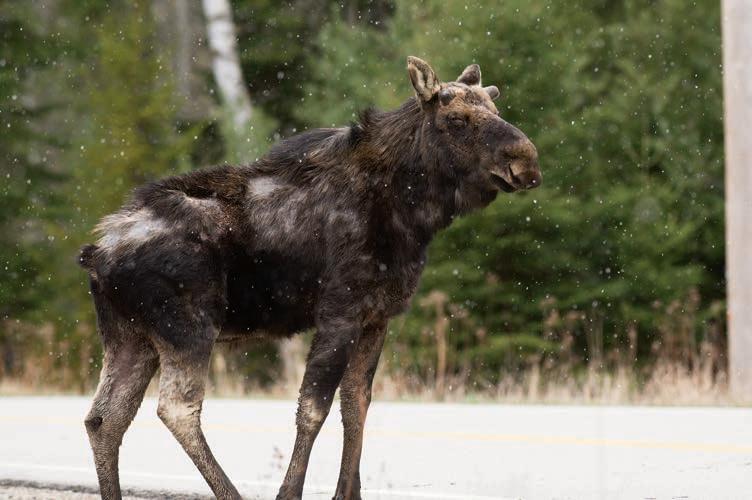
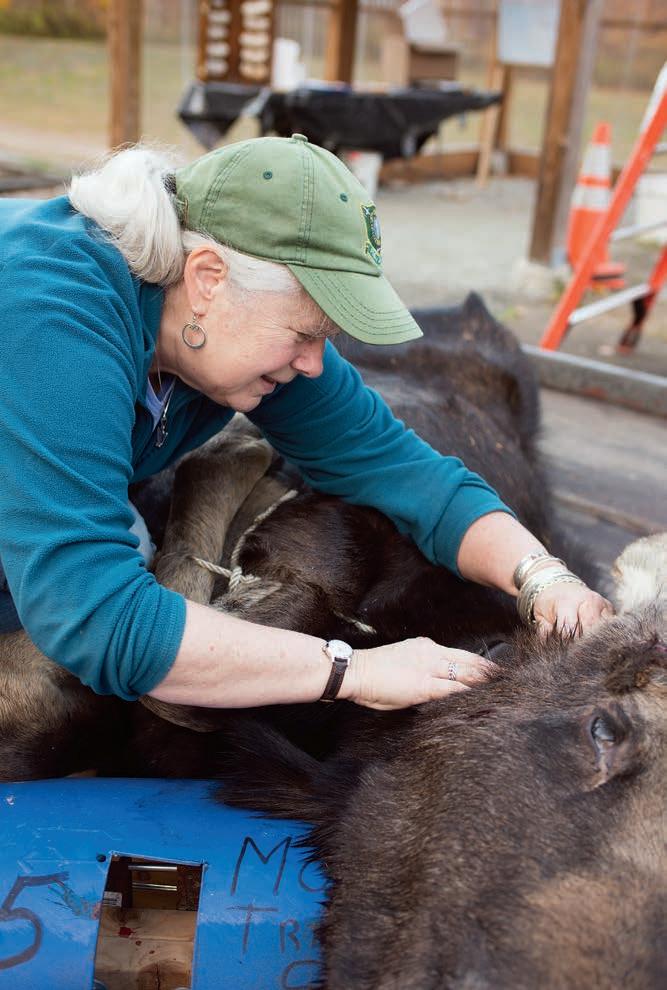
It was spring 1992, near the town of Lewis in Vermont’s Northeast Kingdom, when Cedric Alexander saw his first ghost moose. “I was in the woods doing a spruce grouse breeding survey,” says Alexander, a wildlife biologist for the Vermont Fish and Wildlife Department, “when I spotted a moose in the distance that somehow looked different.” Closer inspection revealed the moose had lost a lot of hair, making it appear oddly pale. Alexander reasoned that a heavy tick load was to blame but didn’t see it as immediately alarming. At the time, “bad tick years were infrequent, and the moose population was still increasing,” he explains.
Kristine Rines saw her first ghost moose that same year, during a moose conference in Ontario. It wasn’t until about five years later, though, that she spotted her first tick-infested moose in New Hampshire. “Then we started noticing slight declines in our moose population, and I assumed it was probably related to ticks,” she recalls. “After repeated attempts to get approval for a study, we were finally successful in 2001.”
The findings of that initial, fiveyear study were stark and conclusive: Winter ticks were the primary cause of moose mortality in northern New Hampshire, where moose density (and therefore tick density) is highest. Now Rines and her colleagues are working on an even bigger study, a four-year project overseen by veteran moose ecologist Pete Pekins, who chairs the natural resources department at the University of New Hampshire. With Maine and Vermont also participating in the research, it’s reportedly the largest study of New England moose ever conducted.
Yet even as biologists work to get a clearer picture of what’s happening in the moose population, weather trends keep turning up the heat. Of the 18 warmest years on record, 17 have occurred since 2000—with 2016 being the hottest since record-keeping on global temperatures began, in 1880. And milder winters are key in winter tick booms. After a last meal in early spring, the females drop to the ground, where they’ll lay their eggs; they’ll likely die if they encounter ice or snow, but “if they land on uncovered, snow-free leaf litter,” says Kantar, “it’s a field day.”

Also good for winter ticks: a warm autumn. That’s when the next generation has hatched and is most vulnerable to cold and snow. The milder the weather, the more larvae will survive to climb into the vegetation—usually to the average chest height of moose— and wait to latch onto a passing host, a behavior that biologists call “questing.” The larvae quest in groups, interlocking their legs; since a female winter tick can lay 3,000 eggs, this means hundreds of larvae may land on a moose at one time. Once settled, they’ll feed, rest until late winter or early spring, and feed again. The only time a moose can escape the onslaught is summer,
after the adult ticks drop off and before the larvae start latching on.
It’s little wonder, then, that many see the warming planet as the moose’s ultimate threat. “If climate change keeps ramping up,” says Ed Reed, a wildlife biologist for New York state, “we could lose moose completely in the Northeast.”

The vision of the four ghost moose is still with me the morning after my vigil, as I head to Milan Luncheonette & Variety in Milan, New Hampshire. I’m meeting Rines and Pekins for breakfast, along with three of Pekins’s assistants, graduate student Dan Ellingwood and field technicians Todd Soucy and Jake DeBow.
Waiting for hot egg sandwiches, we talk of moose and how to find them. Rines, a plainspoken woman with shoulder-length silver hair, has been the New Hampshire moose biologist for all but two of her 35 years with the Fish and Game Department. Although someday Rines will retire and “go watch birds for a while,” right now she’s fully committed to moose.
“This time of year can be very sad for moose,” Rines warns, as we discuss


plans for today’s expedition. “Biologists call it the ‘season of death’ because so many calves die now, mostly as a result of winter ticks.”
Tens of thousands of winter ticks— ranging from an average load of 35,000 to as many as 150,000—may feed on one moose simultaneously. Adult moose typically can survive the tick assault; calves, however, with their smaller bodies and lower blood volumes, often cannot. A tick-infested calf may lose its entire blood supply over a few short weeks.
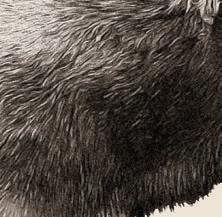
In parts of New Hampshire where biologists have tracked moose via GPS or radio collars as part of their current multistate study, the calf mortality numbers have been sobering. In 2014, more than 60 percent of the collared calves died; by 2016, it was up to 80 percent. “We’re losing an entire age class of moose,” Pekins laments. (Toward the end of the year, though, Pekins will send me a bit of good news: The mortality rate among New Hampshire’s moose calves last spring was only 30 percent, thanks in part to the tickkilling early autumn snowfall of 2016.) After breakfast, our group makes its way north on Route 16, heading to New Hampshire’s North Region
JUNE
After several weeks’ dormancy, the females lay their eggs, starting the cycle anew.
Female ticks, fully engorged with blood, drop off the moose; male ticks die soon after mating.
Winter tick larvae hatch from
The
Feeding begins again as the tick mating season gets under way.
After a few months’ dormancy on their host, the nymphs feed again and molt into adult ticks.
Moose Management Unit. The North Region and the adjacent Connecticut Lakes Region represent the state’s best moose habitat: a northern forest in early succession.
Our first stop is at Pontook Dam along the Androscoggin River. We scan the timberline: no moose. Not far down the road is a spot where two weeks ago researchers found a sick calf. “[It] took three or four steps, then died within a few minutes,” recalls DeBow. Since the area has plenty for moose to eat and the calf’s stomach was full, he says, the likely cause of death was blood loss from winter ticks.
Back in our vehicles, we veer left on Fire Tower Road, which leads to Milan Hill State Park, 10 miles north of Berlin. There, we climb slippery steel stairs that zigzag to a lookout cabin at the top of the park’s 45-foot-high fire tower. “Getting up there tests your lung capacity, that’s for sure,” Rines jokes. The height gives us views of both the White Mountains and the Green Mountains, and beyond to the Adirondacks of New York.
Pekins sweeps his arm over the seemingly endless forest below. “Clear-cuts have been rotated here, resulting in lots of regrowth,” he says. “It’s great habitat for moose. There may be fewer of them, but they’re out there somewhere.”
All of which leads to the question: Can we do anything to change the future for the northern New England moose?
“People have suggested everything imaginable for dealing with the hordes of winter ticks,” says Rines. “Ideas include putting out insecticidelaced salt licks, using robots that apply insecticide to the ground, spraying the woods with insecticide, placing tick collars on moose, and releasing guinea fowl to eat ticks.”
Unfortunately, none of these ideas are feasible. There’s no spray-based pesticide that targets only winter ticks, for example, and with repellents “you’d need a pressure washer to get the job done,” Rines says, since you’d have to get through the moose’s thick,
Moose are more than mere players in New England’s ecosystem; in terms of tourism, they’re a star attraction. Here’s some advice from regional experts on how to spot one of these iconic animals for yourself.
■ Moose-watching is best done by car —just don’t stop too close to them or get out of the vehicle. Remember: These are wild animals and always should be treated with respect and caution.
■ You’re most likely to see moose in mid-May through July, when they move into open wetlands to feed. Like most members of the deer family, moose are crepuscular, meaning they’re most active at dawn and twilight.
■ Keep your eyes peeled for bogs and wetlands, where moose tend to hang out. They’re also drawn to salt licks, which is why many prime moose-spotting routes have areas where road salt runoff has built up.
■ In New Hampshire, try looking for moose along Route 16 north of Milan; Route 26 east of Dixville Notch; Route 112 east from Lincoln to Bear Notch Road; and Route 110 north of Berlin to Route 110A.
■ In Vermont , you may have luck on Route 114 in Canaan and East Burke; Route 105 from Island Pond to Canaan; and the viewing platform at Route 105 and Notch Pond Road in North Brunswick.
■ The moose population in Maine is among the biggest in the U.S., which means this state has entire regions worth checking out: Western Lakes and Mountains, Kennebec Valley, Maine Highlands, and Aroostook County.
■ And of course you can always rely on professional tour guides, such as Gorham Moose Tours in Gorham, NH ( gorhammoosetours.org), and Northwoods Outfitters in Greenville, ME ( maineoutfitter.com).
Research by Heather Tourgee. Sources: Wendy Bolduc, Maine Inland Fisheries and Wildlife; Susan Warner, Vermont Fish and Wildlife; Katelyn White, NH Grand
shaggy hair to apply it to the skin.
As most biologists see it, there are just two strategies, both difficult. “We put the brakes on climate change,” Pekins says, “or we decrease the numbers of moose by letting winter ticks run their course or by increasing hunting to bring down moose densities.”
Studies have indeed shown that with fewer animals to feed on within a given area, “tick numbers begin to fall,” says Stephen DeStefano, moose biologist at the Massachusetts Cooperative Fish and Wildlife Research Unit. In Massachusetts, where moose number about 1,000, the population has been relatively stable over the past few years, he says. “There’s certainly no indication of a precipitous decline. Winter ticks are present, but they don’t seem to be having a big effect.”
Similarly, the 500 to 1,000 moose in New York’s Adirondack Mountains are “virtually tick-free,” says New York’s Ed Reed, who works for the Department of Environmental Conservation. “You can count the number of winter
ticks on an Adirondack moose on less than one hand, probably because there aren’t enough moose to get the tick cycle going.”
The trouble is, nobody really knows how far the moose populations in New Hampshire, Vermont, and Maine must drop before they reach the “sweet spot,” and the comeback can begin.
On my final day in moose country, it’s again a beautiful April twilight, the sun vanishing behind the trees, as I’m drawn back to the road where I saw the ghost moose. I am hoping for a glimpse of one last moose. But the hillside is empty.
I linger until the light is gone. The moose may have been just beyond my line of sight … maybe, I hope, wading in the pond east of these woods. In a few months it will be summer. Next season’s winter ticks are only eggs on the forest floor, still weeks away from hatching and beginning their quest to survive, their journey to find a host.
Our Land. Our Sea . Our Future.
WITH HIS STUNNING PORTRAITS OF NEW ENGLAND’S WILD PLACES,

JERRY MONKMAN CREATES BOTH ART AND A CALL TO ACTION.

Back in the fall of 1989, Jerry Monkman was a Midwest transplant living outside Boston with a freshly minted business degree and no desire to put it to use. Instead, the 24-year-old paid his rent by working retail at the Burlington Mall and used his off days to explore New Hampshire’s White Mountains and Maine’s Acadia National Park. With his future wife, Marcy, he’d camp and hike, capturing the landscape and the light with his Nikon SLR camera.



But it wasn’t until he attended a book signing by Galen Rowell, a renowned mountaineer and outdoor photographer, that Monkman saw the chance to merge his passions for nature and photography into a career. “Here I was [at the mall], selling guidebooks and plastic dinosaurs,” says Monkman. “Instead of just looking at nature photos in the food court, I could get paid to take them.
“Galen wrote a lot about the right light and participating in the landscape—he thought his best images came when he was on expedition, when he was really immersed in his surroundings,” Monkman continues. “Marcy and I took that to heart, and would go out for days on end. It’s how I became a better photographer and got my best work.”
It’s still that way. Over the past quarter-century, Monkman has produced some of the most enduring photos of New England: The ice-blasted peak of Mount Washington. The soft springtime beauty of Connecticut marshlands. A fog-wrapped Katahdin ridgeline. But to call him just a nature photographer misses the point. His is a kind of advocacy work, one that goes far beyond trying to create pretty calendar photos. Nearly all his clients—the Appalachian Mountain Club, the Nature Conservancy, the Conservation Fund, and the Trust for Public Land, to name a few—are organizations whose mission includes protecting New England’s lands and waters.
Many of these groups’ achievements have been made with help from Monkman, whose work showcases the sometimes subtle, sometimes overwhelming beauty of places that often need to be seen in order to become conservation success stories. These include a 100-acre wood with a trout stream in Greenwich, Connecticut; retired logging land around Maine’s Katahdin Lake; and prime coastal property along New Hampshire’s Great Bay, outside Portsmouth—“That’s thousands of protected acres around one of the most productive estuaries on the East Coast,” he says. “To see all that progress is pretty cool.”

So is what it means for the public. “I want to inspire people to get outdoors and care about the outdoors,” says Monkman, who has published 10 books, a mix of outdoor guides and coffee table publications, many with his wife, Marcy. His newest, AMC’s Outdoor Adventures: Acadia National Park, was a 2017 recipient of the National Outdoor Book Award. “The more that people are out there, the more they’ll care about the natural world. They’ll think about the importance of these places and what they mean for all of us.” —Ian
Aldrich
Monkman’s photography trips sometimes include his wife and their two children. Here, his teenage daughter, Acadia— named for Monkman’s favorite national park— navigates the Knife Edge Trail on Mount Katahdin.
PREVIOUS SPREAD : This graceful stand of paper birches in the Sieur de Monts Spring area of Acadia National Park “shows a very different side of Acadia,” Monkman says. “It’s not all about granite and rock—the forests are also pretty.”

TOP : Monkman’s powerful images of New England’s natural beauty—including this mist-shrouded scene in Stewartstown, New Hampshire—have been instrumental in conservation groups’ efforts to fight the proposed 192-mile power transmission line known as Northern Pass. ABOVE : “I rarely get inspired by the usual photo-op spots,” says Monkman, who captured this picture of the Westfield River in Chesterfield, Massachusetts. “I followed the river for an hour before I found this scene of rushing water and the mood I was looking for.”
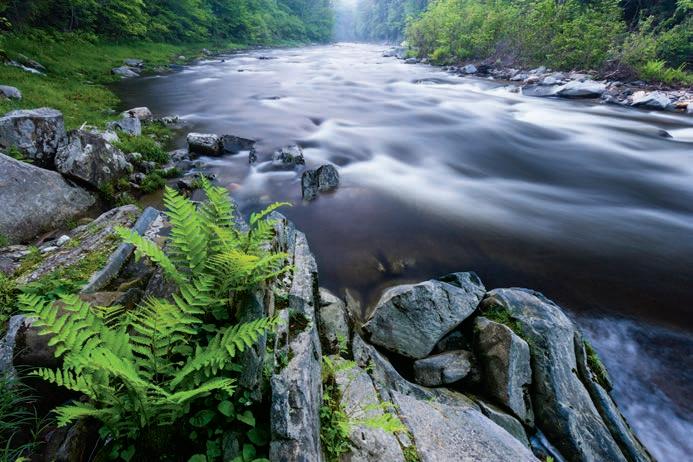

As conservation efforts around New Hampshire’s Great Bay began to heat up in the mid-1990s, Monkman was hired to photograph its lands and waters. Today the Lubberland Creek Preserve ( PICTURED ) and thousands of acres like it have been set aside for all to enjoy.

A popular spot for hikers, anglers, and rock climbers, Stonehouse Pond and its surrounding 241 acres in Barrington, New Hampshire, came under the ownership of the Southeast Land Trust of New Hampshire about a decade ago.
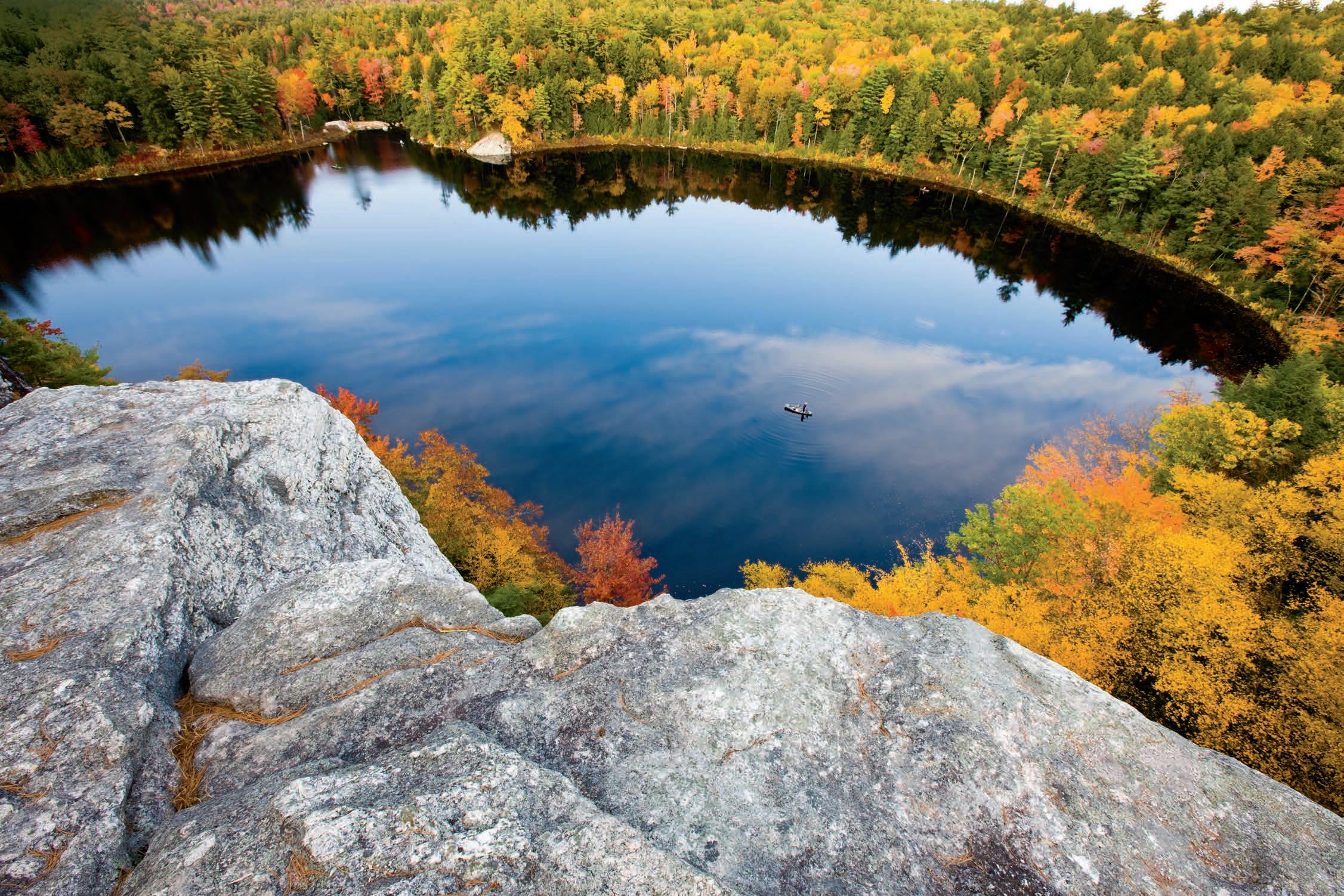


OPPOSITE : This grove of Eastern hemlock in Madbury, New Hampshire, was once part of the farm of Revolutionary War hero John Demeritt, a 193-acre parcel that was acquired by the Society for the Protection of New Hampshire
To see more of Jerry Monkman’s work, go to newengland.com/monkman or ecophotography.com.


THE MOST DOMINANT COLLEGE ATHLETIC PROGRAM IN THE COUNTRY HAS GALVANIZED THE STATE OF CONNECTICUT FOR TWO DECADES.


UConn’s Gabby Williams, far left, fights for a loose ball during the women’s regional playoffs in March 2017; poised to jump in is All-American forward Napheesa Collier (#24). The Huskies went on to beat UCLA 86–71, winning their 110th game in a row.

 by MIKE STANTON
by MIKE STANTON
PHOTOGRAPHS BY STEVEN G. SMITH
“I know,” responds University of Connecticut AllAmerican Katie Lou Samuelson.
“It started with a lousy pass,” adds coach Geno Auriemma, who uses a saltier word for lousy. “C’mon, guys. You can move. You can’t be standing around waiting for passes.”
The Huskies run the play again. This time, they whip the ball around the perimeter until a seam opens in the defense. Then Napheesa Collier drives to the basket and puts up a shot that caroms off the rim, and 6-foot-6 Azura Stevens swoops in to grab the rebound and score.
“Good, good, good,” says Auriemma.
Practice is brisk and businesslike this October afternoon. Where others see a nice play, like Crystal Dangerfield’s intercepting a pass and tipping it out of bounds, Auriemma sees a flaw in the diamond he is polishing.
“That’s the worst play in the world,” he tells them. “She tips the ball out of bounds, and you’re clapping instead of trying to save it.”
The thing about playing for UConn is that you’re always playing for—and against—the legacy of players who came before you. So when Kyla Irwin fails to rotate quickly enough to defend a shot, Auriemma invokes the memory of Breanna Stewart, who won four national titles and was the WNBA’s No. 1 draft pick in 2016.

“Stewie could be late—she’d block the guy’s shot,” says Auriemma. “You can’t be late. You gotta be early.”
Auriemma points to his veterans, then delivers a message to his younger players. “You don’t know half the stuff they know,” he says, substituting another word for stuff. “Work hard. This is your chance. Know where people are. Practice paying attention.”
So it goes in the UConn incubator, which in Auriemma’s first 32 seasons produced 11 national titles, six undefeated seasons, and 18 Final Fours, including the past 10 in a row. As he prepared for this, his 33rd season, he was closing in on 1,000 wins. If legendary UCLA men’s
coach John Wooden was the Wizard of Westwood, Auriemma, who in 2016 surpassed Wooden’s 10 national titles, is the Sultan of Storrs.
Freshman Megan Walker was the nation’s high school player of the year, but in Storrs all she has to do is look up at the banners of AllAmericans on the walls to know her place.
“When you walk in and see all those banners, you know you’re really here,” she says. “We’re not playing for ourselves—we’re playing for the seniors. The intensity level can be rough to get used to. But Coach says big-time players perform on the big stage.”
Taking in practice this day is veteran WNBA coach Dan Hughes, who has just been hired to coach a Seattle Storm team that includes three former Auriemma players: Stewart, Sue Bird, and Kaleena Mosqueda-Lewis.
People who see Auriemma only as an acerbic coach who pushes his players’ buttons overlook the fact that he is “a master teacher,” says Hughes.
“When you build a team, you try to get players to give energy rather than take it,” says Hughes. “UConn players give you energy. I wish I had 10 of them.”
Hughes points to the Huskies’ silent attentiveness as Auriemma speaks.
“He’s like a musician. He uses the pauses and silence in the music.”

The little white bus trundles through a gray November afternoon, the thinning light a harbinger of the winter that will soon wrap itself around the hills of eastern Connecticut. Nineteen residents of the Covenant Village retirement community in Cromwell peer out the bus windows at the timeless landscape: a sagging farmhouse, stone walls tinged with lichen, a red barn, horses in stubbled fields.
Sitting up front is Covenant Village resident Jack Reisch, who directs the driver to turn onto Discovery Drive. A small city emerges from the countryside—a bustling campus with more than 19,000 undergraduates on land that Charles and Augustus Storrs donated in 1880 for the purpose of educating boys in farming. Rising like a bulbous white mushroom is the bus’s destination: Gampel Pavilion, home to one of the unlikeliest dynasties in all of sports.
One of the many fan clubs that have sprung up across Connecticut to celebrate the UConn women’s basketball team, the retirement home group calls itself “Chris’s Kids.” When the group formed in 1995, the year the Huskies won their first national championship, the residents had a naming contest and chose “Geno’s Bambinos.” But they became Chris’s Kids after a club leader traded emails with associate head coach Chris Dailey, who later came for a visit.

Reisch has organized this trip for Chris’s Kids to see the women in their final tune-up for another season of high expectations, an exhibition game against defending Division II national champion Ashland University.
For most of the women’s games, the club members park themselves in front of the big-screen television in Covenant Village’s events room, decked out in Husky blue and white.
From cradle to grave, Connecticut is mad about its Huskies. Girls grow up in Connecticut with the same basketball fever as boys in Indiana. They dream of being Diana Taurasi or Maya Moore or Breanna Stewart or Katie Lou Samuelson, whose hair bun and three-point shot little girls try to emulate. Before the rise of regional sports television networks and UConn’s subsequent move to the SNY network, which reaches 14 million viewers in the Northeast, the UConn women were the top-rated show on Connecticut Public Television.
Obituaries in Connecticut newspapers are filled with references to the dearly departed’s devotion to Huskies hoops. “My late mother, a devout Catholic and by no means a sports fan, relished the experiences of the women’s team,” one man wrote the Hartford Courant last winter, as the team was in the midst of a mind-boggling 111-game winning streak. “In her later years ... her comfort came from the religious network, but her joy was manifest in the accomplishments of these gifted women....”

When the Huskies were upset last year by Mississippi State on the verge of their fifth straight championship, their fans were shocked.
“I remember the tears,” says Chris’s Kids member Ron Gocht. But Betty Metcalf, an 88-year-old Covenant Village resident who works part-time as a grief counselor, said her disappointment mingled with relief. “I knew they had to lose sometime, and it was worrying,” she confesses.
Barricades block the street outside Gampel. Reisch negotiates with a police officer to let the bus unload near the entrance.
“We’ve got a 103-year-old lady on board!” he shouts.
That does the trick. Chris’s Kids clamber off the bus. Esther MacSwan, who is indeed 103, glides into the arena with the aid of a red walker; flanking her is Louise
Butts, who is 88 and, in the wake of a recent hip surgery, also uses a walker. The two settle in at center court in one of Gampel’s handicapped-seating areas, which sell out quickly for women’s games.
MacSwan takes in the scene: the blaring music, the parents with little girls in UConn jerseys, the cheers as the players are introduced. Hanging from the ceiling are the women’s national championship banners: 1995, 2000, 2002, 2003, 2004, 2009, 2010, 2013, 2014, 2015, 2016.
MacSwan has followed the Huskies for 27 years, since moving to Covenant Village in 1990, but this is her first visit to Gampel. When she was born, in 1914, women were not yet allowed to vote, let alone fast-break. When Stanford University played the University of California at Berkeley in the first women’s intercollegiate game, in 1896, women guarded the doors to bar male spectators.

But even that was considered too risqué, and three years later both schools banned women’s basketball from intercollegiate competition.
For older women, the success of the UConn women’s team has been liberating.
For girls, empowering.
For the state of Connecticut, sandwiched between Boston and New York without a major professional sports franchise of its own, a source of pride.
And for basketball fans young and old, male as well as female, just plain exhilarating—not only because the women win but also because of how they play.
“I was never much for girls’ sports, but then I went to a game and had so much fun,” says Chris’s Kids member John Sandberg. Watching them play—the passing, the unselfishness—“it’s like an art exhibit. Such beautiful movement.”
Success was not a foregone conclusion when a young, brash Geno Auriemma arrived in Storrs in 1985. After four years as an assistant coach at the University of Virginia, Auriemma found himself driving past barns and rolling fields. (One city recruit saw the pastoral landscape and said she couldn’t play at a place that had cows.)
The team played in a barnlike field house with a leaky roof. When it rained during practice, the coaches put buckets out to catch the water and the players dribbled around them. Auriemma shouted instructions over the music blasted by the weight lifters in one corner of the gym. Practices were punctuated by the crashing of
hurdles being knocked over by members of the track team running around an oval that ringed the court; one day, an exasperated Chris Dailey asked them if the object wasn’t to jump over the hurdles.
The team was lucky if the games attracted 50 people—mostly relatives, friends, and boyfriends. Program assistant Peggy Myers, who was the center and captain of Auriemma’s first team, laughs when she describes fans telling her they were there “from the beginning.”
Myers (née Walsh, before marrying a former UConn football player) was a senior on a team that had gone 9–18, 9–20, and 9–18 in her first three years. She was surprised when Auriemma called to introduce himself, because the search committee had said it wanted to hire a woman for head coach. When she met him, her first impression was: “He’s a little guy.” But she adds, “He was the same cocky, arrogant, great, funloving guy he is today.”
Myers had the top bunk in her room, but after the first two weeks of practice she was so exhausted that she pulled the mattress onto the floor to sleep. Shortly before the season opener, Auriemma told her that he was thinking of starting another player who practiced harder. “I was in tears,” recalls Myers, who intensified her efforts and wound up starting every game that season. “He elevated my game.”
That team finished 12–15, Auriemma’s only losing season. But it flashed a new competitive fire, and Auriemma and Dailey began recruiting more talented players. Then, in January 1990, UConn opened the shiny Gampel Pavilion. Intended primarily as a showcase for the popular men’s basketball team, which Jim Calhoun was building into a powerhouse that itself would win four national championships, Gampel also became the women’s new home.

Myers recalls Auriemma standing with her husband, Norm, in the empty 10,167-seat arena and predicting, “I’m gonna fill this up.” Norm replied, “Are you nuts?”
Looking back on that same moment, Auriemma chuckles. “What was it Oscar Wilde said? ‘I’m not young enough to know everything about everything’?
So back in that age, I used to just make stuff up. And there was this part of me that thought, yeah, we’re gonna be really, really good and lots of people are gonna come watch us play. Wishful thinking?”
Yet the fans did start coming. At first it was because they couldn’t get tickets to the men’s games but still wanted to see the new arena. “I remember Laura Lishness stretching before one game and the place was packed, and she said, ‘What are they doing?’” says Dailey. “I said, ‘They’re here for your game.’ I didn’t tell her they were just coming to look at the building, and that our games were free. But we had a good team and good personalities, and after the games the players would meet with the fans. It became a good connection. That started the phenomenon of what became UConn women’s basketball.”
The next year, 1991, the team went to its first Final Four. That group, including Lishness and Kerry Bascom, was an early link in what has become a succession of talented players building on their forebears’ victories.
That initial success led Auriemma to his first big star, Rebecca Lobo, who helped lift the UConn women to their first national championship, in 1995. Lobo received so much fan mail that Auriemma hired Myers, who had just given birth to her first child, to help answer it. Today Myers answers the phone, greets visitors, offers advice to players, and happily talks to recruits and their parents about what it’s like to be a part of the basketball family.
The UConn women won their second national title in 2000, then embarked on a remarkable run of three straight titles from 2002 to 2004. Auriemma calls the 39–0 team in 2002 his greatest, featuring Sue Bird, Swin Cash, Tamika Williams, Asjha Jones, and a precocious sophomore who would become UConn’s biggest star, Diana Taurasi. In Taurasi’s senior year, they ran their winning streak to 70 straight. At the time, Auriemma said the team would have loved to have broken UCLA’s record 88-game winning streak under John Wooden— but he doubted that would ever happen, given the growing parity in women’s college basketball.

He was proved wrong in 2010, when UConn broke UCLA’s mark with a 90-game winning streak, then topped that by ripping off 111 straight wins from 2014 to 2017. The two streaks marked an unparalleled stretch of dominance that saw six more national titles, including four straight from 2013 to 2016. Last season, in what was supposed to be a “down” year after the loss of the top three players chosen in the WNBA draft—Breanna
Stewart, Morgan Tuck, and Moriah Jefferson—his players still charged into the Final Four unbeaten before the loss to Mississippi State.
So how have the Huskies maintained such dominance? “We’ve still been able to do what we do because that’s what we do,” Auriemma says. “That’s the best way I can explain it: That’s what we do.”
Chris Dailey sits in her office on a quiet preseason morning last October, talking about the challenge of managing success. Long overshadowed by the outspoken Auriemma, Dailey—or “CD,” as she is known—has won her due as an essential part of the program’s success. She is yin to Auriemma’s yang, Bacall to his Bogie. A creature of habit, Dailey stops at the same Panera Bread in
Manchester every morning to pick up a tall iced tea. When she went in about six weeks after the Mississippi State loss, the manager looked at her, tilted his head, and said, “Nice year.”
“I went up to him,” Dailey recalls, “and said, ‘We need to talk about that. 36–1 is an awesome year. It’s way better than nice, so let’s come up with some other adjectives. Let me hear it.’ So he’s like, ‘Awesome!’ and ‘Great!’
“Let’s enjoy the fun they’re having, the way they play, the fact that they’re graduating and coming together as a team,” Dailey continues. “It’s not just about whether we win the national championship.
“Clearly we’ve created this … but I want them to be in reality. What we’ve done is not reality.”
Dailey hears from women who played for UConn when the university had only a club team and who take special pride in the program’s success. “They celebrate the opportunities that women get today. That’s a gift for them,” Dailey says. “We talk about it with our players now. They wouldn’t have had the opportunities they have if Laura Lishness, Kerry Bascom, Meghan Pattyson, and others didn’t set the table for them. We try to teach our players the history of women’s basketball, so that they can appreciate and understand that they have a responsibility for future players.”
Maintaining success requires constant adaptation. The women practice against men, follow diverse workouts to maximize endurance, and drink shakes with slow-releasing carbohydrates to boost energy before a game. To help forge strong team bonds, players sign off of social media for the season when practice begins; this season, Dailey is having them deposit their cellphones in a box before practice, which they won’t get back
until after their post-practice dinner. “We’re going oldschool,” she says.
Down the hall, Auriemma leans back in his chair and echoes Dailey. Notorious for his demanding nature, he laughs when he relates how his former players accuse him of spoiling today’s players.

“My expectations have not changed, but I think the way I go about it has changed,” he says. Fifteen years ago, he could demand that his players practice a defensive drill over and over until he got tired of watching. “Today, in the world they live in, I don’t know that I could do that and keep their attention.” He picks up his cellphone. “The circle of who they interact with is bigger. For instance, I can’t get my guys to hate the other team, because they’re all friends…. It’s a different world. I see it in their faces whenever I get really mad at them and explode—they get scared. They feel like there’s a part of me that thinks that I don’t like them … they have a difficult time discerning the difference between I don’t approve of what you just did and I don’t approve of you.”
A scrappy player at West Chester State in Pennsylvania, Auriemma emulated the us-against-them mentality of Philadelphia basketball. As an assistant at Virginia, he came to admire the talent and unselfishness of Dean Smith’s blue-blooded University of North Carolina men’s teams. When the Tar Heels played at Virginia, Auriemma would go into a soccer coach’s office next to the visiting locker room and eavesdrop on Smith’s halftime talks. His dream, which he believes he has achieved at UConn, was to be a Philly coach with Carolina players.
When Auriemma broke Wooden’s UCLA records, he received criticism from people who said that it wasn’t (continued on p. 136)
(continued from p. 90)
On a crisp, postcard-perfect day, the small museum village is as trim and tidy as a scale model. The houses, uncrowded by cars and utility wires, seem like ideal images of themselves. Standing on Puddle Lane as Rowland points out the other houses, I realize we are at the bottom of a bowl. In a storm, all the water “comes right here, because we’re the low point,” he says. “I’ve seen storms where some of our historic boats are floating along Puddle Dock. You would have thought we’d been in some time warp. We’ve got these Strawbery Banke dories floating across Puddle Dock. That water has nowhere to go. The ground is saturated. The storm drains are saturated. It just sits. That’s the big problem. We’re at ground zero.”
After examining the Shapley-Drisco House’s basement, we walk down the lane to the Lowd House, where the basement has been repaired and defended against the sea. “The damage to the original chimney base, built in 1810, was so extensive from saltwater infiltration that you could crumble it with your hands. There was no saving it,” Rowland says. No historic museum wants to lose the original object, but they had no choice, and replaced it with granite. They also lost the 1810 summer kitchen that was in the basement— that part of the house’s story is gone. They built a perimeter drain in the basement and added soil, rock, a moisture membrane, a concrete cap, and a basin with a sump pump. I can imagine the museum labeling this as an exhibit one day: “Climate Change: Early 21stCentury Response.”
The Puddle Dock houses are an indicator of what’s to come. What will happen to the rest of the museum depends on the forecasts, and whether we find a way to stop dumping carbon into the atmosphere. If there’s a twofoot rise in the mean sea level, Strawbery Banke may survive, but it could face damaging storm surges, which push more water toward Puddle Dock. If, as other forecasts predict, there’s a three-to-six-foot rise by century’s
end, Strawbery Banke could become a wooden Venice. Beyond 2100, the sea will probably rise even faster.
“We’re never going to be able to combat the sea rising and the river infiltrating this neighborhood,” says Rowland. “My opinion? We’re not going to move, but we are going to lose historic resources.”
Strawbery Banke’s founding, though, may hold a clue to its future. In 1958 local citizens saved the buildings from being flattened by urban renewal. It was a bold idea, one without a road map, and it has taken years for the museum to evolve. They are just now restoring their last three buildings. Strawbery Banke will have to be rescued again, but no one knows how yet.
Change has always been a part of the story the museum tells. It was never meant to be a time capsule. “It’s one of the reasons Strawbery Banke is unique,” says Rowland. “Most museums pick a fixed period or a decade; we do 300 years because we want to show people how this neighborhood evolved over time. There’s no question in my mind that our response to sea-level rise will be part of that story.”
When Evan Griswold was 7 years old, in 1954, his mother led him out into the eye of Hurricane Carol. The sky was bright blue; the surf raged. They ran all the way down to the beach. He saw the front of a house vanish into the waves. He’s never forgotten it, a lesson that’s still with him more than 60 years later.
On a sunny day I walk out to Griswold Point with Griswold and Adam Whelchel, director of science for the Nature Conservancy in Connecticut. Griswold Point, at the mouth of the Connecticut River, is one of those places where you feel yourself pinned to a map, where you can imagine yourself as seen from above. We look south to a marsh, a barrier beach, and the Long Island Sound, and west across the Black Hall River to more marsh and the white stone lighthouse commissioned by George Washington
that marks the entrance of the broad Connecticut River. Piping plovers nest on the barrier beach. The yip yip yip of ospreys fills the air; a light breeze keeps the mosquitoes moving. Griswold’s old Lab, Maya, follows us, looking like a small black bear in the tall grass, until she’s distracted by the lone elm in the hayfield. Ospreys land there and drop bits of fish, an irresistible treat for her.
Evan Griswold’s family has lived here since 1645, back to the day Matthew Griswold was granted 10,000 acres, land that stretched from Old Lyme to New London. Growing up, Evan Griswold spent his summers here, and in 1983 he and his wife, Emily, had a post-and-beam house built under the trees. He sited it back from the marsh—quite far back, he thought. When Superstorm Sandy hit, the tide kept coming in for three days. The Long Island Sound rose until it was about 50 feet from his house, just down a small slope. Griswold is a proper host as he shows us around, but also a bit of the real estate agent that he is, efficiently walking a prospective buyer through a house.
The changes that he’s seen in the marsh during his twice-daily walks over the past three decades are quietly persistent. He shows us where the stone wall his ancestors built falls right into the low-tide mud flats of the cove. This was once pasture. He shows us where the bright green of salt meadow hay (Spartina patens ) has retreated and almost disappeared as the rougher, duskier salt marsh cordgrass (Spartina alterniflora ) advances. The salt marsh cordgrass marks the advance of the tides. It can live where it is submerged daily.
And the changes are also large. We tour a neighborhood that flooded in Sandy and was without municipal water for six months. A rebuilt house stands awkwardly on stilts 13 feet high. There are signs up around Old Lyme announcing meetings to talk about “resiliency,” about preparing for a new, post-Sandy world. The three lectures were poorly attended, lost in the festivity of early summer—tennis, tag sales, and all the rest—but the future is hur-
rying in anyway. Main Street is a mere 20 feet above sea level. Most of the town’s residents depend on wells and septic systems. The rising sea is starting to salt the wells and carry nitrogen from the septic systems into the sound. This will be very expensive to fix.
The post-Sandy reality was vividly presented to Old Lyme in the new flood maps drawn by FEMA. People are angry at FEMA: “I’m in a flood zone? Do you know what this will do to my property value?” But Griswold is uniquely positioned to see both sides. Before he began selling real estate, he trained as a forester, and he has served as the executive director of the Nature Conservancy’s Connecticut chapter.
“It’s a creeping crisis,” he says. But it’s as if climate change is happening in an invisible spectrum, a bandwidth of light that we won’t see until it’s too late. The world changes inch by inch, and when a big storm blows the sea inland we are finally forced to see that we are living in a new world.
It’s hard to imagine, says Whelchel. Climate change can seem to be a gentle thing on such a fine day. The ospreys are thriving, the Long Island Sound sparkles, the long tenure of the Griswold family here suggests a comforting continuity. “So how do you convince people on a beautiful day like today that there was ever anything like a nor’easter or hurricane?” he asks. As for sea-level rise—“What’s that?” And while the flooding from a hurricane is temporary, “sea-level rise is permanent. It’s permanent inundation. There is no going back from a sea-level-rise increase.”


Whelchel is cofounder of a pioneering program to get people to see the coming changes. He works with all 24 of Connecticut’s coastal communities, home to about a third of the state’s population, running workshops to help towns plan for the rising sea. Since starting the Coastal Resilience Program in 2007—reportedly the first of its kind in the nation—he has brought it to 14 states and eight countries.
One of his tools is a bit of shock therapy: aerial photo maps showing in red the houses, schools, and roads that will be in daily conflict with the tides. “Where’s the road going to be? Where’s the neighborhood going to be? Where’s the boat dock going to be? Where’s the beach going to be?” Whelchel makes it local, even personal. That’s your living room going out to sea.
The photos are marked to show where the marshes are going to move. Saving marshes is essential to protecting the coast. Healthy marshes absorb storm surges, purify the water, and serve as a nursery for the fish we eat. Marshes naturally respond to the changes in the ocean. As it gets too salty, they move back. Essentially, over time, they walk away.
“Marsh advancement” (the marsh walking) is the central metaphor we lack: We have to move. The sea is going to move; animals and plants are going to move. We have to move
our thinking and our planning and our politics. The usual story is about anguished efforts to hold the sea back from shoreline cottages with seawalls, sandbags, dune restoration, and millions of dollars of sand. But we need a new approach: We have to flex, to bend. To call it “retreat” disguises the new thinking required. We have to imagine a changing world. We have to admit that every action we take has consequences, even if it cannot be neatly tallied. We have to live with uncertainty.
We need to be “prudent,” advises Whelchel. “That is such a hallmark of being a Yankee, right? Thinking forward and being prudent. That’s what it’s all about. And by not considering sea-level rise, it’s just not prudent. Why wouldn’t you, if it’s going to affect you? Why wouldn’t you turn that to your advantage somehow?”
He’s guardedly optimistic. Before Sandy hit, attendance at his workshops was sparse and usually included a few climate-change deniers looking for an argument. These days, he says, “people are asking the right ques -
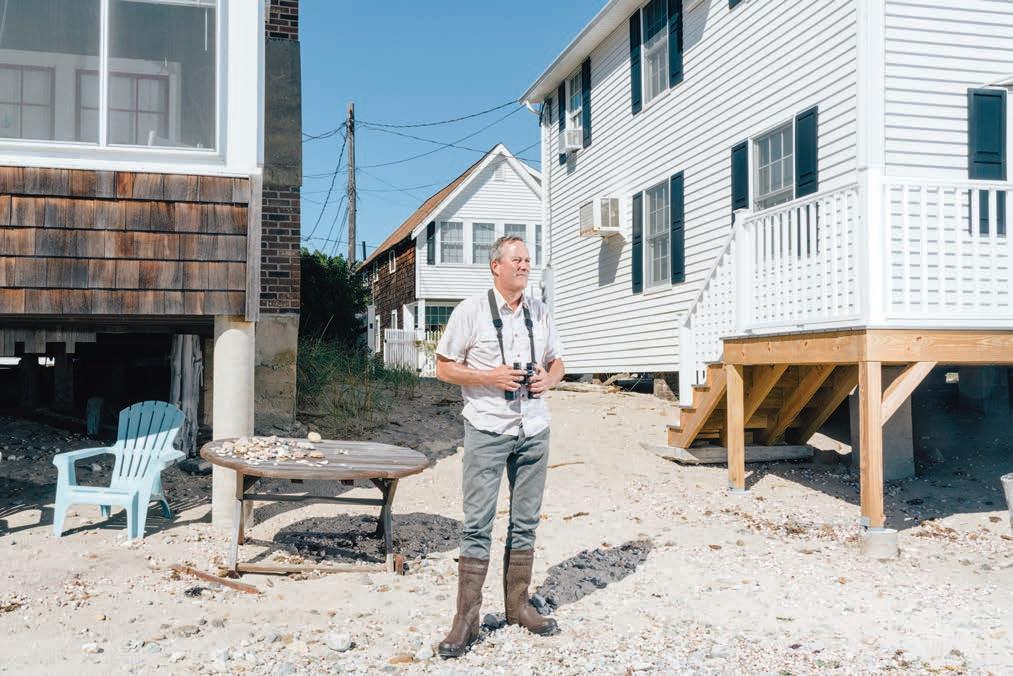
tions, and maybe even making some smarter decisions because of that. But the transformation to a sea-level-riseready community, or a resilient community, whatever you want to call it, is a little beyond us at this point.” He goes on to note that Old Lyme was one of the first places to be settled in New England. The land is marked by nearly 400 years of decisions “about what goes where and why. People are not going to change immediately.”
We haven’t really begun to reckon with this, Whelchel says. “We spent close to $14 billion post-Katrina on New Orleans. A key question for me would be: Can we sustain that level of investment when we add on a Houston, a Miami, a Los Angeles, a San Francisco, a Boston, a New York, a Seattle? And that’s not even the Mississippi River communities. How are
we going to choose which cities and towns to protect? What would it cost to secure Boston, Portsmouth, Hull, Chatham, Falmouth, Providence, Gloucester, Portland?” It’s a prescient roll call: Since we spoke, hurricanes have flooded Houston and paralyzed Puerto Rico.
Whelchel continues the story beyond the next decades. “At some point in the future we’re going to stop thinking about Connecticut’s coast,” he says, “and we’ll start thinking about the Archipelago of Connecticut,” a chain of islands where today there are roads and towns. Call them after the places we know: Fairfield Island, Westport Island, Branford Island. And somewhere under there will be Griswold Point, a New England Doggerland.
I think about that day 7,600 years ago when the inhabitants of the sinking Doggerland Island finally left. Were there those who refused to go, who tried to turn back the rising waters with their disbelief? Did they stay behind, blinded by their own denial? If so, then the Doggerlanders were a lot like us.
A Stannah Stairlift gives you the freedom to enjoy the full use of your home, living independently in comfort and safety.

Stairlifts, aren’t they all the same? Getting people up and down the stairs? At Stannah, we don’t agree. For example, we’ve designed chairs that fold up neatly at the push of a button, and recharge themselves constantly for reliable service. For stairs that turn, we developed a photo-survey system that measures with uncanny accuracy, so we can custom-make your stairlift to hug the stairs. Our outdoor model has proven itself in the toughest climates, and we have a range of options that’s second-to-none.
We understand that people like choices, so we offer stairlifts that are new, reconditioned or for short-term rental. We have models for both curved or straight staircases, all with a seven-day money-back guarantee.








We’ve made over 600,000 stairlifts (more than any other manufacturer) and have the experience to help you make a wise decision, so take the next step - call us today!

Visit one of our showrooms to take your first ride!
Massachusetts: 20A Liberty Way, Franklin MA 02038
New York:
45 Knollwood Rd, Ste 103, Elmsford NY 10523
(continued from p. 101)
that night. “All 500 were arrested, taken to the DPW garage, held till 4 a.m., and had to pay a $5 fine,” McKibben recalls. “They were home by breakfast—but it made a big impression on me.”
He turns the corner and points to the offices of the Lexington Minuteman , where he began his career as a writer. In junior high school, he worked as a stringer reporting school sports. “At 25 cents an inch,” he recalls, not too ruefully, “I could make the description of a basketball game go on a long time.”
But Vermont irresistibly beckons, and as he turns the car back onto the highway north, the conversation shifts away from the Boston suburbs and toward the value of smalltown life. McKibben lived in New York City for five years after college, writing “Talk of the Town” pieces for The New Yorker. But in 1987, he and Halpern, then newlyweds, bid good-bye to the city for the wildness of the Lake Champlain region. Their first stop, in the New York Adirondacks, “was a very rural, sort-of-forgotten town,” Halpern interjects from the back seat. “Not the sort of place people summer in. Bill got involved with the Methodist church. It was falling on hard times, and he agreed to teach Sunday school. He even got me involved—which is hysterical, because I’m Jewish.” Halpern also worked on building a local library from scratch (an experience that she relocated to Riverton, New Hampshire, for her own new novel, Summer Hours at the Robbers Library). Going all-in, she says, “was our gateway into the community.”
It was the same, adds McKibben, when they moved 50 miles across the lake, to Vermont, in search of a better school for their daughter. “There’s this whole mythology that you can’t be a
Vermonter for seven generations, and we found that was not true,” he says. “If you are willing to work on things other people are not wanting to do, and if you’re careful not to boss people around, or tell them how to do things, they accept you.
“Neighbors have been optional in much of America for the past 50 or 60 years, but they’re not optional in rural places,” he continues. “My belief is that they are not going to be optional for anybody before long. They’re not optional in Florida this week. Or in Houston.” Hurricanes Irma and Harvey had just devastated those two areas; Maria was still two days away from demolishing Puerto Rico. “The old American idea that you can get by
West. The triumph of Donald Trump and an administration that largely refutes climate change science pushed him to publish now, McKibben writes, with the moral that “when confronted by small men doing big and stupid things, we need to resist with all the creativity and wit we can muster.”
But Radio Free Vermont is also plainly a love letter to the state that sustains McKibben as he struggles with what he flatly terms “the end of the world.” The enormity of that “floored me for a while,” he says of his early years working on climate change. “I was depressed for quite a while. And now I have, to some degree, come to terms with that. The angst is familiar by now.” Humor and entertainment still help take off the edge. “And to be out in the woods whenever I am home is, for me, essential.”
on your own is beginning to alter.”
As we head out past the Boston exurbs of southern New Hampshire, McKibben’s undercurrent of restless anticipation seems to strengthen, as if he is beaming down some special North Star energy. “It gets comfortable around Concord,” he promises. “Everything thins out.” And then, leaving Concord behind, he adds, “Just about here we are starting to feel we’re escaping the gravitational pull of the megalopolitan region.” A little later, he and Halpern make their ritual pause at the Methodist Hill rest stop in Enfield, New Hampshire, just before the bridge into Vermont, as if they are about to enter the Promised Land.
McKibben says he noodled around for years with his new novel, partly a New England homage to Edward Abbey’s The Monkey Wrench Gang , a celebrated 1970s account of environmental renegades taking on bulldozers and dam builders in the American
So the new book features a band of aging cross-country skiers and a 72-yearold radio announcer with a fondness for reporting high school sports. There’s a woman who runs the School for New Vermonters (teaching retired but self-important doctors and lawyers how to fell a tree, drive through mud, and volunteer with the local fire department). There’s lots of knowledgeable talk about Vermont microbrews (“Did you know we had more breweries per capita than any place on Earth?” a character asks), plus a truckjacking ambush that involves dumping 4,800 bottles of Coors Light (and recycling the empties). There’s also a socially awkward young technology whiz with an encyclopedic knowledge of pop music: At one point, to inspire followers, he proposes playing any of three versions of “Get Up, Stand Up (for Your Rights)”— by Bob Marley, or Peter Tosh, or Toots and the Maytals, “but really not the Tracy Chapman version, I don’t think.” It’s an unexpected bit of dialogue to have been penned by the leader of the climate movement.
“Most politicians don’t yet understand that we have to move very, very quickly.... My mantra on this has become ‘winning slowly on climate change is just another way of losing.’”
McKibben’s rebels travel under a slogan from Ethan Allen, the original Green Mountain Boy: “The gods of the valley are not the gods of the hills.” And it becomes clear that the gods of the hills are McKibben’s gods, too. “When November came and the days grew short, his mood always began to soar,” he writes, attributing the thought to the radio announcer leading the Vermont secession movement. But what comes hammering through is McKibben’s own passion for winter and for cross-country skiing. “Cold meant snow and ice, and snow and ice meant: sliding. Meant the annual exemption from friction, meant that a solid Vermont farmboy became fast and agile. Graceful almost.... It was the sheer painful pleasure of charging fast uphill on a pair of skis, legs pistoning, lungs sucking in air, skis slamming against a hard track.… It never stopped seeming unlikely and magical to him, the way friction just quit, and gravity turned from adversary to ally.”
McKibben’s passion for crosscountry skiing is hardly a secret. When he was 37 and in need of “a break from failing to save the world,” he wrote a book, Long Distance , about undertaking a brutal training regimen meant to turn him into a world-class athlete in a year. When the year ended, he kept at it, and what’s surprising is the degree to which it still defines his life. He says he tries to confine his climate change appearances now to spring and fall, and to stay home in the colder months, when, friends say, he can get in more than 100 days a year of skiing. “His love of skiing is pretty legendary,” Andrew Gardner, a Middlebury publicist and professional cross-country skier, later notes. “He’ll call and say, ‘Hey, there’s a half an inch of snow on a field’ that’s barely slideable, and he’ll go ski on it, and I won’t. He has a hard time slowing down, and I don’t think he’d take on the work that he’s doing without that.” McKibben, he adds, “doesn’t socialize normally, doesn’t sit down and chill out.”
If he’s going to talk, it will be while he’s skiing, or on a hike, “not sitting in a chair and calmly looking,” but always
moving, and usually moving hard. “He has a ridiculously hot nervous system, and that fire gets put out by skiing. It takes him down to a place where he can be sort of comfortable.”
The irony of having chosen crosscountry skiing as his distraction and his consolation, as McKibben himself volunteers, is that “no recreation on earth is more vulnerable to climate change.” It’s almost as if the haunted Norwegian minister in him has deliberately chosen a diversion that keeps damnation in front of his eyes. “But no glide now,” he has a character in the novel declare, “and not much for the last few years. The globe had warmed faster and harder than anyone had ever predicted.… He knew he should have been worrying about the people in Bangladesh busy building dikes to keep the sea at bay—but these warm muddy winters were what really bothered him about the change. No glide, just the suck of mud on his boots.”
The drive north takes McKibben and Halpern through Bethel and Rochester, Vermont, river towns submerged by the epic 2011 floods caused by Hurricane Irene. They point out the landmarks of destruction with a certain traumatized awe. A bridge collapse there. That playing field up to your shins with silt.
“Most politicians don’t yet understand that we have to move very, very quickly,” he is saying. The usual political process is to “meet somewhere in the middle and come back in 10 years to see how it’s working. We don’t normally want dramatic change that causes all kinds of economic loss. But my mantra on this has become ‘winning slowly on climate change is just another way of losing.’”
He is on his talking points now, saying things he has written and said before, and will need to say many times again. As an aside, he says, “There is something disconcerting for a writer, repeating the same message over and over, which is not what you set out to do.” A friend, Middlebury newspaper editor Angelo Lynn, later says, “Bill’s not Bernie Sanders. He doesn’t love the limelight. He would rather be writing his books and holed
up in Ripton and have that change the world. But it didn’t work out that way; that’s not the life he got called to.” The life McKibben got called to, moreover, is unlikely to let go of him anytime soon. “If you’ve been as all-in as Bill has been for so long,” says Halpern, “there’s no way you can say, ‘I’m done with this.’ The thing about Bill is that he has really good ideas.” She runs through a list of inventive political actions McKibben has instigated to keep the climate movement growing. “If he stopped thinking up these things, that would be a great loss,” she concludes. “And I don’t think he can.”
“The problem with climate change,” McKibben continues, “is that it’s not between two groups of people, but between people and physics, which is uninterested in compromise, unmoved by spin, uncaring that your economy is at a weak point. It means you are going to have to meet the terms of physics, and that means we have to move fast, possibly faster than we know how.” The great hope, he says, is that public alarm about climate change will lead to outspoken and urgent demand for action. And the great fear is that this is a timed test, with President Trump and his gang of climate skeptics running minutes off the clock that the planet can never recover.
But just then the roads become steeper and the forested hills turn mountainous, and McKibben says, with a kind of possessive delight, “This is our country now. We’re going to climb up onto the ridge of the Green Mountains.” A little later, driving up the dirt road to their house, he sighs and says, “There will be a time in November when there will be snow on the ground from here on up the hill.” The leaves have just begun to turn. “Oh, and they’re really starting to pop!” he says. It’s as if he has been away for weeks, not overnight.
They arrive at the board-andbatten house they built years ago—he calls it “a big screen porch with a few rooms attached,” plus a battery of solar cells on the roof and in the yard. Bill McKibben is home and, at least for the moment, no longer in motion.
The professional chefs at Morgan Orchards have a passion for food, and people. Each day they create interesting, yet approachable and wholesome, meals that make dining an experience.




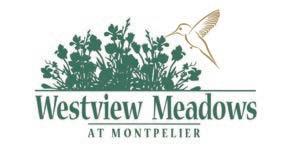
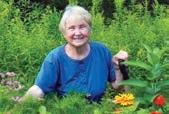





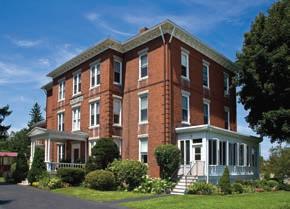





Quarry Hill offers it all: a gracious, maintenance-free home with easy one-floor living and priority access to the fullest spectrum of care.
and priority access to the fullest spectrum of care.
Quarry Hill offers it all: a gracious, maintenance-free home with easy one-floor living and priority access to the fullest spectrum of care.
gracious, maintenance-free home with easy one-floor living and priority access to the fullest spectrum of care.
Enjoy all the beauty and cultural sophistication of Camden, Maine and discover your best future.
Enjoy all the beauty and cultural sophistication of Camden, Maine and discover your best future.
Enjoy all the beauty and cultural sophistication of Camden, Maine and discover your best future.
Enjoy all the beauty and cultural sophistication of Camden, Maine and discover your best future.


For Adults 55+
For Adults 55+
Pen Bay Medical Center | A MaineHealth Member
Pen Bay Medical Center | A MaineHealth Member
For Adults 55+
207-921-6116 | quarryhill.org
For Adults 55+



Pen Bay Medical Center | A MaineHealth Member
207-921-6116 | quarryhill.org
Pen Bay Medical Center | A MaineHealth Member




207-921-6116 | quarryhill.org
207-921-6116 | quarryhill.org
| penobscotshores.com
(continued from p. 127)
fair to compare the men’s and women’s games, that UConn wasn’t UCLA.
“I never compared us to UCLA,” he says. “Most people saying that weren’t even alive during that streak. I was. I saw who they played, who they beat, the players they had, the fact that back then the tournament was 32 teams and you win two games at home and go to the Final Four. So don’t say ours isn’t equivalent to what they did. I never said ours was better. We’re separate, but equals.”
Auriemma laughs and says he’s frequently asked if he has a coaching philosophy like Wooden’s famous “pyramid of success.” “Look around my office—you don’t see one, do you?” he says.
Instead, one sees a spacious office with a new biography of Leonardo da Vinci on the desk, a private bathroom the size of his old office, and a credenza with 11 national championship trophies lined up, each draped with the nets cut down in victory. Beyond that, a second-story window provides a view of a gleaming new practice court in this, the Werth Family UConn Basketball Champions Center, a $40 million state-of-the-art facility that opened in 2014 for the men’s and women’s teams. It’s named for the family of Peter Werth, an Auriemma friend and the founder of a genericdrug development company who donated $7 million. In a hall overlooking the court, Rebecca Lobo, now an ESPN analyst, is taping interviews and clowning around with Katie Lou Samuelson, who juggles three basketballs, and Crystal Dangerfield, who walks on her hands.
“Yeah, I do have a pyramid of success, and it’s the same one as Coach Wooden,” continues Auriemma, impishly. “His was Kareem, Bill Walton, Jamaal Wilkes, Walt Hazzard, Gail Goodrich. And my pyramid is Sue [Bird] and Dee [Diana Taurasi] and Maya [Moore] and Stewie [Breanna Stewart] and Tina Charles and Rebecca Lobo.”
But even if great players make great coaches, coaches don’t automatically win with great players. “Talent, as much as you need it and can’t be successful without it, is also the great killer of most teams,” says Auriemma. “Teams that have a lot of talent can squander it, abuse it, don’t know how to incorporate it into a team atmosphere.”
That, says Auriemma, is what UConn’s fans have grown to appreciate, as much as the winning. He constantly reminds his players when they take the court that it’s about how they play the game.
“Do you think the person driving up from Danbury or Fairfield is driving to Gampel and the conversation is, ‘So, whaddya think—are our girls gonna win tonight?’ No. The conversation they’re having is, ‘I can’t wait to see them play.’ Guess what? I’m the same way. With our best teams, I go to practice and games saying, ‘I can’t wait to see what they’re gonna do.’ We have to play in a way that inspires people and makes them appreciate the game itself.’’
Spring 2017. Once again, March Madness has descended on Storrs. Fans pile into Gampel, their faces painted blue and white. Five male students have painted their bare chests to spell out U-C-O-N-N. A grown man wears a basketball on his head.
The UConn women play sloppily at the start of their first-round game against the University of Albany. Auriemma shakes his head and sits down next to Dailey. (“Geno’s mad,” says one fan. “He sits when he’s mad.”) Following a timeout in which Auriemma gesticulates wildly, the players become a defensive whirlwind: arms and legs flying as they block shots, deny passing lanes, and create turnovers, then fly down the court. Gabby Williams scores on a nice backdoor cut, and Katie Lou Samuelson, she of the pretty jump shot who Auriemma harangues about her defense, takes a charge and bounces back up. Auriemma nods and claps. (“Work on things you’re not good at,” he constantly tells his players.)
“We love Geno,” says Caryn Golden, who sits a few rows behind the bench with her husband, Joe. “If he wasn’t a coach, he’d be a psychologist.”
Golden began following the team when Jen Rizzotti, a local girl from New Fairfield High School, went to UConn. She became the starting point guard on the Huskies’ first national championship team, in 1995, and Golden and her husband became seasonticket holders, starting in the nosebleed section and working their way down to courtside. Surveying the sea of gray hair around her, she jokes, “It’s like going down to Florida, isn’t it?”
An inspirational speaker and author of such books as Tao of the Defiant Woman , Golden says the Huskies have built a multigenerational following that speaks to breaking glass ceilings. When she was in high school on Long Island in the 1950s, girls’ teams were limited to half-court games “because women weren’t supposed to exert themselves— you can’t do this because you’re a girl.” Now 73, with a defiant streak of red in her silver hair, Golden says older fans look upon the UConn women as their granddaughters, who can achieve whatever they set their minds to.
“I use them in my work to show how women have grown from the women’s movement of the sixties to where we are today,” she says. “I explain how hard my generation worked to bring about feminism, and how we don’t want to slide back.”
She points at the court. “Look out there. You see a team of ethnically diverse kids, a team of mutual respect, working together. The people in the stands have to adopt every kid from every ethnicity. There’s so much happening here beyond the game itself.”
Nearby, lawyer and accountant Joseph Hurley is a human stat machine. As the Huskies widen their lead, he can tell you that they have won 24 straight NCAA tournament openers and haven’t lost back-to-back games in 882 games. Hurley will never forget his first Final Four—one of six he has attended—in Philadelphia in 2000.
“I was living in New Jersey, and I traded the use of my townhouse
The best walk-in tub just got better with breakthrough technology! Presenting the all new Safe Step Walk-In Tub featuring MicroSoothe.® An air system so revolutionary, it oxygenates, softens and exfoliates skin, turning your bath into a spa-like experience. Constructed and built right here in America for safety and durability from the ground up, and with more standard features than any other tub.
✓ Heated seat providing warmth from beginning to end


✓ Carefully engineered hydro-massage jets strategically placed to target sore muscles and joints




✓ High-quality tub complete with a comprehensive lifetime warranty on the entire tub




✓ Top-of-the-line installation and service, all included at one low, affordable price















You’ll agree – there just isn’t a better, more affordable walk-in tub on the market.

for tickets,” he says. “In the finals, we backdoored Tennessee to death. The final score was 71–52. After the game, word spread about which hotel the party was at. Then we waited until 12:30, and Geno and the players came in, and we got to see the Waterford crystal trophy.”
When the Huskies open up a 44–18 lead, Hurley texts his parents, who are vacationing in Hawaii: OK mom, you can relax . His mother, a retired UConn chemistry professor who taught current assistant coach Shea Ralph when she was the star of that 2000 championship game, has a theory based on probability and the law of averages that UConn will not lose once it gets a 25-point lead.
In the next game, UConn blows out a strong Syracuse team they had beaten in last season’s national championship game. The Huskies play so unselfishly that they score 31 baskets on 30 assists in the first three quarters. The joy on the faces of Samuelson and hotshooting Kia Nurse as they laugh and shake their heads in wonder belies the program’s assembly-line reputation.
In the stands, former star Morgan Tuck, who graduated in 2016, signs autographs on a night off from playing for the WNBA’s Connecticut Sun.
“You don’t think about it when you’re playing, but then you come back and talk to the fans and you see what it means,” says Tuck. “It’s empowering to all the women who came before us and allowed us to be where we are today. It’s fun, not pressure. There’s a family feel. It sparks young girls, shows them that role models don’t have to be men.”
Samuelson, a California girl, could have followed her two sisters to Stanford, but opted for snowy Storrs. She had seen the blue-and-white machine from the outside; once she visited and hung out with the players in their campus apartments, she was won over. “There was a family feeling, and that surprised me, the way they all stuck together,” she says. After the games, “parents will come up to you with their daughters, girls who wear their hair in a bun like me.”
Adds fellow All-American Napheesa Collier, “There may be an
intimidating aura from the outside, but we’re just a bunch of teenage girls having a good time.”
A few weeks later, when the Huskies plays poorly and loses to Mississippi State in the Final Four on a last-second shot, Auriemma just shakes his head and smiles.
“They’ve sent a lot of kids to the locker room feeling the way they’re feeling,” he says of his players after that game. “Now they’re part of what a normal college experience is. And I reminded them, ‘This is not normal, what we’ve been doing. This doesn’t happen in real life. And what you’re experiencing now, this is real life.’”
Caryn Golden starts receiving text messages offering condolences from friends the next morning. “They thought I was devastated,” says Golden. “But there was no need for morning prayers. In the eyes of many, the season was a failure, which was absurd. OK, this happened. Now it’s on to the next season.”
Next season is here. For Esther MacSwan, Louise Butts, and the rest of Chris’s Kids, watching the exhibition game against Ashland is a chance to see how the new players will blend in.
Chris’s Kids send birthday cards to players, as well as get-well cards when they’re injured. When the women’s games were on public television, they answered the phones during pledge drives. When Chris Dailey visited Covenant Village, she used a 100-year-old resident to demonstrate the pick-and-roll.
At halftime, the Tolland fifthand sixth-grade travel teams take the Gampel court for an intrasquad scrimmage. The players scamper up and down the court, legs pumping, arms straining, struggling to put up a shot that will reach the basket. A girl with a ponytail leans in and scores on a short jumper, the only basket of the game-within-the-game. Afterward, the girls come off the court, screaming with joy. In the hallway under the stands, they all shriek and jump up
and down together. “A-mazing!” two girls shout.
“They’re playing on their court, sitting on their bench,” says one of their coaches, Kristyn Leary.
The mother of two, including a 10-year-old daughter who plays on the team, Leary says that when she was in school in Tolland, the only basketball available to girls was through the town’s recreation programs. Still, she loved the game, and admired UConn stars Rebecca Lobo and Jen Rizzotti. She went to Auriemma’s summer camp at Gampel and had UConn parties in her living room, she and her friends painting their faces blue. As the Huskies grew more successful, grass-roots programs for girls flourished in Connecticut. Leary went on to play at Eastern Connecticut State University and later was an assistant coach there.
Ashley Buckingham, 11, the ponytailed girl who made the basket for her Tolland team, is flushed with excitement as she sits in the stands. Her favorite player is Katie Lou Samuelson, “but I can’t wear my hair in a bun like hers—I’m afraid it would fall out.” Beside her, teammate Keira Hill, also 11, says she doesn’t have a favorite player but loves Geno. “His quotes are inspirational,” she says.
Ashley says that when she was leaving for the game, her brother said he wished they had tickets to the men’s game. “I said, ‘Well, the women are pretty good.’”
“I’ll take his ticket,” says Keira.
“I want to play for UConn,” says Ashley. “We could play here one day. That would be great.”
When they finish, Leary jokes, “Your first interview, girls. You’re on your way!”
As of press time, the No. 1–ranked UConn women had won their first 14 games, most recently topping East Carolina by 61 points. Still, Coach Auriemma said, “We’ve got a lot of work to do.” This year’s women’s Final Four is March 30 and April 1 in Columbus, Ohio. We’re betting on a celebration in Storrs shortly afterward.—Eds.
To















please call Steve Hall at 800-736-1100, ext. 320















EnergAire continuously puri es up to 4,000 cubic feet (a large room) of air and makes it breathable and invigorating. Restores natural ion balance to unhealthy environments caused by industrial pollution, automobile exhaust, central airconditioning, and heating, smoke, dust, pollen, animal fur. . . removes microscopic pollution particles not removed by any other method of air puri cation. EnergAire was rated Number One for speed of removal of cigarette smoke by the leading U.S. consumer protection magazine. It has no noisy fan, no costly lter, and requires no maintenance. Uses less than 2 watts. 9" high. 3" diameter. Weighs less than 1 pound. $69.95
RODAR is the super-powerful professional ultrasonic pest repeller with up to 60 or more times the power of other devices — and power is what makes RODAR so e ective. RODAR ultrasound equals a jet engine — noise unbearable to pests but at frequencies humans and pets cannot hear. RODAR units are completely safe. RODAR drives pests out and keeps them from getting in. Handsome simulated walnut cabinet 5-5/8" high. Weight 1-1/2 pounds. Uses less than 5 watts. $99.95




Mortise & Tenon Red Cedar Quality Wood Shutters

Exterior & Interior Real Wood Shutters

Traditional Moveable & Fixed Louvers
Raised Panels
Arches
• Endless Cutouts
• Board & Battens
• All Sizes
Sladust®
The Original All Wool Dry Mop For Over 109 Years

Full Painting
• Authentic Hardware
• Family Owned Made
Shipped Nationwide
203-245-2608
Shuttercraft.com
Showroom: Mon.–Fri. 9-5 15 Orchard Park Madison, CT 06443



Allow us to ship a gift box of live lobsters, crabmeat, scallops, and other items of your choice to someone special. Your customized order will be hand-selected from only the finest seafood Maine has to offer. Shipping year-round. Gift Cards available too!
To advertise please call Steve Hall at 800-736-1100, ext. 320 Visit our Web site trentonbridgelobster.com




Handmade in Vermont, this pure Wool Dust Mop is the ecological alternative to disposable chemically-laced pads. The swivel head provides maneuverability for easy cleaning. The new durable Velcro backing allows for quick & easy removal of the dust head from the 12" frame for laundering. With 48" wooden handle. Dusting area measures 11"x18". $34.95 (plus $4.95 S&H use coupon YM18). Prices good until December 31, 2019.
Shop online: sladust.com
Sladust - PO Box 624 - Woodstock, VT 05091 802-779-2541

Reclaimed Red Cedar Timbers
Great for Pergolas & Arbors
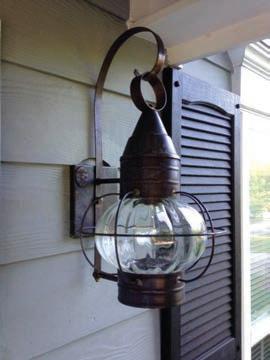
Custom Sizes up to 12x16"x20' + always Buying/Selling vintage millstones MannLumber.com 978.249.2206
Issue:
August 2013
Please check your proof carefully. Approval must be returned by _______________________


Trenton Bridge Lobster Pound® 1237 Bar Harbor Road, Trenton, ME 04605 207-667-2977 Fax 207-667-3412

Publisher is not responsible for errors once proof has been signed— or if not returned by the above date. Please note that color proof/pdf is to show color break only. Colors do not accurately represent actual printed advertisement as it will appear in the publication.
If we have made any errors, mark them clearly.________________________________________________________


Brigger chairs, rockers, recliners, and sofas come in standard and custom sizes. Many have become favorite companions for reading, watching, and relaxing. We have helped many customers with back problems or health and age-related sitting issues. Call to






































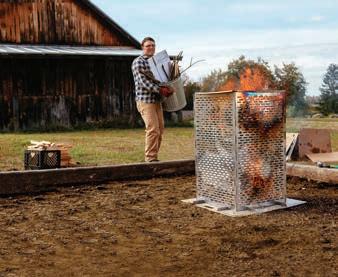




To advertise please call Steve Hall at 800-736-1100, ext. 320


603-465-7270 rmrrestorations.com 269 Proctor Hill Road • Hollis, NH 03049 RESTORATION SPECIALISTS Specializing in Restoring Your Classic Have you been thinking about restoring your classic? Why wait? Give us a call today! No job too big or small. Free Tours



Our beautiful,easy access styles keep loved ones warm & comfortable while being treated or immobile.


SUBSCRIBER ALERT




















































Remembering a legendary conservationist’s favorite spot on the planet.
ixty years ago, Olga Huckins of Duxbury, Massachusetts, sent a letter to a friend describing the state’s aerial spraying of DDT on her property. Furious and frightened by the dead songbirds she’d seen afterward, Huckins thought her friend could help raise the alarm about this “spraying of poisons from the air.”
The friend was writer and biologist Rachel Carson, and the letter would ultimately spark Carson’s 1962 book, Silent Spring. A passionate warning about the long-term dangers of pesticides such as DDT, Silent Spring was more than just a best-seller: It also became the most influential environmental book of the 20th century.

That Carson’s landmark work has this link to coastal New England is fitting. Though she was born in Pennsylvania and lived much of her adult life near Washington, D.C., the ocean had Carson in its thrall from her first visit to Woods Hole, Massachusetts, where she worked at the Marine Biological Laboratory and later the U.S. Fisheries station. Today in Woods Hole, a bronze statue of Carson graces the waterfront, eyes forever fixed on the sea.
It was in Maine, however, where Carson found her heart’s home. In 1953 she built a long-dreamed-of summer cottage on a “perfectly magnificent piece of Maine shoreline” on Southport Island. Calling it Silverledges, Carson could look out from its picture windows and see seals and even whales in the Sheepscot River estuary; below the cottage were the tidal pools she loved exploring with her grandnephew, Roger.
Though she had just 11 summers at Silverledges before succumbing to cancer at age 56, Carson left a lasting mark on her adopted home state. Memorials bearing her name include a coastal greenway stretching 20 miles along the Sheepscot; a 78-acre salt pond preserve in New Harbor, where she researched her 1955 book The Edge of the Sea ; and a national wildlife refuge that protects some 7,600 acres between Kittery and Cape Elizabeth.
And on Southport Island, at the end of a certain rocky trail to the water’s edge, there is a simple bronze plaque marking where Carson’s ashes were scattered—this “writer, ecologist, and champion of the natural world … here at last returned to the sea.” —Jenn
Johnson /// Calling All Foodies!

From Greensboro, Vermont, to Little Compton, Rhode Island, take a delicious and surprising tour of New England’s best food towns.



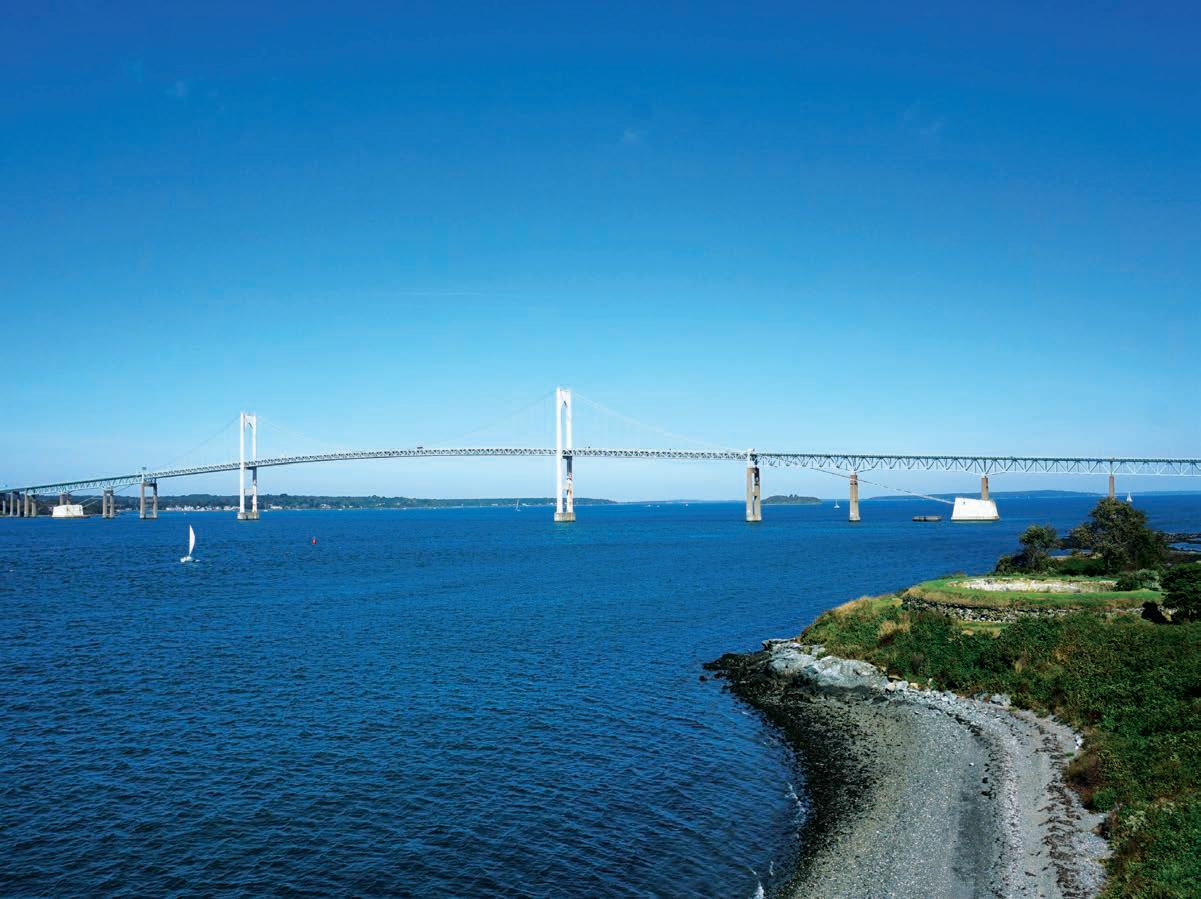
/// Cooking with Yankee
Dig into our absolutely mouthwatering cheddar-ale dip.
/// In Season







Spring has sprung, and we’re serving up some of our favorite goat cheese recipes to celebrate.
/// Perfect Weekend
Get a jump on lake season with a visit to the Winnipesaukee side of Wolfeboro, New Hampshire.
/// #MyNewEngland
Check out the season’s best photographs from our Instagram community.

